

The most epic and legendary climbs of the Tour de France.
Climb list: legendary climbs of the tour de france (sort by distance, difficulty, elevation and more), statistics: view tutorial, total climbs: 116, top 100 world: 1, avg. fiets (top 5) : 12.8, sort by attribute:, zoom/pan map to discover additional climbs., pjamm trips adventure starter bundles, member comments.
TOP 10 MOST FREQUENT CLIMBS OF THE TOUR DE FRANCE
10 FAMOUS TOUR DE FRANCE CLIMBS
See bottom of this page for list of all climbs included on this Legendary TdF Page.
© PJAMMCycing.com
HISTORICAL TOUR DE FRANCE FACTS OF INTEREST
- Climb Most Often Featured in the Tour: Tourmalet - 84 times as of 2021
From Campan: 16.9 km gaining 1267m at 7.5% average grade.
From Luz Saint Sauveur: 18.7 km gaining 1319m at 7.1%.
- Highest Point Ever Reached in the Tour de France: Cime de la Bonette
Cime de la Bonette is 2,802 meters.
Stage 18 1962 (passed again in 1964, 1993 and 2008).
Top 5 high points of the Tour de France
Also see Top 10 Highest Points of the TdF
- Highest point of first TdF (1903): Col de la République (1,161m).
- First Mountain Stage and climbs in the Tour de France:
- Stage 10 July 21, 1910 - Luchon to Bayonne
- 326 kilometers
- Circle of Death: Col de Peyresourde, Col d’Aspin, Col du Tourmalet and Col d’Aubisque
- On arriving at the top of Col d’Aubisque Octave Lapize (TdF 1910 winner) yelled to tour organizers what is variously reported as “murderers,” “assasins,” or “criminals.” He also said he would quit the tour after descending to Laruns, but he rallied to complete the stage and go on to win the 1910 Tour de France.
Circle of Death
Tourmalet was the highest point the tour had ever reached as of 1910 (2115m)
Previous high point had been Col de Porte (1326m).
- First mountain-top stage finish : Alpe d’Huez (Dutch Mountain / The Alpe) was the first mountain-top finish in the history of the Tour de France in 1952, Stage 10.
- Most TdF Wins:
- 5 Jacques Anquetil (1957, 1961-1964)
- 5 Eddy Merckx (1969-1972, 1974)
- Merckx has the most Grand Tour wins of anyone (11 - 5 TdF, 5 Giro, 1 Vuelta)
- 5 Bernard Hinault (1978-1979, 1981-1982, 1985)
- Has the second most Grand Tour wins (10 - 5 TdF, 3 Giro, 2 Vuelta)
- 5 Miguel Indurain (1991-1995)
- 4 Chris Froome : (2013, 2015-2017)
- Most Days Wearing the Yellow Jersey:
- 111 (Eddy Merckx)
- 79 (Bernard Hinault)
- 60 (Miguel Indurain)
- Most Stage Wins:
- 34 (Eddy Merckx)
- 30 ( Mark Cavendish )
- 28 (Bernard Hinault)
- Most Stage Wins in a Single Tour:
- 8 ( Charles Pélissier , 1930)
- 8 ( Merckx 1970, 1971)
- 8 (Freddy Maertens 1975)
- Most Times Atop the Podium (top three TdF finish):
- Raymond Poulidor (8)
- Country Wearing the Yellow Jersey Most:
- France (709)
- Belgium (434)
Frenchmen have been in the maillot jaune far more than any other country.
- Winning TdF in First Appearance:
- 11 between 1903 - 1983 but none since Laurent Fignon (1983), until 2020 and Tadej Pogačar
- Youngest Winner of the Tour:
- Henri Cornet (France, age 19) 1904
- Tadej Pogačar (Slovenia, age 21) 2020
- Oldest TdF Winner:
- Firmin Lambot (Belgium, age 36) 1922
- Most TdF Appearances:
- 18 Sylvain Chavenel (2001-2018 age 42; top finish 19 2009)
- King of the Mountains : Mountain Classification victories (first recognized in 1933; jersey introduced 1975)
“Symbol of the mountains, of a rider pushing beyond their limits and of courage, the red polka dot jersey, which is sponsored by Carrefour, is awarded to the Tour de France’s leader of the best climber classification. Although this classification was introduced in 1933, its symbol, the polka dot jersey, appeared in 1975, which was also the year the Tour first finished on the Champs-Élysées and was won by Bernard Thévenet. It owes its appearance to track racing specialist Henri Lemoine, who competed between the 1930s and 1950s, and that Félix Lévitan, co-director of the Tour with Jacques Goddetwhich, had particularly noticed. While Belgium’s Lucien Van Impe was its first winner and claimed the mountains classification six times, just like his illustrious predecessor, Spain’s Federico Bahamontes, the so-called “Eagle of Toledo”, Frenchman Richard Virenque holds the record for victories with seven titles” ( Tour de France: Polka Dot Jersey ).
- Richard Virenque : 7 - 1994-1997, 1999, 2003, 2004 (best tour finish #2 1997)
- Frederico Bahamontes (six: 1954, 1958, 1959, 1962, 1963, 1964; nine in Grand Tours)
- Triples (none ever in the same year): Frederico Bahamontes and Louis Herrera .
- Doubles same year (TdF+Giro): Fausto Coppi , Charly Gaul , Lucien Van Impe , Claudio Chaippucci
King of the Mountains is designated by the red polka dot jersey.
- Most Green Jerseys (total points):
- 7 ( Peter Sagan )
- Most White Jerseys (best young rider):
- 3 - Jan Ullrich (1996-1998),
- 3 Andy Schleck (2008-2010)
- Least Finishers:
- Shortest Margin of Victory:
- 8 seconds - Greg Lemond over Laurent Fignon in 1989 (Lemond overcame 50 seconds in the final time trial using aero bars for the first time in the TdF).
- Greatest Margin of Victory:
- 2h49’21” in 1903 between Maurice Garin and Lucien Pothier .
- Country With Most Wins:
- France (36)
- Belgium (18)
- Britain (6)
- Luxembourg (5)
THE 5 MOST LEGENDARY CLIMBS OF THE TOUR DE FRANCE
#1: ALPE D’HUEZ
Alpe d’Huez Elevation Profile .
77.5% of the entire climb is at 5-10% average grade.
Steepest kilometer is 10.7%.
Alpe d’Huez is the most famous bike climb in the world and has been included in the Tour de France 30 times between 1952 and the 2022 TdF.
Ride 14 km gaining 1081m at 7.7% to 1801m
Photo clockwise from top left:
Start; Turn 21 (first turn); Turn 1 (last turn); finish; Turn 1 (center).
21 most famous hairpins in the world - 11.4 km at 8.4%.
Turn seven is the most famous of the Alpe d’Huez hairpins: Dutch Corner.
Dutch Corner is where cycling fans from the Netherlands congregate on the day the Tour de France comes to Alpe d’Huez for its inevitable exciting mountain top finish. On this day and at this hairpin, the air is filled with loud European music, the smell of barbeque, and sounds of some of the greatest cycling fans in the world. The tradition originates with Joop Zoetemeik who in 1976 became the first Dutchman to win the Alpe d’Huez stage. Thereafter, Dutch riders won the next seven of twelve Alpe d’Huez finishes, but have not done so since Gert-Jan Theunisse in 1989 (Joop Zoetemelk 1976, 1979; Hennie Kuiper 1977, 1978; Peter Winnen 1981, 1983; Steven Rooks 1988 and Gert-Jan Theunisse 1989).
Bernard Hinault sealed his 5th Tour victory on Alpe d’Huez 1985
Photo: Bloomsburysports.com
Alpe d’Huez has become “the summit of the modern era,” and no other stage of the Tour de France has such presence. With its 21 bends, steep ramps, and massive crowds, it has become the “Hollywood climb,” according to the ride’s official historian, Jacques Augendre. Each year that this climb is included in the TdF, thousands of spectators flock to the area. The massive crowds create what some participants in the ride have described as a feeling of both fear and exhilaration, and as French journalist Philippe Brunel described the look of the road during Marco Pantani’s victorious ascent in the 1995 race, “that thin ribbon of burning asphalt, covered in graffiti, between two deafening walls of spectators, which threaded between his wheels.” Alpe d’Huez has been included in the Tour de France 29 times between its first appearance in 1952 (including two appearances in 1979 and 2013). Each of the 21 hairpins of this climb has been named after one or more of the winners of the 29 Tour de France stages to finish here. Of note, the first stage up this exceptional climb was fittingly won by the incomparable climber Fausto Coppi . Only three cyclists have won the Alpe d’Huez stage more than once: Marco Pantani (1995, 1997), Gianni Bugno (1990, 1991), and Hennie Kuiper (1977, 1978).
Fausto Coppi became the first stage winner of Alpe d’Huez - stage 10 1952 TdF.
YouTube video of Coppi win
Photo: dw.com - 10 most memorable moments on Alpe d’Huez
Likely the most famous and widely remembered and retold stories of Alpe d’Huez is from 1985 when, after two weeks battling each other, it appeared that Greg Lemond and Bernard Hinault had reached a truce and that Hinault would achieve the glory of his fifth TdF without further challenge by Lemond. As the two rode up Alpe d’Huez, the Frenchman led and Lemond followed directly on his wheel. The two passed through throngs of ecstatic French fans and the path grew more narrow as the two neared the climb finish. In the end, the two embraced and Hinault moved slightly ahead of Lemond for his 26th Stage win, at the time placing him second all-time behind Eddy Merckx (34). Hinault went on to win two more stages in his glorious career and is now third with 28 wins, behind Merckx and Mark Cavendish (30).
The exceptional Italian climber, Marco Pantani, holds three of the five fastest times up Alpe d’Huez, the fastest time is 37’35”.
Marco Pantani near the finish on Alpe d’Huez
photo: Hein Ciere
Alpe d’Huez was the stage for one of the most famous (infamous?) cycling moments of all time. Alpe d’Huez was the final climb of three on Stage 10 July 17, 2001 (Col dd Madeleine, Col du Glandon, Alpe d’Huez). Lance Armstrong had dropped from 5:56 back after stage 7 to 35:43 back after a disastrous stage 8 which saw a freak breakaway won by Erik Dekker (s.t. Alto Gonzalez and Servais Knaven). Armstrong was 20:07 back after Stage 9 and his main rival that year, Jan Ullrich, was at 22:41 going into Stage 10.
Armstrong appeared weak on Col de Madeleine which led Uhllrich and his Team Telekom begin an insane sprint up Col du Glandon, leaving Armstrong barely(?) hanging on to the rear of this lead group. However, just a couple kilometers up Alpe d’Huez and with 11 kilometers remaining, Armstrong surged to the front of the group, passed Uhlrich and then, in a moment of Tour lore, looked back (“ The Look ”) at Uhlrich, fixed his gaze on him momentarily, then put the hammer down and sprinted away (uphill) to victory and his 3rd Tour de France victory of 7. [1]
The Look, Alpe d’Huez Stage 10: 2001 Tour de France
Photo from J Barber and F Ruggeri as published in Masculine Heart
#2: COL DU TOURMALET
From Luz Saint-Sauveur - 18.7 km gaining 1319m at 7.1% average grade.
Col du Tourmalet from Luz Saint-Sauveur
PJAMM Gradient Profile
With Alpe d’Huez, Col du Tourmalet is a TdF and world legend. This is the highest pass in the Pyrenees and has been included in the Tour de France a record 84 times between its first appearance in 1910 and 2021. From 1919 to 1939, Tourmalet was included in the TdF every year except 1922, and then only because the tour rerouted due to heavy snow.
2019 featured comments on the official website for the Tour de France:
“It’ll be the third time that a finish is set at the top of the Pyrenean mountain after 1974 (victory of Jean-Pierre Danguillaume) and 2010 (victory of Andy Schleck). The Tourmalet is also to date the mountain that has been climbed the most in the history of the Tour: 82 times” ( Tour de France 2019 ).
Although no other climb has appeared more times in the Tour, Tourmalet has only been the finish three times.
Jean-Pierre Danguillaume won the first stage to finish on Col du Tourmalet (1974).
Photo: deskgram.net
Tourmalet has a rich TdF history that began with its very first appearance in The Tour. The legendary TdF organizer, Henri Desgrance had decided to include Tourmalet in the 1910 tour in what became known as the Circle of Death (Col de Peyresourde, Col d’Aspin, Col du Tourmalet and Col d’Aubisque). The first rider over Col du Tourmalet on July 21, 1910 was eventual 1910 tour winner Frenchman Octave Lapize. Lapize was overtaken on the next climb (Col d’Aubisque). At this time Lapize unleashed on tour organizers as he reached the pass - this is not disputed -- what he said, however, is variously reported as either some or all of the following: “murderers,” “assassins,” and/or “criminals.” Sadly, Lapize was to die seven years later from injuries sustained when his fighter plane was shot down during WWI.
Octave Lapize -- the first rider (hiker?) over Tourmalet, 1910.
Photo: Cycling Passion, Octave Lapize walks over the Col du Tourmalet
The tour was not held from 1940-46 due to WWII. When The Grand Tour reappeared in 1947, so to did Tourmalet. From 1947 to 1955 Tourmalet was featured in the TdF. It wasn’t until 1956 that Tourmalet was left off the Tour’s agenda without excuse; from 1919 to 1957 Tourmalet was included in the Tour every year that it occurred.
One of the most famous stories of Col du Tourmalet and the Tour de France is from 1913. Descending Tourmalet towards Campan, French cyclist Eugène Christophe crashed and broke his front fork. Showing the resilience and spirit of those times (and, lacking any support staff), Christophe walked down the east side of Tourmalet to Campan where he found a forge and amazingly repaired his bike sufficient to ride to the stage finish in Bagnères-de-Luchon. To add insult to injury, on top of already having lost three hours due to the crash, the race organizers penalized him for the “assistance” he was given by a seven year old boy who had pumped the bellows for him while he repaired his bike a blacksmith’s shop in Campan.
Eugène Christophe repairing his bike in Campan, 1913 (Image from Jean Durry ).
YouTube summary of Christophe’s 1913 bad luck.
In 1919, Eugène Christophe became the first man to wear the yellow jersey.
In 2010 Alberto Contador and Andy Schleck battled up the Col du Tourmalet from Luz-Saint-Sauveur for a mountain top finish (the second straight day Tourmalet was featured in the tour and only its second mountain top finish ever). With ten kilometers to go, Schleck and Contador broke from the group and were alone on a fog shrouded ascent to the Col du Tourmalet. With two kilometers to go, the two raced up the mountain side by side in heavy fog and light rain, having tried to break each other multiple times over the past eight kilometers. Schleck led the entire final kilometer and there was no sprint at the finish, Contador conceding the stage to Schleck, but keeping the yellow jersey, both riders finishing with the same 5:03:29.
Andy Schleck edged Alberto Contador TdF 2010 stage 17.
Photo by filip bossuyt .
YouTube segment of Schleck and Contador on Tourmalet.
WHAT’S ON TOP?
“Géant au Col du Tourmalet” -- Paying homage to the “Giants” of the road.
Velopeloton.com writes of the Géant:
“Géant au Col du Tourmalet is an iron sculpture first erected in 2000. It was created by the artist Jean-Bernard Métais, as part of the Tour de France sculpture on the A64 autoroute between Tarbes and Pau. This sculpture features 8 cyclists, Le Géant is the 9th person of the work. Le Géant is installed at the summit on the first Saturday of June each summer. It is a great occasion known as “Montée du Géant” – “Rise of the Giant” and attracts approx 1000 cyclists, who ride up the mountain with Le Géant. Le Géant travels on the back of a truck, accompanied by a brass band. There is a celebrity cyclist each year, with Bernard Hinault and Miguel Indurain among those who have honoured the Giant with their effort. Le Geant is removed at the beginning of October each year for safekeeping from the harsh winter. It is mostly on display in Bagneres de Bigorre, but has spent a couple of winters in Tarbes.”
Géant au Col du Tourmale
Photo: Velopeloton.com
#3: MONT VENTOUX
After Alpe d’Huez, Mont Ventoux is the second most famous of TdF legendary climbs.
Featured 17 times between 1951-2021 (10 summit finishes).
Mont Ventoux Elevation Profile
46% (9.8 km) of the climb is at 5-10% and 21% (4.5 km) at 10-15%.
From Bedoin, the traditional route, ride 21.2 km gaining 1593m to 1909m.
This is the third hardest bike climbs in France and a top world 150.
One of the features of cycling Mont Ventoux that separates it from many of the other exceptional climbs of Europe is that its unique radio tower at the top is visible throughout the climb. At times it seems this tower just refuses to grow any bigger no matter how fast we pedal! SportActive.net explains that this distinctive red and white building, resembling a lighthouse, was built in 1968 and is used as a meteorological station as well as to broadcast television signals.
MONT VENTOUX HAS TAKEN ITS TOLL ON TdF RIDERS LIKE NO OTHER
This climb first appeared in the Tour de France in 1951 when the race crossed, but did not finish, on its summit. The first serious blow the mountain inflicted on riders was in 1955 when Swiss rider Ferdi Küble (winner 1950 TdF) attacked 10 km from the summit and paid for it dearly. Ignoring the searing heat and steep grade, Kübler raced up the mountain only to seize up and have to dismount his bike well before the summit. He eventually made it over the top, but had lost his lead and was a demoralizing 20 minutes behind the leaders. On the descent, Kübler crashed three times but ultimately made it to Avignon where he was observed entering a bar close to the stage finish and pounding down beer after beer. After replenishing in the bar, Kübler mounted his bike and headed out in the opposite direction from the finish. That evening, Kübler called a press conference and retired on the spot - Ventoux had vanquished him ( Fotheringham, William, put me back on my Bike, in Search of Tom Simpson , Yellow Jersey Press, 2007, p. 199).
Ferdi Kübler on Mont Ventoux 1955
Photo: Cycling Passion, Ferdi Kübler climbing Mont Ventoux, Tour de France 1955
Another great rider had been crushed by Venoux on on the 1955 stage - Frenchman Jean Malléjac (second in 1953 and ninth overall on this day) keeled over on Ventoux, semi comatose and turning one pedal as he lay on the ground - he was never to race again. Half a dozen other riders collapsed in the Ventoux furnace that day (Fotheringham, p. 199-200).
Jean Malléjac on Ventoux 1955;
Photo Rouleur, Tour de France 21 Stories: Vicious Venoux
And then there was 1967 and one of the greatest tragedies to occur during the Grand Tour. On July 13, 1967, during the tenth stage of the Tour de France, Tom Simpson, known as the charming “Mister Tom” and leader of the British team, had become ill (later his illness was traced to the substances of the day) but he pressed on, ultimately weaving desperately and collapsing on Ventoux. The team mechanic, Harry Hall, pressed Simpson to stop, but he insisted on continuing, famously stating, “Me straps, Harry, me straps!" and his manager Alec Taylor acquiesced (Fotheringham, 2007, pp. 34-35). He did not utter the more famous phrase, “put me back on my bike” - those were invented by an overzealous journalist. Sadly, Mister Tom’s final turns of the pedal were over the next 500 meters and he soon collapsed and could not be resuscitated by Tour doctor Pierre Dumas, the same physician who had tended to Jean Malléjac on Mont Ventoux 12 years earlier.
Tom Simpson, Mont Ventoux, July 13, 1967
Photo: Sport Vintage
There is a memorial honoring the great British rider Tom Simpson 0.7 miles from the summit of Mont Ventoux -- this is the location where he perished at age 29 during the thirteenth stage of the 1967 Tour de France.
Tom Simpson Memorial
First erected 1969 and re-erected 2014
The Tour de France included Mont Ventoux in 16 stages between 1951 and 2016, and it has been the finish on 10 of those, most recently in 2016 (as of 2020). “Mont Ventoux has become legendary as the scene of one of the most grueling climbs in the Tour de France bicycle race, which has ascended the mountain fifteen times since 1951. The followed trail mostly passes through Bédoin. Its fame as a scene of great Tour dramas has made it a magnet for cyclists around the world” ( Wikipedia ).
Charly Gaul Stage 18 1958
Photo: Cycling Passion - Charly Gaul on Mont Ventoux Tour de France 1958
The “Angel of the Mountains,” diminutive Charly Gaul raced up crushed the Stage 18 Mont Ventoux time trial in 1958, sealing his only Tour de France victory. His record time of 1:02:09 over poor roads and in the hot sun stood for 31 years until taken by American Jonathan Vaughters of the US Postal team. The current record is 55:51 set in 2004 by Spain's Iban Mayo
#4: COL DU GALIBIER
Col du Galibier
From Valloire: Ride 17.4 km gaining 1199m at 6.9% average grade.
From Col du Lautaret: 8.6 km gaining 569m at 6.7%.
PJAMM Cycling’s Col du Galibier from Valloire Gradient Profile
72% (12.5 km) of the climb is at 5-10%.
Col du Galibier was the highest point ever reached by the Tour when featured in 1911 (2556m)
The Tour did not go higher until Col de l'Iseran in 1939 (2770m).
Finish and Tour markings at the Col du Galibier
Bartali handing Coppi a water bottle on the Galibier in the 1952 TdF,
Or Coppi sending it back to Bartali -- the debate rages . . .
Photo: iconicphotos.com
Included in the Tour 63 times from 1911 through 2022 Galibier was passed as the highest point in the Tour each year from 1911-1914 (suspended 1915-1918 WWI) and 1919-1937. In all Col du Galibier has been the highest point in any individual TdF significantly more times than any other climb (50; Col de L’Iseran is second with 8).
Haute Route quotes Henri Desgrange in his praise of this climb:
The Galibier became a legend at the very first time it was used by the Tour de France, in 1911. This is how Henri Desgrange, creator of the Tour de France, introduced it to his readers: “Oh! Sappey! Oh! Laffrey! Oh! Col Bayard! Oh! Tourmalet! I will not fail in my duty in proclaiming that next to the Galibier you are as weak as dishwater: before this giant there’s nothing one can do but doff one’s hat and bow down low” (translation by Marvin Faure) ( Hauteroute.org - Col du Galibier ).
When first crossed in 1911 by the Tour de France, no tour rider had ever ridden higher. Although the Galibier route until 1976 tools the tunnel at 2,556 meters. From 1976, the Tour has gone over the pass at the top which is 2,642 meters.
Andy Schleck, Stage 18 of the 2011 Tour de France.
Col du Galibier -- highest mountain top finish ever.
Photo: roadbikereview.com
As with many of the challenging and beautiful climbs of France, Galibier is fabulously famous because it has been justifiably blessed by the Tour de France on many occasions (35 times since its first post WWII appearance in 1947, which was the first TdF since 1940). Most recently (as of 2020) Galibier was featured in The Tour in 2019 ( Nairo Quintana won the stage from Embrun to Valloire). In 2017 debutante Primoz Roglic became the first Slovenian to win a TdF stage when he came out on top in Stage 17 from La Mure to Serre-Chevalier.
Primoz Roglic, Stage 17 Tour de France.
First Slovenian to win a TdF stage.
Photo: Cyclingtips.com
Of Galibier and the Tour de France, Wikipedia writes:
The Col du Galibier was first used in the Tour de France in 1911; the first rider over the summit was Emile Georget, who, with Paul Duboc and Gustave Garrigou were the only riders not to walk.
Emile Georget, Col du Galibier, 1911
Photo: Emile Georget
The original summit was at 2556 m; while the tunnel was closed from 1976 until 2002, the tour route went only over the pass closer to the mountain peak at 2645 m. In 2011, the Tour de France went through the tunnel for the first time during the 19th stage from Modane Valfréjus to L'Alpe d'Huez. At the south portal of the tunnel, at the edge of the road, there is a monument to Henri Desgrange, instigator and first director of the Tour de France. The memorial was inaugurated when the tour passed on 19 July 1949. Whenever the tour crosses the Col du Galibier, a wreath is laid on the memorial. The "Souvenir Henri Desgrange" is awarded to the first rider across the summit of the highest mountain in each year's tour. In 2006, the prize of 5,000 euros was claimed on the Col du Galibier by Michael Rasmussen.
Since 1947, the Col de Galibier has been crossed 31 times by the Tour de France. It was scheduled to be used in 1996, but was left out at the last minute due to bad weather. As a result of snow on both the Col de l'Iseran and the Col du Galibier, the scheduled 190 km stage from Val-d'Isère to Sestriere in Italy was reduced to a 46 km sprint from Le-Monetier-les-Bains which was claimed by Bjarne Riis, resulting in him taking the yellow jersey which he retained to the finish in Paris. In the 2008 Tour, the Col du Galibier had been crossed on 23 July in the 210 km stage 17 from Embrun to Alpe d'Huez. The 2011 Tour climbed the Col du Galibier twice to celebrate the 100th anniversary of the first appearance of the pass in the Tour de France, including the first ever summit finish, won by Andy Schleck after a 60 km solo breakaway. This was the highest ever stage finish in the Tour de France. It was scheduled to be used again in stage 20 of the 2015 Tour, but was left out nine days before the race start due to landslides in the Chambon Tunnel, situated towards the bottom of the descent of the climb.”
The Telegraphe, and Galibier, are the scene of the greatest racing day in the life of Marco Pantani . It was here and in this Stage 15 of the 1998 TdF that Pantini attacked on the Galibier and ultimately turned a three minute deficit into an 11 minute lead against Jan Ullrich. Pantini went on to win the Tour de France that year.
Pantani attacks 4.2 km from Galibier summit.
Photo: Cycling-passion.com
#5: COL D'AUBISQUE
CLIMB 1 (CAT __) - COL D'AUBISQUE
PJAMM CYCLING INTERACTIVE PROFILE TOOL
16.7 km, 1193m at 7.1%
The incomparable Col d’Aubisque - included in the first ever mountain stage of the Tour de France in 1910 - Stage 10’s four mountain climbs over the 326 kilometer course (Col de Peyresourde, Col d’Aspin, Col du Tourmalet and, finally Col d’Aubisque) were coined The Circle of Death. It was also on the Aubisque that eventual 1910 TdF winner Octave Lapize uttered his famous comments to tour organizers - variously reported at “murderers,” “assassins,” or “criminals.”
Col d’Aubisque (and Col d’Aspin) has appeared in the Tour de France 73 times between 1910 and 2022, more than any other climb other than Col du Tourmalet with 88 appearances.
Stage 10 TdF 1911 [2]
Photo: bikeraceinfo.com (an exceptional resource for all Grand Tours).
We rode this route in 2011 and 2018 . . . guess what . . . still the same. 👍
Same cliff, same mountain, same tunnel (as pictured above) over 100 years later.
Aubisque is our choice for Top TdF Nostalgic Climb.
The descent from Eaux Bonnes (western approach) towards Col du Soulor was and is a dangerous route - it’s a narrow road with sheer cliffs. On Stage 13, July 17, 1951, this hazardous stretch of road was the scene of one of the most horrific and famous crashes in Tour history. The unlikely leader on this day was the pleasant and good natured Dutchman Wim van Est . This Tour included pure and true cycling legends Gino Bartali, Fausto Coppi, and Louison Bobet, and, while an accomplished pursuit racer, van Est was never expected to compete for the overall classification in the greatest of the Grand Tours. Nonetheless, on July 26, during Stage 12, van Est, who started the day over nine minutes behind leader Roger Levêque, broke away and won the stage, finding himself in the yellow jersey by :02:29.
A deadly road.
However, winning the flat Stage 12 by using his specialty sprint to gain time on the peloton is one thing, but a sprinter holding a slim lead over the Aubisque would be quite another. And so it was that Van Est had lost his lead as he summited the mighty Aubisque and set about to regain some of what he had lost. However, the narrow and windy road descending from Col d’Aubisque towards Col du Soulor is a poor choice for downhill heroics. And so it was that fell and tumbled 70 meters down and nearly sheer mountainside. It was not just the fall that remains in our memories from this day, but the way Van Est was extricated from his predicament and that he was still alive and able to climb up the mountain back to the road under his own power.
Photo: Edwin Seldenthus as published in velopeloton.com .
Here is amazing YouTube footage of the rescue of Wim van Est. He was helped up the mountainside by a chain of tires strung together by spectators and his support team. Still alive and unbelievably without major injury, Van Est insisted on continuing the race, but was convinced by wiser authority to go to the hospital.
Making lemonade out of lemons (or money out of near death?) -- when he flew off the Aubisque cliff, Van Est fortuitously (in hindsight anyway) was wearing a team issued Pontiac wrist watch which became the launching point for Van Est focused advertising campaign with this slogan: “Seventy meters deep I dropped, my heart stood still but my Pontiac never stopped.”
All the greats have raced on the Aubisque
Louison Bobet, Stage 11 1954 TdF (champion 1953-1955)
Photo: bikeraceinfo.com
Full list of every climb ever included in the Tour de France
[1] We all know, but it is necessary to mention here, that Lance Armstrong’s seven tour victories were all stripped due to the use of PEDs.
[2] Note: The cliff and tunnel approach to Col d’Aubisque is from the Argeles Gazost/Arrens side, not Laruns.
Loading Document

- Skiing into Spring
10 legendary mountain passes and climbs
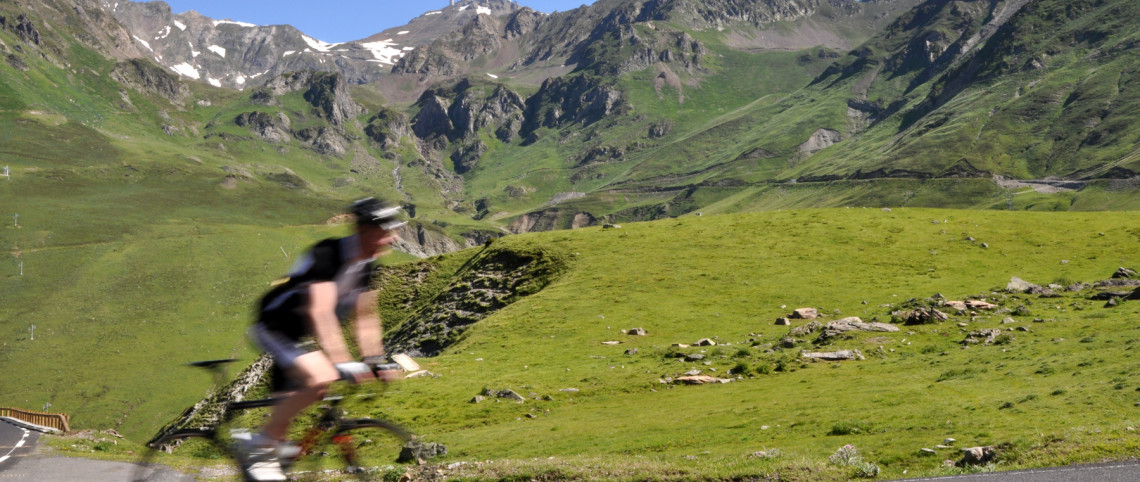
Mise à jour le --> 21.06 2023 --> --> --> --> Discovery
Regularly used by the Tour de France, every summer they attract cyclists from all over the world. However, you’ll need at least some training to follow in the wake of the top cycling champions, but the stunning landscapes revealed along the way make it well worth the effort.
Le Portet d’Aspin (1,489 metres)
Like Tourmalet, le Col d’Aspin is a real classic for the Tour de France, which has climbed it 71 times. Thomas Voeckler was the last to conquer it in the lead, during the 16th stage of the 2012 Tour de France (Pau / Bagnères-de-Luchon), a race he went on to win after leading the day’s four challenges (Aubisque, Tourmalet, Aspin and Peyresourde). The most difficult climb starts at Arreau (12 kilometres at 6.7%). It’s unusual because of the unevenly spaced hardwood trees alongside the road, which zig zags up through picturesque mountain pastures. The climb is more irregular from Sainte-Marie-de-Campan (12 kilometres at 5%) with a harder final section (from the ski resort and Lac de Payolle, at 1,100 metres in altitude).
Le Col du Grand Colombier (1,498 metres)
Despite only featuring in the Tour de France once (in 2012), le Col du Grand Colombier is nonetheless formidable. Its four access routes all represent an almost two-hour climb for the average cyclist: 15.9 kilometres at 7.87% from Artemare; 18.3 kilometres at 6.89% from Culoz; 15.7 kilometres at 7.97% from Anglefort and 19.2 kilometres (at 6.75% on the last 15 kilometres) from Champagne-en-Valromey. This Jura giant – situated on the border of the Savoie department – provides breath-taking views over Lac du Bourget from its summit.

Col de Peyresourde (1,569 metres)
Situated near the ski resort of Peyragudes, le Col de Peyresourde is characterised by the blanket of moss covering the Alpine pastures through which its road snakes. According to the former director of the Tour de France, Jean-Marie Leblanc, “this climb makes you want to lie down and sleep in the grass, next to the sheep and cows”! Climbed 65 times by Tour de France competitors, it offers a 9.9 kilometre stretch on the west side (at an average incline of 6.6%) and 15.3 kilometres on the east side (at an average incline of 6.1%). Beware though, its irregular incline (with 12% stretches on each side) and frequent gusts of wind make this climb a more delicate operation than the numbers alone suggest.
Alpe d’Huez (1,803 metres)
It’s hard to imagine it today, but the first time the Tour de France came to Alpe d’Huez in 1952, only a handful of fans were in attendance. Thereafter, the climb went on to become a highlight of the world’s biggest cycling race. Now some 500,000 people gather along the climb’s 21 numbered hair-pin bends – each road sign featuring the name of an Alpe d’Huez stage winner and the corresponding year of their victory – happily arriving several days in advance to set up. In summer, around 1,000 cyclists (5,000 a day during the week of the Tour) set off every day to tackle the 13.1 kilometre climb, at an average of 8.19%. Internationally, Alpe d’Huez is more famous for its access road’s 21 hair-pin bends than for its 250 kilometres of ski runs!

Le Mont Ventoux (1,912 metres)
Visible for 100 kilometres in all directions, the Mont Ventoux summit appears to be permanently snow-capped, even at the height of summer. This almost lunar look, a consequence of repeated forest fires and deforestation that began back in the Middle Ages, is why it’s been nicknamed “Mont Bald”. Despite only looking slightly more difficult on paper (21.5 kilometres at 7.22%, versus 21.2 kilometres at 7.15%), the climb from Bédoin, on the south side, is unquestionably more famous than that on the north side, from Malaucène. It’s worth noting that 12 of the 15 Tour de France climbs started at Bédoin, compared to 2 on the north side and just 1 on the east side, from Sault. The latter, by far the easiest (25.7 kilometres at 4.5%), joins the Bédoin road at the level of the Reynard chalet, 6 kilometres from the summit.
Le Col de la Croix de Fer (2,067 metres)
It’s not only the average gradient (27.53 kilometres at 4.7% on the Isére side from Verney Dam; 30 kilometres at 5.07% from Saint-Jean-de-Maurienne on the Savoie side) but also its irregularity and length that make La Croix-de-Fer such a difficult climb. Cyclists who gamely attempt this Tour de France classic (which has featured in the event 16 times since 1947) are however rewarded by a succession of stunning landscapes: waterfalls plunging down into the valley, the Grand-Maison Dam, the Aiguilles de l’Argentière on the Isére side; the Aiguilles d’Arves and the Belledonne chain on the climb from Saint-Jean-de-Maurienne.
Le Col du Tourmalet (2,115 metres)
Despite having a name that seems to translate from French as the “bad trip”, this Pyrenean giant remains the most-climbed Col in the history of the Tour de France (79 times). The first time “La Grande Boucle” paid it a visit in 1910, Octave Lapize – who carried out a large part of the climb on foot, pushing his bike – felt entirely justified in labelling its organisers “killers”. Today, the climb will take an average cyclist around two hours to complete, either on its west side (17.2 kilometres at 7.4% from Sainte-Marie-de-Campan, via the resort of La Mongie) or its east side (18.8 kilometres at 7.4% from Luz-Saint-Sauveur, via Barèges).
Le Col de l’Izoard (2,360 metres)
When you think of Izoard, the first thing that comes to mind is the barren scree slopes overlooking the road, which, like Mont Ventoux, give the place a lunar feel. The presence of cargneule peaks (a local sepia-coloured rock) reinforces the austere look of the so-called “Casse Déserte” situated just over 2 kilometres from the Col on the south side. Of the 33 times the Tour de France has been through here, it has been the most-climbed section (15.9 kilometres at 6.9%). In 2011, Andy Schleck, then 4th in the General Classification, launched an attack 60 kilometres from the start, which went on to deliver him first place in the stage. The Col’s north side, from Briançon, offers a 19.2 kilometre climb at an average gradient of 5.92%.
Le Col du Galibier (2,642 metres)
Climbed 58 times, le Col du Galibier numbers among the Tour de France’s “classic climbs”. This year once again it will be the highest summit the peloton passes through, during the Modane – Alpe d’Huez stage. If the south side (8.52 kilometres at 6.9% from le Col du Lautaret) is far from a bed of roses, what can be said about the north side, with 18.1 kilometres at 6.9%, and the most difficult kilometres bunched towards the end? It was on these slopes that Marco Pantani laid the foundations for his final victory in 1998.

Le Col de l’Iseran (2,770 metres)
This Col, which connects the Maurienne and Tarentaise Valleys, prides itself on being the highest Col road in the Alps. Before the road – which opened in 1937 – was built, the Col de l’Iseran the site of so many mysteries and dramas that in Bonneval-sur-Arc (the starting point of the south face climb) it gave rise to the following adage: “If everyone who died on Iseran stood hand in hand, they would stretch from here to Val d’Isère”. Today, the Col de l’Iseran is a prime tourism site. It provides access to Val d’Isère’s summer ski area (on the Pisaillas glacier), and of course two superb cycling climbs: 48 kilometres at 4.1% from Bourg-Saint-Maurice on its north side (including 16 kilometres at 5.8% from Val d’Isère) or 13.4 kilometres at 7.3% from Bonneval-sur-Arc, on the south side.
Col de l'Izoard ©Martin Léger
Col du Galibier ©ASO
Montée du mont Ventoux ©A.S.O
peloton montée au Col du Glandon ©A.S.O
Montée vers l'Alpe d'Huez ©A .S.O
Col de la Croix-de-fer© A.Gros
You might also like these articles
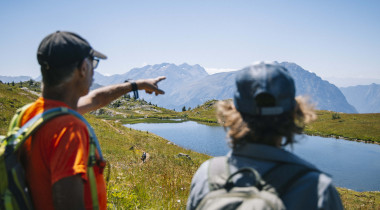
Flocon Vert label: for resorts who are committed to sustainable development in the mountains

10 reasons to head for the mountains of France this winter!
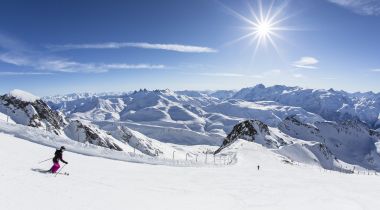
6 legendary ski runs

Tour de France 2023: our selection of the most beautiful mountain stages
Inspiration
Cycling Tourism Nature and Outdoor Activities Sporting Activities Mountains

Reading time: 0 min Published on 4 December 2023, updated on 1 June 2024
The most famous cycle race in the world, the Tour de France will be taking to the skies once again this year, as the 3,404km and 21 stages will take in all 5 of France's mountain ranges! The Pyrenees, the Auvergne volcanoes, the Jura mountains, the Alps and the Vosges massif... The peloton has plenty of pedalling to do and plenty of climbing to do. The grandiose landscapes, the high altitude finishes and the dizzying descents promise to be emotional highs. To experience the highs (and lows) of the Grand Loop, saddle up with our selection of the most beautiful mountain stages.
From Tarbes to Cauterets-Cambasque, the Pyrenees take centre stage

After 3 stages on the Spanish side, welcome to the French Pyrenees! First there's Bayonne and the Basque country, Dax and its thermal baths, Pau and its beautiful castle where King Henry IV was born. And then there's Tarbes, with its breathtaking views of the surrounding mountains, its palm-lined streets (yes, yes!) and its gourmet markets. The riders of the 2023 Tour de France will need a lot of courage to tear themselves away from this gentle way of life and tackle the climbs of the Aspin and terrible Tourmalet cols . The reward for all this climbing is a finish on the Cambasque plateau, overlooking the charming resort of Cauterets, in the heart of the Pyrenees National Park, where the Pic du Midi is enthroned. Want to cool off? Try the hike to the peaceful Lac d'Ilhéou . In a green setting with magnificent views and waterfalls, picnics and swimming...
The Puy de Dôme, a feast for the eyes in Auvergne

The ascent of Puy de Dôme, the undisputed star of the Auvergne, will be one of the highlights of the 2023 Tour de France! The youngest and highest volcano in the Puys chain has not featured on the itinerary for 35 years. Taking on this fearsome and majestic peak and finishing with a 360° view over the gentle rolling hills of the Parc naturel régional des Volcans d'Auvergne is sure to motivate many a rider! But did you know that you can also climb this peaceful giant by mule track or on board the Panoramique des Dômes, a picturesque little cogwheel train? In just 15 minutes, you'll be transported to an altitude of 1,465 m, with the 80 volcanoes of the Puy range and the Limagne fault (listed as a UNESCO World Heritage site at your feet. To complete a stage that's full of fireworks, the Vulcania Park is not far away! Who can beat that?
Breathtaking escapes in the Jura

Expect to fall under the spell of Châtillon-sur-Chalaronne! Just 1 hour from Lyon and the Monts du Beaujolais, this small town in the Ain département, from which the Tour de France 2023 peloton will set off on 14 July, is a delightful medieval town. With its pink stone houses, flower-bedecked bridges and old market hall housing one of France's most popular traditional markets, it is also the gateway to the Dombes region, a paradise for fish farmers and birdwatchers with its landscapes of water and ponds. Take advantage of this area on foot, by boat or, ideally, by bike (it's flat!), before taking to the heights of the Montagnes du Jura , just a stone's throw away. The Pyramide du Bugey, from the top of which you can see Mont Blanc and Lake Geneva, is a must-see. The Tour de France riders attack it via the Col du Grand Colombier. At top speed. Take your time, the panorama is well worth it!
In the Alps, between lakes and legendary passes

It's doubtful that the riders will enjoy the view of Lake Geneva as they take their first pedal to the metal in the Alps at Annemasse on stage 14 of the Tour de France 2023. We recommend this one, though, as well as the view of Lake Annecy and its turquoise waters. Then it's time for a series of twists and turns and climbs to the legendary passes of the Alps, including the famous Col du Feu, an unprecedented climb for the peloton. At an altitude of 1,000 metres, in the heart of the Portes du Soleil ski area, the stage finish in Morzine won't dampen the spirits of those who love nature. In summer, the little village resort in the Alps is an ideal playground for lovers of outdoor activities : a stroll along the Dérêches river, swimming in Lake Montriond, canyoning or via ferrata... the hardest thing will be to choose.
From Gets to Saint-Gervais, Mont Blanc in your sights

For the first time since its creation, the Tour de France will start from Les Gets. Well-known to mountain bikers (the World Championships were held there in 2022), the pretty Alpine resort will kick off a 15th stage during which you'll need to have plenty of breath. The Col de la Forclaz-Montmin is on the programme. So allow yourself a break at its belvedere for a bird's-eye view of Lake Annecy before setting off again for Saint-Gervais, at the foot of Mont-Blanc. If you want to reach the highest peak in the Alps, this village resort, with its well-preserved heritage and traditions, is the ideal place to stop. And its thermal baths, renowned for the many benefits of their waters, set the well-being at the summit in a magnificent green setting.
Courchevel, star of the Alps

The regulars call it Courch' and they come and go summer and winter as connoisseurs, just like the Tour de France caravan which is visiting the Savoyard resort for the 4th time. Welcome to the pinnacle of top-of-the-range skiing in the Alps, at the heart of the Three Valleys ski area. Courchevel tops the list not only for the size of its ski area (Méribel and Val Thorens are its famous neighbours) but also for its range of hotels (no fewer than 5 mountain palaces , from the Apogée to the Cheval Blanc, not forgetting the K2 Palace, Airelles and the Hôtel Barrière Les Neiges) and restaurants. So, with its 6 hamlets and the surrounding area, the resort has a lot to offer. Take a selfie at the top of La Saulire, take a stroll down to Lac de la Rosière, cycle down the Bike Park, spend the night in the Lacs Merlet refuge or hike through the heart of the Vallée des Avals... You're going to love it!
Full steam ahead in the Vosges

Between the Lorraine plateau and the Alsace plain, the Vosges massif lives up to its reputation: a perfect blend of nature, wide open spaces, traditions and local produce, crafts and fine cheeses. Between the Grand Ballon d'Alsace and the Petit Ballon, via the famous Col de la Schlucht, the Tour de France 2023 will be taking a break from the normality of the mountains, with a new finish on the slopes of the Markstein, in the welcoming family resort of Marlstein Fellering. In the heart of the Ballons des Vosges Regional Nature Park , you can enjoy bucolic hikes, tobogganing in the mountain pastures, paragliding with a view, and mountain biking (or mountain bikes) in a landscape of absolute serenity. And for those with a sweet tooth, July is the peak of blueberry season (and the season for tarts in the farm inns).
And (finally) Paris.... and the Olympics!

Will the riders be in Olympic form for the triumphant finish on the Champs-Elysées on 23 July 2023? Just one year ahead of the 2024 Olympics in Paris , the route will certainly provide a magnificent prologue to the sporting event. Starting in Saint-Quentin en Yvelines, all the future Olympic venues in the Yvelines département will be on the peloton's final route. A gigantic loop will join the Colline d'Elancourt (where the mountain bike events will take place), the Golf National in Guyancourt and the Château de Versailles , which will host the equestrian events and part of the modern pentathlon competitions. A prestigious line-up of finishers for a Tour de France 2023 that's sure to be at the top of its game!
Find out more:
More information on the route of the Tour de France 2023 and nearby tourist attractions
5 minutes to find out all about the Tour de France 9 mountain skills to discover

By France.fr
The magazine of the destination unravels an unexpected France that revisits tradition and cultivates creativity. A France far beyond what you can imagine…
Un bain de forêt dans les Vosges, ça vous dit ?
Vosges Mountains

5 unusual activities to unwind in the Alps this summer
summer perched
Alps - Mont Blanc

Discover a beautiful lake at the end of a hike in the Pyrénées
Fresh water

Get in touch with Nouvelle-Aquitaine in South West of France
Biarritz-Basque Country

Loire Valley, Champagne and beyond, The perfect blend
Alsace and Lorraine

Along La Loire à Vélo
Loire Valley

Discovering the most beautiful beaches of the Pays de la Loire, by Natigana
#ExploreFrance
Atlantic Loire Valley

Cycling in Hauts-De-France
Northern France


Jorgenson and INEOS Crack Roglič | Critérium du Dauphiné Stage 8 2024
- Uncategorized

Remco Evenepoel Cracks Early on Samoëns 1600 | Critérium du Dauphiné 2024 Stage 7
- Race Recaps

Primož Roglič Returns with Big Watts on Allevard | Critérium du Dauphiné Stage 6 2024

French Climbing Superstars Perform On Chamrousse | Alpes Gresivaudan Classic 2024
- wout van aert
- WorldTour Ranking
- WorldTour Calendar
- world tour relegation
- women cycling power
- watts analysis
- warren barguil
The Ultimate Guide to the Tour de France 2022 King of the Mountains Competition

The mountains classification is always a great attraction of the Tour de France, especially when the fight for the general classification is not entertaining or exciting deep into the race. In this article, we will take a closer look at 2022 edition’s scoring system, the tactics for winning it and who are the favourites.
This year’s route is quite mountainous, with mythical passes such as Galibier, Alpe d’Huez or Hautacam. In this article , we analysed all these climbs featuring in the 2022 Tour de France, including projected climbing times and watts. In total, there will be:
- 61 categorised climbs;
- 7 Hors Catégorie climbs;
- 10 category 1 climbs;
- 6 category 2 climbs;
- 16 category 3 climbs; and
- 22 category 4 climbs,
for 985 available points.
Logically, the Hors Catégorie climbs are the most important, with a big difference over the rest. Not only does the first rider score twice as much as a first category climb, but there are points up to the eighth position, as you can see in the following graph.

Moreover, according to the rules, “in the event of two riders being equal on points in the best climber classification, the rider with the most first places at the summit of Hors Catégorie passes or climbs or summit finishes will be declared the winner”.
If a rider’s goal is the final mountain classification, there is little point in expending valuable energy racing for the points available on Category 3 or 4 climbs, and instead they should focus on the Hors Catégorie and Category 1 climbs. In any case, modest teams will compete for the points on these small hills in the first week to wear the jersey until the arrival of the high mountains and thus maximise their visibility and publicity impact on the race, as was the case last year when Perez and Schelling battled throughout the Grand Depart on the short hills in Brittany last year.
In addition, although they have almost no impact on the classification, topping a fourth category climb is rewarded with 200 euros, which is welcome among the cyclists with lower salaries.

As we can see in the graph, the Hors Catégorie and Category 1 climbs share 86% of the total points for the mountain classification. Five of the seven Hors Catégorie are in the two big Alpine stages, with finishes at Col du Granon and Alpe d’Huez. Those two stages will be key, as if a rider passes all the climbs first he can score 55 and 60 points respectively. However even in the event of the GC group eventually catching the breakaway on the four major climbing stages (11, 12, 17 and 18), four of the seven Hors Catégorie climbs are during the middle of the stage where it is much more likely that a breakaway will still be up the road to take maximum points.
Below you can see the exact distribution of points on each stage, with the heavy weighting in the Alps and Pyrenees.

As the key stages come in the first block of mountain stages, it is possible that many good climbers will not have given up on the general classification and will find it difficult to get into the breakaway. Therefore, contenders for the mountain classification who are not thinking about the general classification will have a competitive advantage, and may even score some points on stage 9, with two first category mountain passes, where a breakaway is expected to win. In these Alpine stages, the mountains jersey could also be a good target for riders who drop out of the general classification in the traps of the first week, such as the windy stages, the pavé or the finish at La Planche des Belles Filles.
It is clear that riders with ambitions for the KOM should not leave their homework for the Pyrenees, because the classification is likely to be very clear after Alpe d’Huez on stage 12 and with the GC group likely to be motivated on stage 18 to pace on Spandelles and Hautacam, reducing the likelihood of a breakaway winnig.
An anti-Pogacar system
Unlike in recent editions, this year there will be no climbs with double points, which will favour the KOM to be won by a climber who enters the breakaways in the high mountain stages. The sponsor of the mountains classification is probably interested in having its jersey worn by one of the best riders in the world, but last year’s scoring system was very distorting. In the last two editions of the Tour de France, Tadej Pogacar has won the KOM classification without it being a main objective for him, as he was busy fighting for the yellow jersey.

For example, last year there were double points for the second pass of Mont Ventoux and the finishes of Col du Portet and Luz Ardiden. These passes were already categorised as Hors Catégorie, but the organisers decided that they would distribute twice as many points as the other Hors Catégorie climbs (40 points for the first rider instead of 20). Poels, Woods and Quintana were fighting for several stages in this classification, but finally Pogacar won it “unintentionally” by winning in the Pyrenees on Col du Portet and Luz Ardiden, scoring 40 points on each climb. With the current scoring system, Wout Poels would have won the mountains classification in 2021 and Richard Carapaz in 2020, so it will be very difficult for Pogacar to repeat in 2022, particularly if he faces stiffer competition from his GC competitors on the mountain top finishes compared to last year.
The contenders
Pogacar (or whoever is the best climber in the race) will concentrate most of his points on the top finishes: La Planche des Belles Filles, Col du Granon, Alpe d’Huez, Peyragudes and Hautacam. In the best case scenario, assuming he wins those 5 stages, he would score 80 points, which might not even be enough to win the mountains classification given the amount of Hors Catégorie and Category 1 passes in the middle of the stages. Therefore, the chances of Pogacar winning the mountains classification for the third year in a row are very low.
The two riders who can set their sights on the mountains classification right from the start are local stars Thibaut Pinot and Romain Bardet (KOM at the 2019 Tour). Neither of them have the general classification as a target and they do have enough level to get over the big Alpine passes at the head of the race as shown by Pinot in his recent Tour de Suisse stage win and Bardet on Blockhaus in the Giro d’Italia.

Other French climbers like Warren Barguil (KOM at the 2017 Tour), Guillaume Martin (KOM at the 2020 Vuelta) or Pierre Rolland always go on the attack, but perhaps they lack the climbing level to win the Tour’s mountains classification if riders like Pinot and Bardet focus on the classification. After his display on Mont Ventoux and the Dauphiné, we also cannot forget Ruben Guerreiro (KOM at the Giro 2020), who in principle comes to the Tour with the objective of winning stages but may inadvertently pick up points by being in breakaways and fall into the KOM fight.
The final tier of favourites is made up of the general classification contenders who will change their objective after the complicated first week. Nairo Quintana and Michael Woods already tried in 2021 and could rethink this objective, but my outsider is Adam Yates. The Englishman comes to the Tour after passing Covid and it would be logical for him to suffer in the chaotic first week filled with wind and cobbles. With Thomas and Martínez for the general classification, Ineos could think about Adam Yates for the mountains classification and breakaway stages in the mountains, racing the Tour in a more offensive way without an outright GC favourite.
We hope you enjoyed this breakdown of the King of the Mountains classification at the Tour de France 2022. If you want to follow Raúl’s thoughts during the Tour, follow him on twitter @raulbanqueri .
What about Ruben Guerreiro? I see him as an outsider to the jersey as well after his performances the last month or so
Great read, thanks. Some time ago, with friends we were talking about this same issue, that KOM competition has kind of lost it’s identity and GC winner takes KOM as well. Would love to see a return of full on battle for polka dot jersey once again.
I may have jumped the gun on that one
Literally in the article: “After his display on Mont Ventoux and the Dauphiné, we also cannot forget Ruben Guerreiro (KOM at the Giro 2020), who in principle comes to the Tour with the objective of winning stages but may inadvertently pick up points by being in breakaways and fall into the KOM fight.”
Wonderful article. Really detailed and helpful to understand the differences between previous editions
Great article and that pie chart works wonders – why the hell doesn’t ASO present the points available like that! Thank you.
another stunning work. thanks Raül.
Best assessment I’ve read. Even as we enter stage 18 tomorrow this analysis still holds up. Thank you for making the KOM competition so much more clear and so much more interesting!
Leave a Reply Cancel reply
Your email address will not be published. Required fields are marked *
Save my name, email, and website in this browser for the next time I comment.
Notify me of new posts by email.
- Critérium du Dauphiné
5 unmissable stages of the 2024 Tour de France
Mountains, gravel, and final-day drama: Here are our pick of the most promising stages of next year's Tour
Patrick Fletcher
Deputy editor.
- Share on Facebook
- Share on Twitter
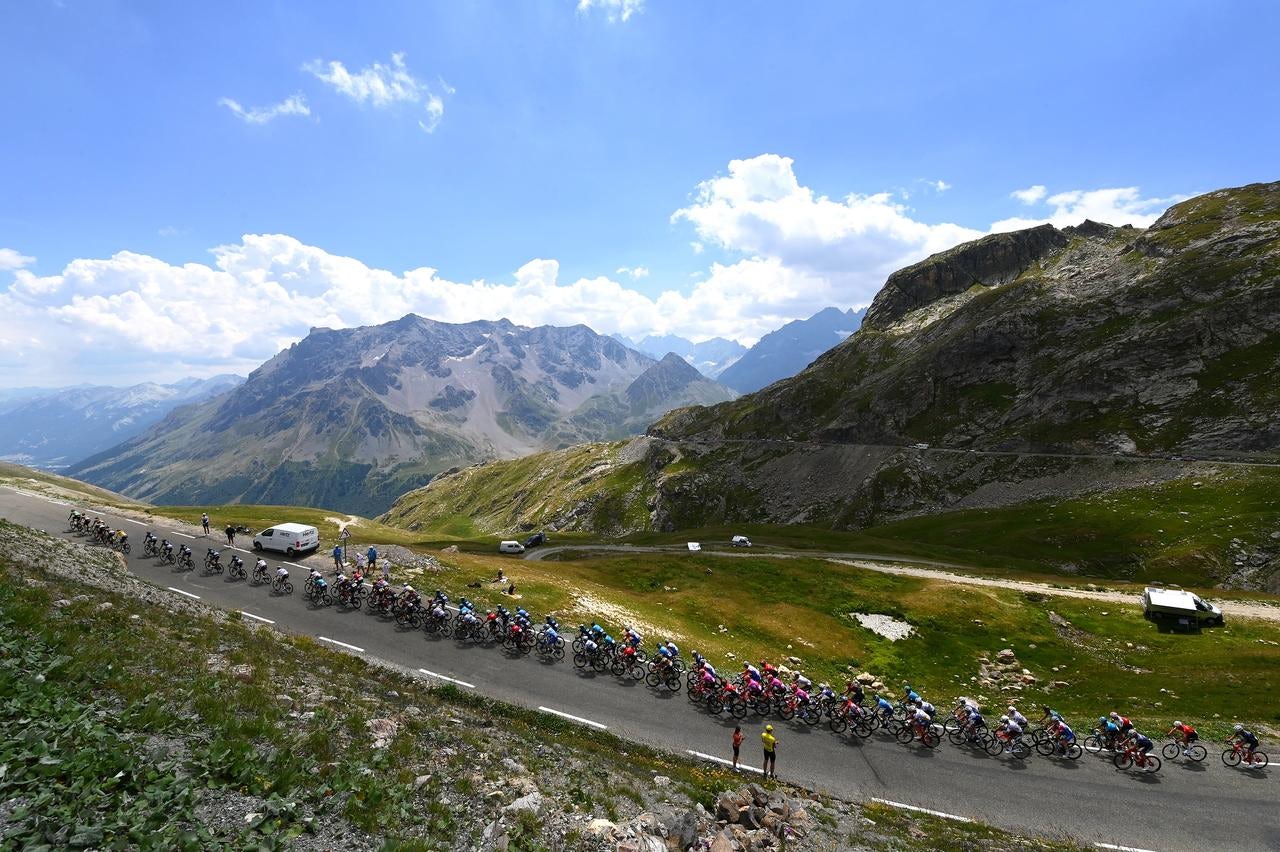
© Velo Collection (TDW) / Getty Images
The fearsome Col du Galibier appears shockingly early in the 2024 Tour de France
The 2024 Tour de France is a thrill-seeker, seeking to capture the increasingly elusive attention of as broad an audience as possible. We have mountains at the start, mountains at the end, and gravel in the middle. We have the hilliest ever opening stage and we have a real race on the final day for the first time in 35 years.
In short, we have plenty of ammo for this run-down of 'unmissable' stages.
The 2024 Tour de France will, of course, be live in full on GCN+ and while you may well watch every stage from start to finish, these for us are the standout days when you're going to want to clear your calendars.
Stage 4: Why take a tunnel when you can climb a col?
July 2: Pinerolo – Valloire, 138km
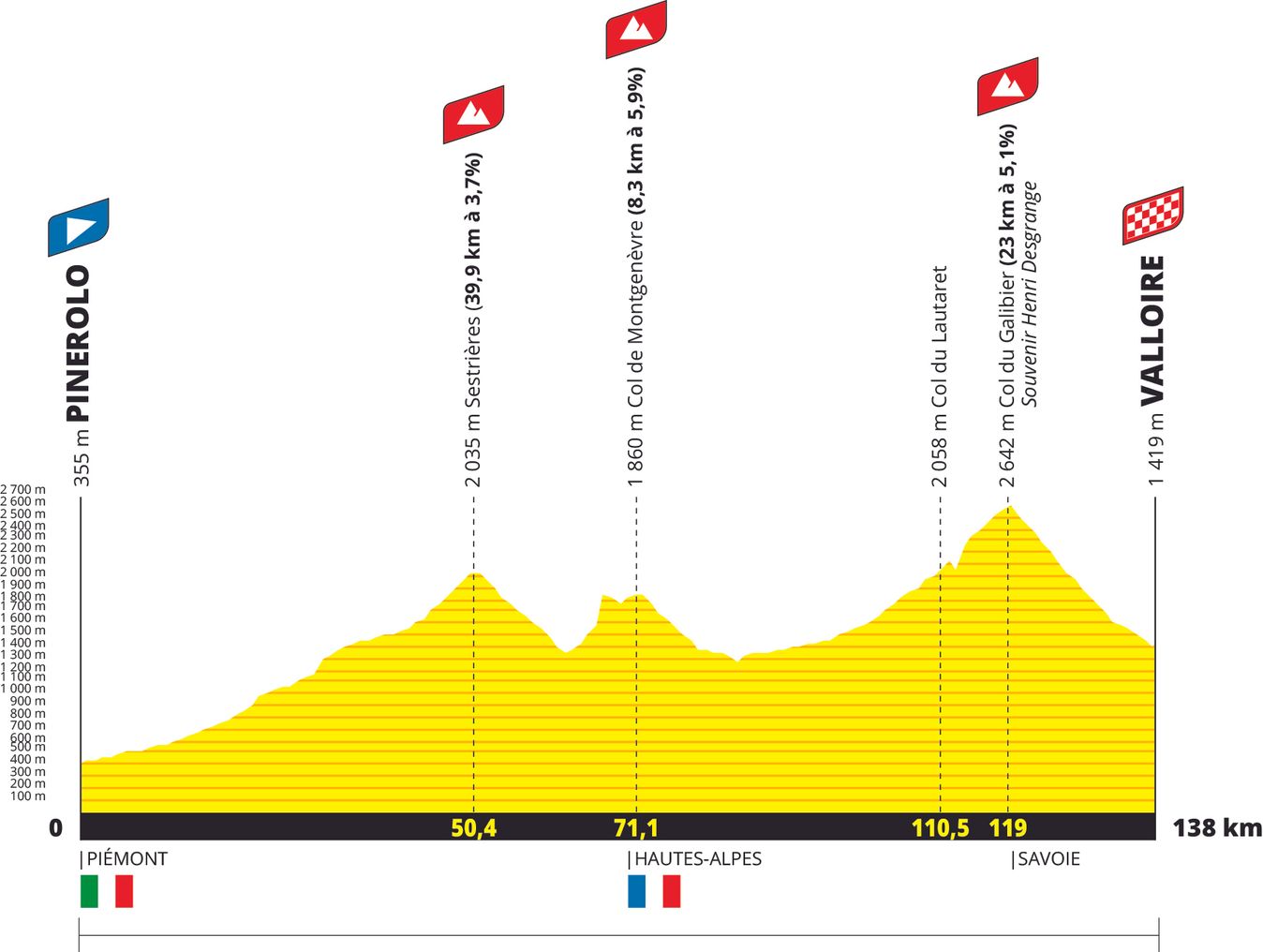
The profile for stage 4 of the 2024 Tour de France
“Never before has the Tour been so high, so soon,” said Christian Prudhomme as he unveiled this early foray into the Alps. We knew the race had to get from Italy to France, and that means negotiating the Alps, but doing so in this way was not on many bingo cards.
“We could have passed through some tunnels, but we had no interest in doing that, so we preferred to pass over some cols,” Prudhomme added with a mischievous smile.
This is a proper mountain stage, and even if you look at it and think it’s not the likeliest to generate decisive general classification movement, you then remember it’s only stage 4 and that this sort of thing isn’t supposed to happen this early in a Grand Tour.
A full on mountain stage this early is unprecedented, but it's not the first time the Tour has started with some hills. In some respects the first few stages of this Tour are a natural step up from what we saw last year. We have more elevation gain on the opening day in 2024 (3,600m) than we did in the Basque Country last year, when an early foray into the Pyrenees on stages 5 and 6 – on routes that didn’t look ultra-decisive – ended up seeing Vingegaard and Pogačar trade significant blows.
The same is possible on this route, which effectively climbs from the gun, all the way to Sestrières at 2035m. The race crosses the Italo-French border via the Col de Montgenèvre (8.3km at 5.9%) and then it’s time for the Galibier, one of the most iconic mountains of the Tour de France.
It's the southern side of the mountain in action here, totalling 23km at 5.1%, much of that being a steady plod up the Col du Lauteret, where the prevailing headwind could see a contained race. But things suddenly change when you ignore that left turn and head right onto the upper reaches of the Galibier, as the gradient ramps up dramatically, the mountainside vertiginously falls away, and the altitude starts to bite.
This will be as much about the descent as the ascent, with the route re-tracing the steps that made Tom Pidcock a Netflix star, so we’re in for a spectacular finale, however the Galibier leaves it hanging. The draggy nature of much of the climbing may fail to inspire some fans, but you have a Tour de France icon, altitude, and a stunning descent, and then you remember it’s only stage 4.
Stage 9: Gravel storm incoming
July 7: Troyes – Troyes, 199km
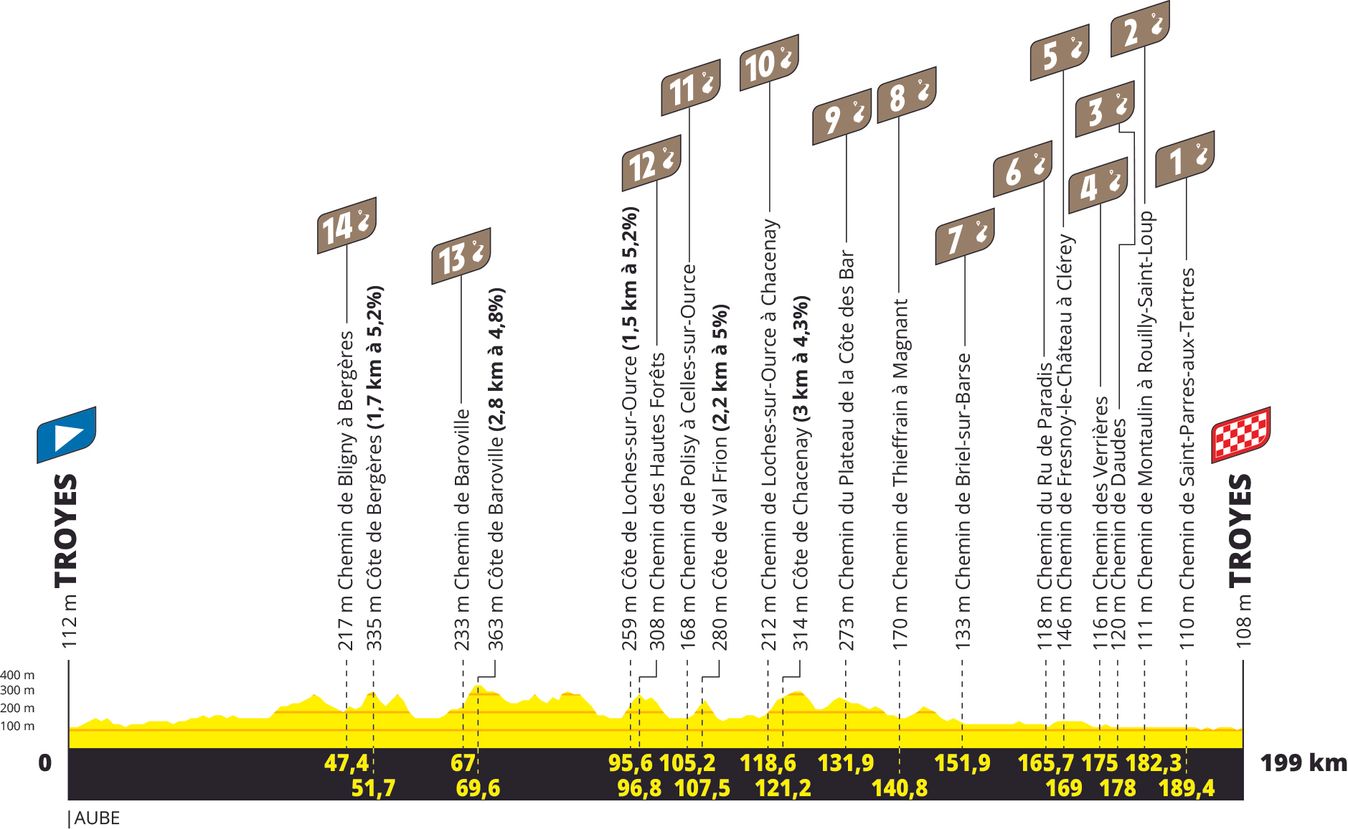
The profile for stage 9 of the 2024 Tour de France
Love gravel, hate gravel, you are not missing this. This could be a massive moment for the race; it could be a massive moment in the history of the Tour de France; it could amount to very little at all; but it’s going to be captivating viewing, either way.
There was a sense of shock after Christian Prudhomme had unveiled the parcours for this stage. The very presence of gravel had been heavily touted in the pre-presentation rumour mill, but, sorry… how much?! No fewer than 14 sectors will line the route of stage 9, totalling more than 32km of the so-called chemins blancs (white tracks). That’s not Strade Bianche territory, but it’s considerably more than the 12.9km used when the Tour de France Femmes visited this area in 2022, the 11.6km on offer at next year’s Giro d’Italia, and any helping of cobblestone sectors we’ve had over the years.
It’s going to kick up a storm of dust on the day but it has already whipped up a stormy debate. “It is not necessary,” said an exasperated Jumbo-Visma boss Richard Plugge, a feeling echoed by his Bora-Hansgrohe counterpart Ralph Denk and in more diplomatic terms by his rider, the defending champion Jonas Vingegaard. Remco Evenepoel has already spoken out against the gravel, while his Soudal Quick-Step boss Patrick Lefevere has never hidden his own distaste for gravel and cobbles.
The general argument against is that the heightened risk of mechanical problems or crashes could take a leading contender out of contention or out of the race altogether – rather than being decided on strength and tactics, it increased the role of Lady Luck. The argument in favour draws on both the past and future of cycling. Prudhomme pointed out that some of the sport’s legends were making their mark before long before paved roads were the norm, while gravel as a modern discipline is the sport's major growth area.
The Tour de France has made obvious efforts in recent years to appeal to the social media generation, so it’s no surprise to see them jump on the gravel hype train. If nothing goes drastically wrong on stage 9 next July, we can expect to see them lean further into the drama and entertainment angle, with Tour routes veering further away from the traditional. This is part of the testing ground for how a Grand Tour could and should be designed.
As for the day itself, the luck factor will be impossible to predict but in purely racing terms there is plenty of time to be won and lost. Plugge may have underlined Vingegaard’s bike handling skills, but the Jumbo-Visma reaction doesn’t scream confidence, nor does that of Primož Roglič’s future team Bora-Hansgrohe, while Evenepoel will have flashbacks to his nightmare outing on the Tuscan gravel in the 2021 Giro. That’ll be music to the ears of Tadej Pogačar (UAE Team Emirates), a former winner of Strade Bianche and the reigning champion at the Tour of Flanders. He is, quite simply, a more rugged and rounded rider, and he will surely see this not as an obstacle but an opportunity.
However it falls, the sight of the yellow jersey and co. careering onto the gravel – a haze of dust in the dry, or a mudbath in the wet – will be compelling viewing. Even if nothing much happens, you’ll be holding your breath on the edge of your seat for each sector, but there’s every chance this could be one of the most dramatic days of the whole Tour.
Stage 15: A Bastille Day epic
July 14: Loudenvielle – Plateau de Beille, 198km
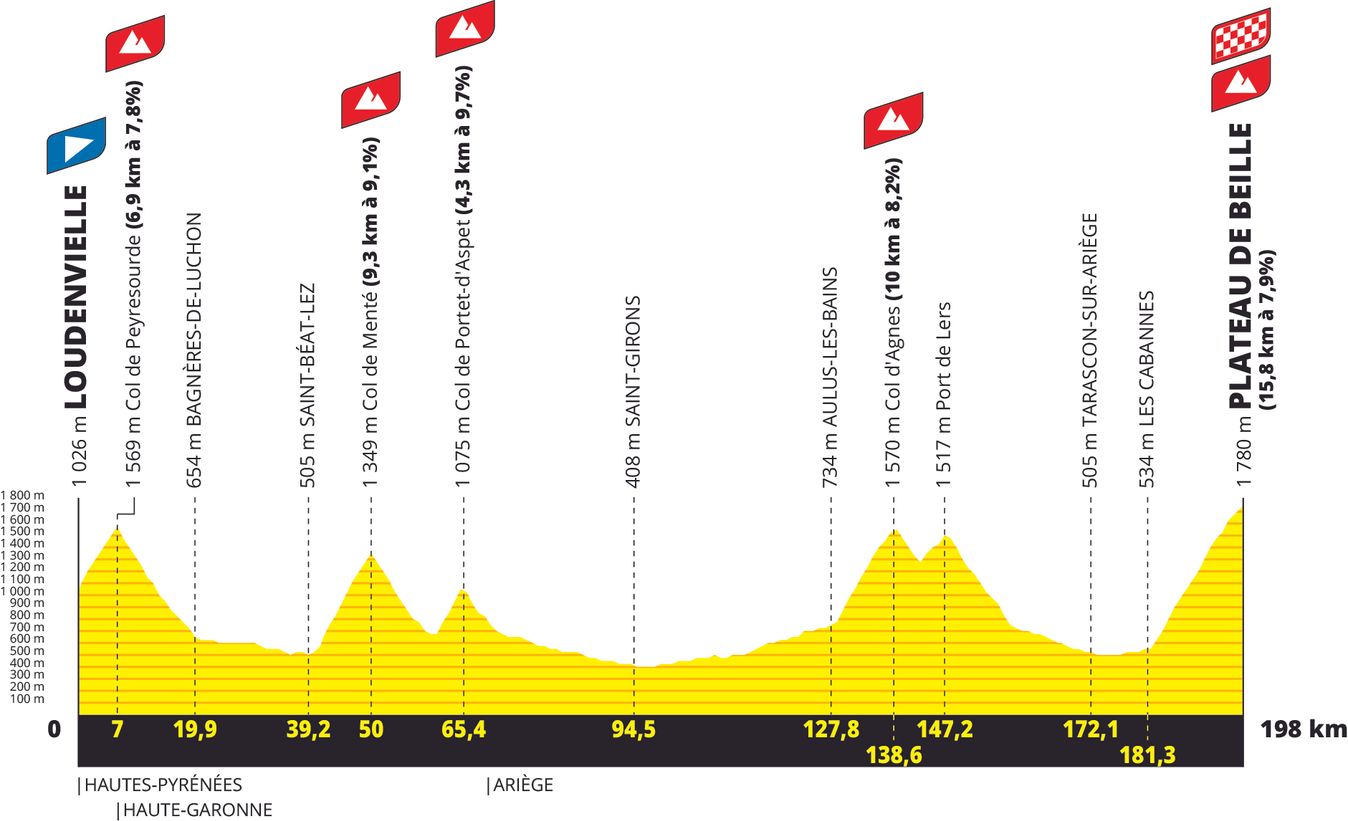
The profile for stage 15 of the 2024 Tour de France
Bastille Day, and as if the French fans needed any more incentive to get out there and scream their lungs out, we have a crazy day in the Pyrenees.
Let’s start with the stats: 198km, six climbs, 4850m elevation gain. It’s a big, big day and, what’s more, it comes hot on the heels of another big day. Stage 14 might not be quite as heavy, but it still goes over the Tourmalet, Hourquette d’Ancizan and up Pla d’Adet, meaning the legs will already be dulled for this epic.
It’s another summit finish, up at Plateau de Beille, but more on that later. The stage rips out of the traps, climbing the western flank of the Col de Peyresourde from the gun. The ascent from Loudenvielle measures 6.9km at 7.8% and the bunch is going to explode immediately. Breakaway artists will be on the move, pawns will be placed, lower-rung GC riders will be on the hunt, and we could even see a favourite or two looking to take advantage of the chaos. After the descent there are 20km in the valley but then the Col de Menté hits and it’s vicious (9.3km at 9.1%), followed straight away by the Portet d’Aspet (4.3km at 9.7%).
The valley roads in the middle of the stage should be where things settle back into some sort of pattern, but the shake-up will recommence on the Col d’Agnes (10km at 8.2%), and the short hop over to the Port de Lers. A descent and a short valley stretch then lead to the final climb to Plateau de Beille (15.8km at 7.9%), which didn’t see much action on its last appearance in 2015, but then again this is a harder stage in general. The first few kilometres are the hardest, averaging 9%, and it hangs mostly between 7-8% the rest of the way up. For such a long climb, the average gradient is high, and there’ll be guaranteed damage by the top.
The 2024 Tour route seems to have less of a penchant for super-steep climbs than previous years, with a return to more of the traditional steadier efforts, but this stage features the sharpest gradients of the whole Tour, and also the most elevation gain of a single stage. It’s set to be a defining day.
Stage 19: Up in the clouds
July 19: Embrun – Valloire, 145km
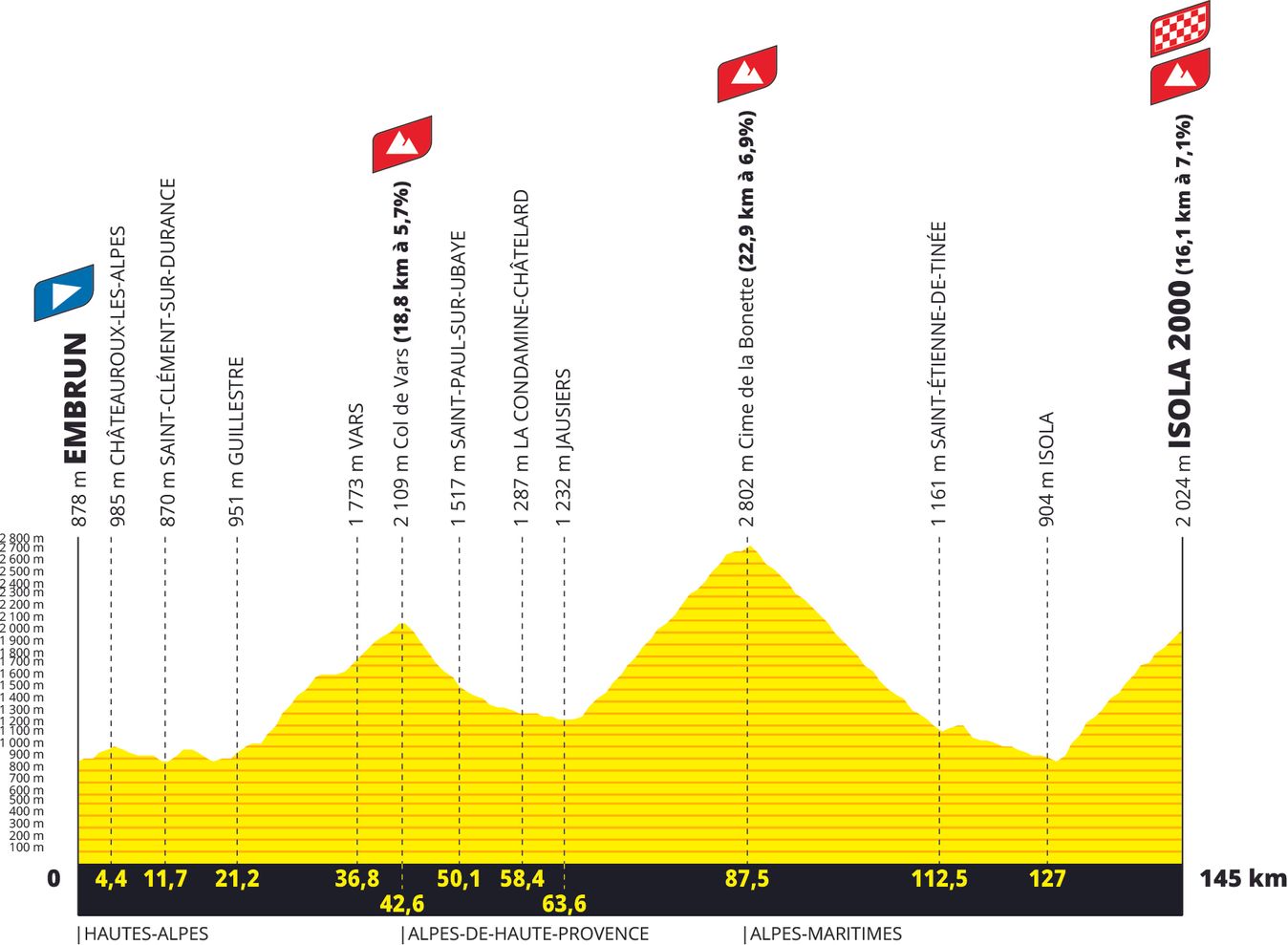
The profile for stage 19 of the 2024 Tour de France
Rivalling stage 15 for the honour of the race’s ‘queen stage’ is this trip down the eastern flank of the French Alps, and it offers a real contrast to its Pyrenean counterpart.
For starters, it’s shorter, by 53km, and it contains almost as much elevation gain. Although it doesn’t start uphill, it’s a more intense affair. Secondly, the climbs are less steep, but longer, the Col de Vars and Cime de la Bonette both around the 20km mark.
The most important factor – and the thing that truly sets this stage apart – is the altitude. 2000 metres has become a sort of mythical benchmark, often referred to as 'the barrier'. Above the barrier, things change as the paucity of oxygen dulling both the muscles and the senses. At that height, you can crack and never recover.
The Tour goes above 2000m on the Galibier on stage 4 and the Tourmalet on stage 14, but stage 19 is ‘the altitude stage’ of the 2024 Tour.
The Col de Vars takes us to 2109m with an 18.8km climb at an average gradient of 5.7% that’s heavily mitigated by a 3km plateau in the middle. It’s then over to the Cime de la Bonette, which, at an eye-watering 2802m, is one of the highest paved roads in Europe.
This is extreme altitude, and while the climb, measuring 22.2km at 6.9%, would be hard enough from seal level, half of it is above the 2000m barrier, where the riders will be toiling for more than half an hour.
The long descent to Isola sets us up for another vertical kilometre on the final climb to Isola 2000, which as the name suggests, punctures that 2000m barrier for a third time. It’s another long climb at 16km, and while it’s a steady traditional ski resort seven percent-er, the day’s exertions will start to take their toll.
It’s the sort of stage, heading into the clouds, where the idea of climbers ‘taking flight’ feels very apt indeed.
Stage 21: Drama til the last
July 21: Monaco – Nice, 34km (ITT)

The profile for stage 21 of the 2024 Tour de France
For the first time in the history of the Tour de France, the race will finish away from Paris, and for the first time since 1989, we’ll have a competitive final day.
Those memories from 35 years ago will only whet the appetite for this 35km time trial between Nice and Monaco. The final day of that 1989 edition, concluding with a time trial into Paris, is one of the most memorable day’s in the race’s rich tapestry, with a pioneeringly aerodynamic Greg LeMond snatching the yellow jersey from Laurent Fignon by a mere eight seconds – the tightest ever Tour.
The arrival of the peloton in Paris is, for many, symbolic. However, the champagne-fuelled procession is not to everyone’s taste, and those who prefer the last day of the race to be, well, a race, will delight in the 2024 finale on the Côte d’Azur.
Provided it’s not a complete walkover to that point, the yellow jersey will be in play until the very last metres and moments of the Tour de France.
If the yellow jersey is indeed in play, then even the flattest of time trials would be gripping, but this is a far more interesting route than most, heading into the hills behind Nice to provide an all-round test of climbing, descending, flat power, and also bike handling.
The route starts in Monaco and spends all of 3km on the flat before heading up La Turbie, a well-trodden training climb for the enclave of Principality-based pros. At 8.1km at 5.6%, it’s a solid climb but more of a steady, seated effort. It provides a link to the Col d’Eze, famous from Paris-Nice, so it’s not the full climb but a steep 1.6km kicker at the top, which is followed by a long, fast, sweeping descent into Nice for a flat final 6km.
It’s a stunning route, perched above the glistening blue waters of the Mediterranean, and it should balance things finely between the remaining yellow jersey contenders, coming down to who’s still firing after three weeks. That’s another part of the novelty; the 2024 Tour effectively has one extra day of ‘real’ racing, and this TT comes after two big summit finishes, and five mountain stages in the space of the previous seven days.
If it goes down to the wire, it will live long in the memory.
.jpg?w=600&auto=format)
Tour de France
- Dates 29 Jun - 21 Jul
- Race Length 3,492 kms
- Race Category Elite Men
Latest Videos
1 Cycling The World's Largest Bikepacking Event | A 500km Epic In Tuscany

2 Is This The Lightest Gravel Bike in the WORLD?!

3 Cycling VS Crossfit | Who Are World's Fittest Athletes?

4 Can We Make A £500 Bike Faster Than A £10,000 Superbike?

5 We Did Every Fitness Test In One Day! | GCN Visits A Performance Lab

Patrick is GCN’s Deputy Editor, writing and shaping content across all areas of the website
Related Content

Tour de France 2024 route revealed
The 2024 Tour de France will feature four summit finishes and two time trials, as well as a hilly start in Italy, gravel roads, and an unprecedented finale in Nice

Jonas Vingegaard rates Tour de France 2024 route 8/10
It's 'super hard' says defending champion, but he'd like it to be harder
.png?rect=0,38,2000,1125&w=720&h=405&auto=format)
Tour de France 2024: Analysing the contenders
After Paris-Nice and Tirreno-Adriatico, we take a look at the key potential protagonists and their prospects in the hunt for yellow

GCN unpacks the Tour de France and Tour de France Femmes 2024 routes
Join Joe Timms as we go through the stages revealed by ASO ahead of the two Grandes Boucles next summer
Subscribe to the GCN Newsletter
Get the latest, most entertaining and best informed news, reviews, challenges, insights, analysis, competitions and offers - straight to your inbox

Mountain stages of the 2023 Tour de France
Post last updated:
This page showcases all the mountains and climbs for the 2023 Tour de France. The route was announced on 27 October 2022 and promises plenty of action in the mountains once again. This page reflects the information currently available and will be updated periodically as more information is released about the race.
I have been lucky to experience the thrill of watching the Tour de France on multiple mountain stages and am looking forward to 2023. My toughest descision will be which mountain to choose to spectate. In the Pyrenees the 2023 race returns to the slopes of the iconic Col du Tourmalet, while the race returns to the slopes of Le Puy de Dôme for the first time since 1988.
In 2023 the riders will be faced with the mountains in the first week when the hit the Pyrenees. It will be interesting to see how this shapes the race given there will still be a long way to the finish line. This year also sees a mountain stage on the day before the finish which will test the strength and resolve of all the riders before the final stage in Paris the following day. It will be interesting to see it all play out and I can’t wait until July.
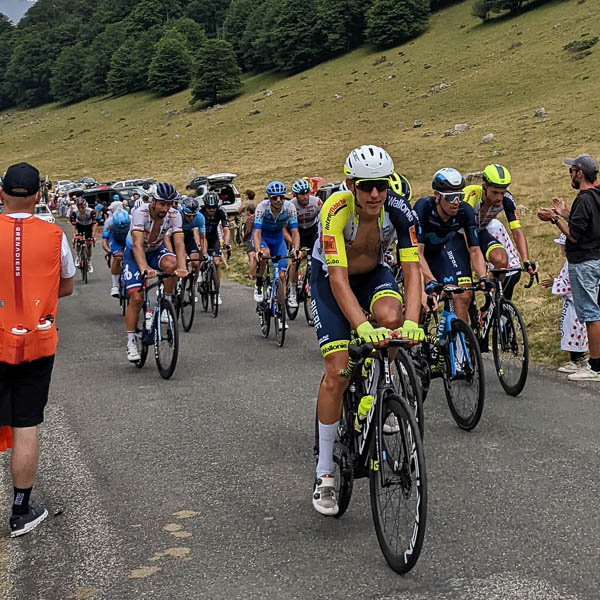
If you are considering visiting France for a cycling holiday or to watch the Tour de France, be sure to check out the rest of the Seek Travel ride website. There is a wealth of information to help you plan your cycling holiday to France including lots of practical information , destination guides and travel information . Our Tour de France section includes a general guide to the race each year as well as tips for watching the event roadside.
A brief history of the mountains in the Tour de France
In most editions of the Tour de France, the mountain stages are where the race is won or lost. A single bad day for a rider in the mountains can see them lose minutes to rivals and an end to their title bid. On long mountain climbs, there is nowhere to hide and any little chinks in a rider’s armor are usually found. Over the years climbs such as Alpe d’Huez, Col du Galibier, Mont Ventoux, Col du Tourmalet, and Col d’Aubisque have become synonymous with the race.
The mountain stages are some of the most popular for people to watch the race and there are many iconic images of riders navigating a sea of spectators. It is estimated that many hundreds of thousands of fans line the mountain roads as they twist and turn their way to the summit. On rare occasions, fans get a little too close and bring a rider down.
First mountain stage in the Pyrenees
The mountains first entered the Tour de France in the 8th edition in 1910. In that year stage 10 started in the Pyrenean town of Bagneres de Luchon and climbed Col du Peyresourde, Col d’Aspin, Col du Tourmalet, and Col d’Aubisque before finishing 326km later in Bayon. Octave Lapize finished the stage first in a time of 14hrs 10mins. No mean feat given that all the mountain passes were dirt roads back in those days and the bikes had nowhere near the range of gears modern bikes now have.
Inclusion of the French Alps
While the organizers deemed the addition of the mountains to be successful the riders were less impressed and there were protests in 1910 about the stage. Nevertheless, in 1911 the French Alps were added to the race with the inclusion of Col du Galibier, Col de Castillion, and Col de Braus. This was in addition to the stage in the Pyrenees.
Since those early days, both the Pyrenees and French Alps have featured in the race annually. In later years climbs in other regions such as the Jura, the Vosges, and the Massif Central have been added to the race. The Pyrenees and French Alps have generally taken turns in being featured in the all-important last week of the race.
Famous climbs and the 2023 Tour de France
There are a number of iconic climbs from the Tour de France that everyone loves seeing in the race. Unfortunately they don’t all make it in every year but we thought I would go through and let you know which ones made the 2023 race and which did not.
Climbs in the French Alps
Alpe d’Huez will not feature in the 2023 Tour de France and was last included in 2022.
Col du Galibier , like Alpe d’Huez featured in the 2022 Tour de France and will not be back in 2023.
Col d’Izoard has not been included in the Tour de France since 2019 and again misses out in the 2023 Tour de France.
Mont Ventoux was climbed twice in the 2021 Tour de France and is not included in the 2023 race.
Climbs in the Pyrenees
Col du Tourmalet , the most climbed mountain in Tour de France history, will once again feature in the 2023 Tour de France. It’s going to be a busy year for the mountains with 3 grand tours, Tour de France, Tour de France Femmes and Vuelta a Espana, all using the mountain for stages.
The Col d’Aspin is also back for the 2023 Tour de France and will be the warm up act before the riders head up the Col du Tourmalet. It was also used in the 2022 Tour de France.
The Col d’Aubisqe last appeared in the 2022 Tour de France and is not included in the 2023 race.
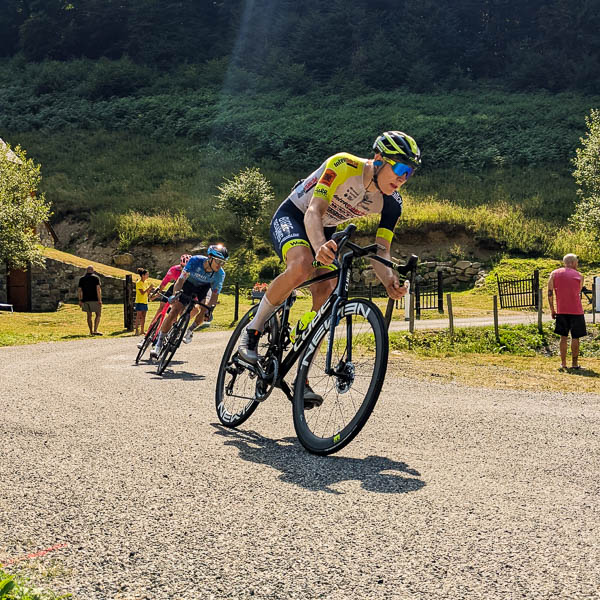
2023 Tour de France climb stats
The 2023 Tour de France includes 10 stages with categorized climbs, four of which includes a summit finish; Stage 6 Cauterest-Cambasque, Stage 9 Puy de Dome, Stage 13 Grand Colombier, and Stage 15 Saint Gervais Mont Blanc. Stage 20, the second last stage, packs a punch with 5 categorized climbs. No doubt there will be plenty of tired legs come to this stage. The race in 2023 visits 5 of France’s mountain ranges, the Pyrenees, Massif Central, the Jura, the Alps, and the Vosges.
There are only 2 climbs over 2,000m in the 2023 Tour de France with the highest being Col de la Loze at 2,304m, followed by Col du Tourmalet at 2,115m. Col de la Loze is also the longest climb of the 2023 Tour de France at 28.4km in length. The shortest climb for this edition of the race is the first categorized climb, Côte de Pike, which averages 10% for 2km on stage 1.
ASO, who runs the Tour de France, has now released the full details of each stage. This includes maps, mountain categorisation and estimated time along the course. I have now updated the table to reflect this information and help you plan your own viewing of these mountain stages.

Categorization of Tour de France climbs
Each of the climbs is given a categorization which is an indication of the difficulty of the climb. Hors category (HC) are the toughest climbs followed by category 1, category 2, category 3, and category 4. A category 1 climb will be harder than a category 3 climb so the lower the number the harder the climb. A climb can change categorization based on how far into a stage it might be. For example, a climb could be considered a category 2 climb if it comes early on in the stage when riders have fresh legs, or a category 1 climb if it comes towards the end.
The climb categorization also comes into play when awarding points in the Polka Dot jersey competition. For example on an HC climb the first rider over the top will be awarded 20 points while on a category 4 climb the first rider will be awarded 1 point. On an HC climb points are awarded for the first 8 riders while on a category 4 climb only the top rider receives any points. There is a sliding scale of points and positions between HC and category 4.
We can help plan your trip
Planning a holiday is always great fun but can also be quite time-consuming. As you research more and more you may find yourself with more questions than answers. We offer a range of services to assist people with planning their own cycling holiday to France, ranging from one-on-one calls to answer your questions to a full planning and itinerary service. You can find a rundown of the services we offer on our Travel Planner page.
We first visited France for a cycling holiday in 2013 and returned numerous times before moving here permanently in 2021. Over the years we have travelled by plane, train and hire car with our bikes and learned lots of lessons about visiting France generally as well as travelling around with a bike. We enjoy both road cycling and cycle touring and look forward to being able to help you plan that perfect trip.
BEST WEEK EVER
Try out unlimited access with 7 days of Outside+ for free.
Start Your Free Trial
Powered by Outside
Tour de France
Legendary mountains of the tour de france: mont ventoux, tom simpson died scaling this mountain, but other names associated with its moonscape have met happier fates..
Heading out the door? Read this article on the new Outside+ app available now on iOS devices for members! >","name":"in-content-cta","type":"link"}}'>Download the app .
If the way to judge a mountain’s difficulty is by studying the faces of those who have just cycled up it, then Mont Ventoux is the winner going away—at least as far as cyclo-tourists are concerned. I’m not sure the same can be said about today’s well-trained Tour cyclists, for the phobia of Tom Simpson’s death on the mountain in 1967 has long since faded. For this generation of racers, the Ventoux is simply one of the sport’s toughest climbs .
The Ventoux can still make life difficult for the Tour’s thoroughbreds, however. If it’s stiflingly hot in Bédoin, but cooler once the tree line has been cleared, the climb is brutal but tolerable. But if this part of Provence is having a heatwave, and if there’s no wind to clear the air, then the cyclists are in for a real grilling. Such was Simpson’s fate all those years ago.
Other factors contribute to the mountain’s fearsome challenge. The Ventoux stage might be a time trial, as in the 1987 Tour. It could be a summit finish after a long day in the saddle, as is most common on the Ventoux. Or it might be the last climb in a long day of mountain ascents, the brutal finale to an en-ligne stage ending in Carpentras or Avignon. At least one thing is sure: The Tour will always climb the Ventoux from its harder side, the way it first did in 1951 and the way it has done fourteen times since.
Because I first saw the Ventoux climbed in that 1987 time trial, when I could see each suffering individual as he climbed the mountain, capture on film each drop of sweat as it left so many furrowed brows behind, and feel the agony that each of the competitors was experiencing, it is harder for me now to judge the state of mind of the riders bringing up the rear of the peloton. The subjects in my camera these days are the fast men at the front of the race, the winged angels for whom the mountain holds no fear at all—men like Marco Pantani , Lance Armstrong, Richard Virenque, and Iban Mayo.
As for the others, I know they’re back there somewhere. They’re the less fortunate ones who’ve struggled from the moment they first glimpsed the bald summit over one hour ago, and are still struggling to finish long after the more gifted men have crossed the line, shared the podium with some pretty hostesses, and are already well into their descent to Malaucène and a cozy shower. It’s just that I can’t get back there to record their plight the way I once could.
Agony or not, photographing the Tour on the Ventoux is a treasured occupation. It’s one that’s made all the more exciting because the Tour only visits occasionally, about once every five years since that first ascent, with six crossings and ten summit finishes to date.
It’s one of the few mountains that gets me all fired up, right from the moment its name is mentioned at the Tour launch in October; even the Galibier doesn’t do that. Mont Ventoux always has a decisive role in the Tour’s outcome, and that knowledge is intoxicating. There’s never going to be an easy winner on its summit, and Ventoux always acts as the great stage on which the race’s best cyclists are going to do battle. Great pictures are going to come from any ascent of this monster. What you don’t know is who’s going to win.
Although I’ve only seen the Tour climb the Ventoux four times in my career, its more regular inclusion in the weeklong Dauphiné-Libéré (now the Critérium du Dauphiné) stage race that precedes the Tour in June means there’s a familiarity about it that makes my work even more pleasurable. Ventoux is one of the few mountains where I can watch the racing as I take pictures.
The opening kilometers are there purely to shed the no-hopers and to focus your mind on the task that lies ahead. It helps that this part of the climb is heavily shaded. The first key place comes about 7 kilometers up, at a sharp righthand bend. The road is pitched up sharply here, with a gradient of 8.6 percent. It makes this bend a favorite place to stop and see the beginning of the end as the peloton begins to break apart.
The next few kilometers take us to the Chalet Reynard, the steepest and most crucial part of the climb, where the pitch averages just over 7.0 percent but includes a ramp or two at 10.3 percent. This also happens to be the most populated area, because of the D164 access road coming from Sault. The ramp that climbs away from the Chalet acts as the final launchpad for many of the Ventoux’s stage winners.
Just after the ramp settles down to a more civilized gradient, the road swings right, and at once the shocking face of the Ventoux unfolds before your eyes, a vast mountain of limestone rubble the color of white gold, with the observatory antenna still a distant 6 kilometers away.
It’s at this point that I realize all over again how much I love the Ventoux, both as a photographer and a cycling fan. The road just keeps going up, barely turning one way or the other, allowing me to see every pedal stroke the cyclists are taking as they tackle the cruelest section of the mountain. The backdrop is a vista of Provençal plaine and distant alpine peaks, which in the late afternoon sunshine is all the more overwhelming.
That same lighting illuminates the sweating faces in a way not seen on other mountains—and, yes, there’s definitely a ghostly pallor to even the healthiest cyclists. The limestone acts as a giant reflector, bouncing the sun, the light, and especially the heat back at the Tour’s gladiators, as if they didn’t already know that there is nowhere to hide on this part of the mountain.
The best ones now ratchet up the pace a little, testing their legs, testing the few rivals left near them. This is where Lance Armstrong delivered the coup de grâce to Joseba Beloki in 2002, firing off a series of attacks that quickly demolished the Basque’s failing morale. It was a lesson Armstrong perhaps learned on this part of the climb two years earlier, with just 6 kilometers to go, when instead of dropping Marco Pantani he let the Italian stay with him, who then went on to win the stage.
Sadly, the last kilometers disappear all too quickly for me. It’ll soon be time to calculate the distance I need to make the finish in time—that’s if I want to make the finish at all. There’s a captivating spirit about the last section of the Ventoux that makes it hard to tear yourself away from the action, a reluctance heavily influenced by the knowledge that the finish shot will literally be just that: the end.
I was a highly disappointed photographer in the 2000 Tour when Pantani surged to the line first but never celebrated his win the way a true Ventoux winner should—arms aloft, head held high, face expressive if not totally split by a wide smile. My preferred plan since then has been to stay with the leaders to the very last kilometer, speed ahead to the final 300 meters, then set up a standing shot with a long telephoto lens just before the final kickback bend to the finish. It’s a strategy that never fails, especially if it happens to be a yellow-jerseyed Armstrong pumping out the revs, a rat pack of motorcycle photographers trailing his every move, just as their forebears did with Eddy Merckx in 1970.
As the latest conquerors of the Ventoux pedal past where I stand, it’s hard not to feel emotional about the mountain. Men have died cycling up it, while others have found a happier fate doing merely what they do best. As I look down on the land so far below me, I wonder how long it will be before the Tour is back on Mont Ventoux. Not too long, I hope.
Adapted from Graham Watson’s Tour de France Travel Guide by Graham Watson with permission of VeloPress.
Graham Watson’s Tour de France Travel Guide
Popular on Velo
>", "path": "https://velo.outsideonline.com/road/road-gear/tech/", "listing_type": "recirc", "location": "list", "title": "video: tech in the women’s pro peloton is improving rapidly"}}'> video: tech in the women’s pro peloton is improving rapidly, >", "path": "https://velo.outsideonline.com/road/road-racing/i-think-im-passing-the-test-matteo-jorgenson-soars-to-second-overall-in-criterium-du-dauphine/", "listing_type": "recirc", "location": "list", "title": "‘i think i’m passing the test’: matteo jorgenson soars to second overall in critérium du dauphiné"}}'> ‘i think i’m passing the test’: matteo jorgenson soars to second overall in critérium du dauphiné, >", "path": "https://velo.outsideonline.com/mountain/pinkbike-digest-value-mtb-test-christopher-blevins-interview-and-more/", "listing_type": "recirc", "location": "list", "title": "pinkbike digest: value mtb test, christopher blevins interview, and more"}}'> pinkbike digest: value mtb test, christopher blevins interview, and more, >", "path": "https://velo.outsideonline.com/road/road-racing/remco-evenepoel-cracks-in-dauphine-insists-zero-panic-for-tour-de-france/", "listing_type": "recirc", "location": "list", "title": "remco evenepoel cracks in dauphiné, insists zero panic for tour de france"}}'> remco evenepoel cracks in dauphiné, insists zero panic for tour de france.

Podium Cafe, for Cycling fans
- Race Previews
- Tour de France
2022 Tour de France Mountains Preview - Let's Rank the Mountains
By _Will_ @cyclingalps on Jul 2, 2022, 4:45am EDT +

Col du Galibier will be climbed twice
Bonjour, bienvenue en France. La Grande Boucle is more of a half circle this year. With a start in Copenhagen, the peloton will then evacuate to Dunkerque and ride down the east side of France eventually reaching the Pyrénées mountains. Along the way, the route visits the five largest mountain ranges in France (Vosges, Juras, Alps, Massif Central, and Pyrénées).
There are six mountain stages. Vosges (1), Alps (3), Pyrénées (2). Five of these stages (arguably all six) are mountain-top finishes.

Strangely the ever present Col du Tourmalet is not in this year's Tour. But don't worry we have Alpe d'Huez for Jens and all the other fanboys. At 2 642 metres, Col du Galibier will be the highest point of the race. For our UK readers that is 8 668 feet. In fact both the north and the south side of Galibier will be climbed. It will be the first ascent (north side) when the Prix Henri Desgrange will be awarded to the first rider to reach the summit of the highest point of the race.
By my count there are 59 classified climbs:
hors categorie = 7 category 1 = 10 category 2 = 6 category 3 = 14 category 4 = 22
This will be a long article.
I’ll add pictures for those that hate reading. But below we will:
- Rank all the Hors Categorie, Cat 1, and Cat 2 climbs by difficulty
- Take a look at all six mountain stages.
- Give a few brief recommendations for visiting cyclo-tourists.
- Let you, dear readers , vote to decide the Queen Stage. Allons-y (let’s go)! Below are the statistics for the twenty-three Hors-Categorie, Category 1, and Category 2 climbs including a difficulty rating.
DIFFICULTY RATING METHODOLOGY - To rate the climbs I have used the difficulty index from www.climbbybike.com that we have used previously. I know, I know, it’s a slightly flawed formula. But it’s easy to calculate and useful as a starting point for discussion. I am using the official Tour de France lengths and average grades for each climb, so rankings may differ slightly with those at climbbybike.com.

According to our methodology Col du Granon is the toughest climb in the 2022 Tour de France. Surprisingly, this is only its second Tour appearance - in part because it is a dead-end at least as a paved road. Its first appearance in 1986 was the highest mountain-top finish in Tour de France history (2413m), now only surpassed by the 2011 mountain-top finish on Galibier (2642m).

Col du Granon
You will see Col du Granon referred to as "Col du Granon Serre Chevalier" in official Tour de France literature. This is just marketing. Serre Chevalier is a nearby ski station that is clearly paying some marketing €'s. There are no ski lifts nearby. Most of Serre Chevalier skiing is in the mountain massif across the valley from Granon
The eight toughest climbs appear in just three stage (11,12, 18), all with mountain top finishes. Keep this in mind when voting for the Queen stage.
You likely know that the Tour starts in Denmark. But did you also know that the peloton will visit another country? The 9th toughest climb (Col de la Croix) and the 20th toughest climb (Col des Mosses) are in Switzerland as our cycling overlords have organised Stage 9 starting from UCI headquarters in Aigle. The stage finishes in France after crossing the border at Pas de Morgins the 11th toughest climb.
Before we discuss the 6 official mountain stages, here are the same twenty-three climbs grouped by stage:

Let’s walk through the six mountain stages:
Stage 7: vosges mountains.

La Planche des Belles Filles is a small ski station in the Vosges. This is its 6th Tour debuting in 2012. I sometimes call it one of the least charming major climbs I know. It is quite contrived: an extremely steep, modern road without much view. But for a pro bike race? Fantastic. It is deviously evil. Ouch!

The name La Planche des Belle Filles comes from an episode in the 30 years war in 1635 when according to legend the young girls of a neighbouring village hid themselves up this mountain to escape the cruel Swedish mercenaries who were stationed nearby at Plancher-les-mines. To escape abuse and probable massacre they preferred to commit suicide by jumping from a plank into the black waters of a lake on the plateau. A wood statue by a local artist commemorates this legend.

"Super" was added to the name in 2019 when the "super" steep final ramp was extended moving the finish to an altitude of 1140m versus the previous 1035m. Chris Froome won the inaugural 2012 stage with a time 16'11" . My time was closer to Etienne's 43 minutes.

The final kilometre: Steep modern road.

Stage 9: Swiss Alps
This stage not only starts in Aigle, the UCI folks will also get to cheer the peloton when it passes them again 150 kms into the stage.
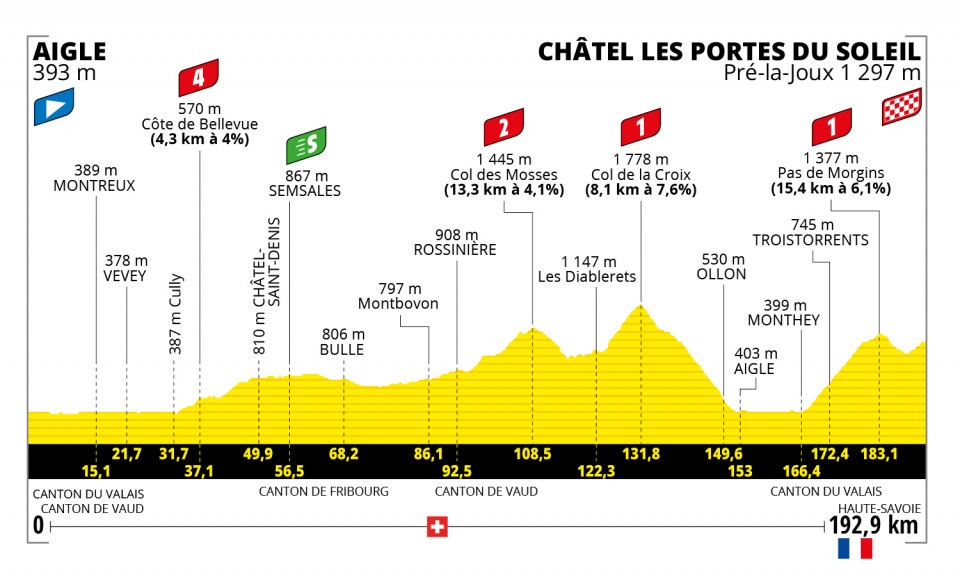
As the bottom of the chart above shows this stage is primarily in (the French-speaking) part of Switzerland or Suisse Romande. Not surprisingly, Col des Mosses and Col de la Croix often feature in the Tour de Romandie. But both cols have previously appeared in the Tour (Mosses 6 times, 1947 debut. Croix twice).
I endeavour to give you the best photographs of climbs I can. So ...... here is Col des Mosses:

My editor had demanded I do better. So here is a Col de la Croix several years ago freshly cleared of snow for a Romandie stage. Podium Cafe kit!!

Snow plough almost in view. High above nearby is glacier skiing at Diablerets ski station. It's a beautiful climb

Is this stage a mountain-top finish? Sort of. It climbs the 11th toughest climb, Pas de Morgins.This is the border between Switzerland and France - "Pas" is an old word occasionally used instead of col, for a mountain pass. The route briefly descends into France and then there is a brief, not too steep, uphill finish in Châtel.

The finish town is Châtel. Les Portes du Soleil is more Tour marketing. It is the name of a gigantic ski domain uniting 13 resorts some Swiss, some French (eg. Avoriaz and Morzine). Yes, you can ski between countries quite easily all day long without your passport.
For the Cyclo-tourists:
What's the steepest % grade sign I have ever seen while biking. Exactly on the France/Swiss border in the heart of the Portes du Soleil ski domain is the Le Mur Suisse (The Swiss Wall), a famous ski piste.
I had cycled up on ski slopes on the French side and after checking my brakes decided 90% was too steep a descent for me. Châtel is in the distance, off to the left, out of the photo.

Stage 11: French Alps
What a stage! Wow.
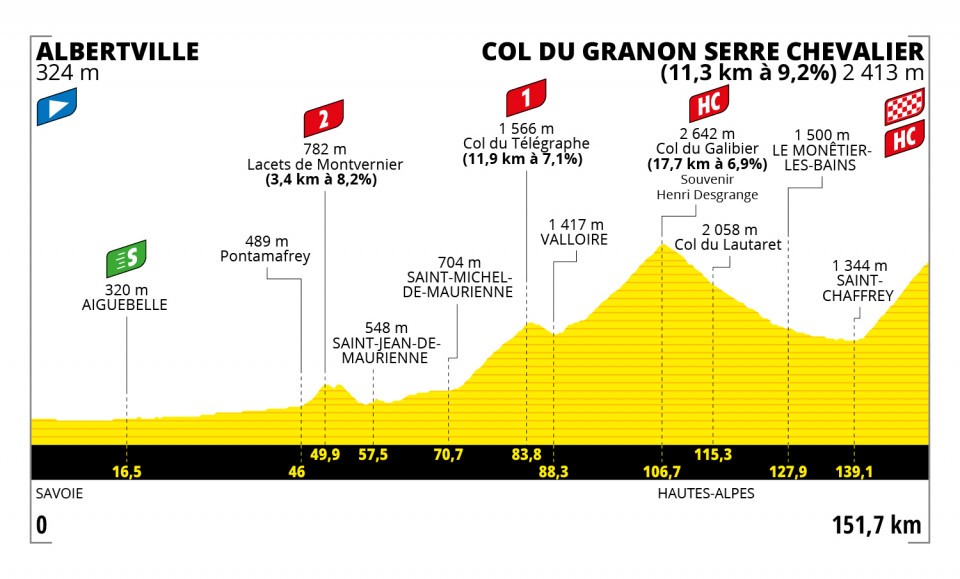
As an appetiser stage 11 will start with a visit to the amazing Lacets de Montvernier.
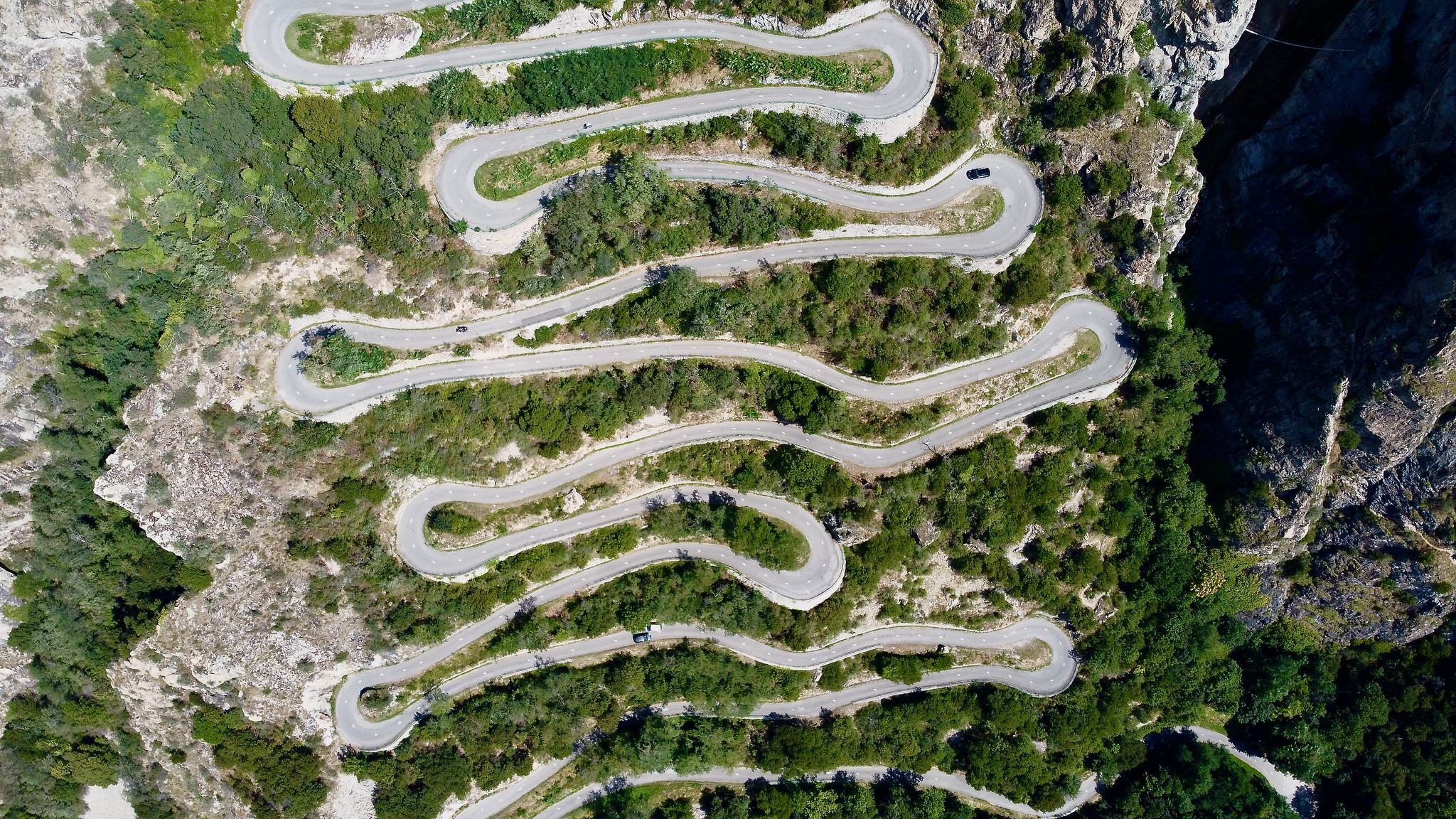
For the cyclo-tourists : The only way without a helicopter or drone to get a clear view of the hairpins: A few hundred metres beyond the summit on right is a trail through a farm road that leads to cliff look-out:
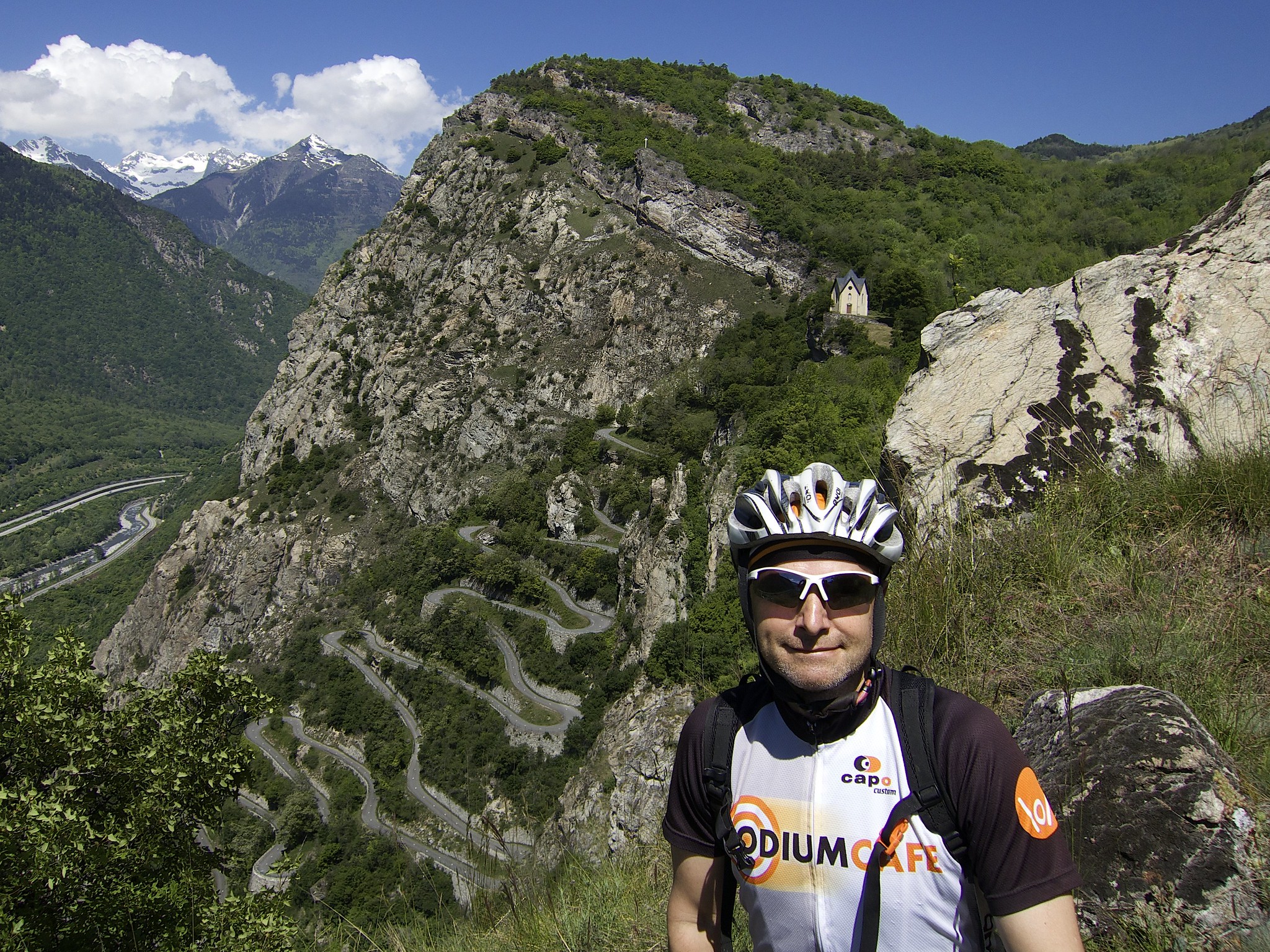
Next, the stage climbs the legendary north side of Col du Galibier via Col du Télégraphe.

Just off the main road at Col du Télégraphe is the Fort du Télégraphe perched on a cliff overlooking the valley below.
Fort du Télégraphe "previously accommodated a telegraph of the Chappe system using articulating arms to send messages between Lyon and Milan, and after 1809, Venice."

Often when climbing Galibier there will be strange straw art. I'll avoid posting the bizarre nude stuff and just post this excellent polka-dot cyclist exactly at the summit of Télégraphe.

The first ascension of Galibier in the Tour was the year following the 1910 high mountain experiment in the Pyrénées. Think Tourmalet, Aubisque, "assassins," etc. But Galibier was an order of magnitude bigger – a half vertical kilometre higher than Tourmalet.
Years ago I wrote an article "Col du Galibier - A Brief History" - see here .
Oh ! Sappey ! Oh ! Laffrey ! Oh ! Col Bayard ! Oh ! Tourmalet ! je ne faillirai pas à mon devoir en proclamant qu’à côté du Galibier vous êtes de la pâle et vulgaire bibine : devant ce géant, il n’y a plus qu’à tirer son bonnet et à saluer bien bas !" Translation: A list of famous mountain passes then " I will not fail in my work in proclaiming that beside Galibier you are but pale and vulgar beers. There is nothing more to do but tip your hat and salute from well below!" Henri Desgranges 1911 – Tour Director and publicist extraordinaire
Galibier is beautiful, epic, amazing. The col is named after the mountain peak in the centre of this photo: Le Grand Galibier (the col is 6 kilometres higher up to the right).

Our boy Jens (!!) in Podium Café kit climbing Galibier north side:

A kilometre down the far (south) side of Galibier the peloton will pass the Henri Desgranges monument. Oh, yes, there is a Galibier brand beer brewed in Valloire on the north side, Cheers!

Finally, the stage will climb Col du Granon. Steep, not easy:

I believe this will be the 3rd highest stage finish in TOUR history after Granon in 1986 and Galibier in 2011. The Spanish rider Eduardo Chozas won the 1986 Granon stage. I believe the main road was constructed to serve some military positions built in the 1930s. But there is nothing at the top now and it is apparently a popular place for local star-gazing groups. In other words it gets very dark, no light pollution.
For the Cyclo-tourists
The paved road ends exactly at Col du Granon but there are trails and superb gravel routes that lead to a bunch of higher cols and two well preserved old forts from the 19th century. Here is a link to a map and report visiting the two forts and five gravel cols.
(in photo below you can see some of the Serre Chevalier ski slopes across the valley)

Stage 12: French Alps
Another truly gigantic and beautiful stage, and also Alpe d'Huez.

The stage begins by climbing the south side of Galibier. The early part of the climb is on a not-too-steep busy-ish through road to Bourg d'Oisans but at Col du Lautaret, the route turns right and gets steeper and more interesting. The next 8 kms are superb.

From the same 12% sign - just a few metres from the col - are great views of the climb below:

I watched the 2008 Tour up here disguised as Lance Armstrong. Sorry!
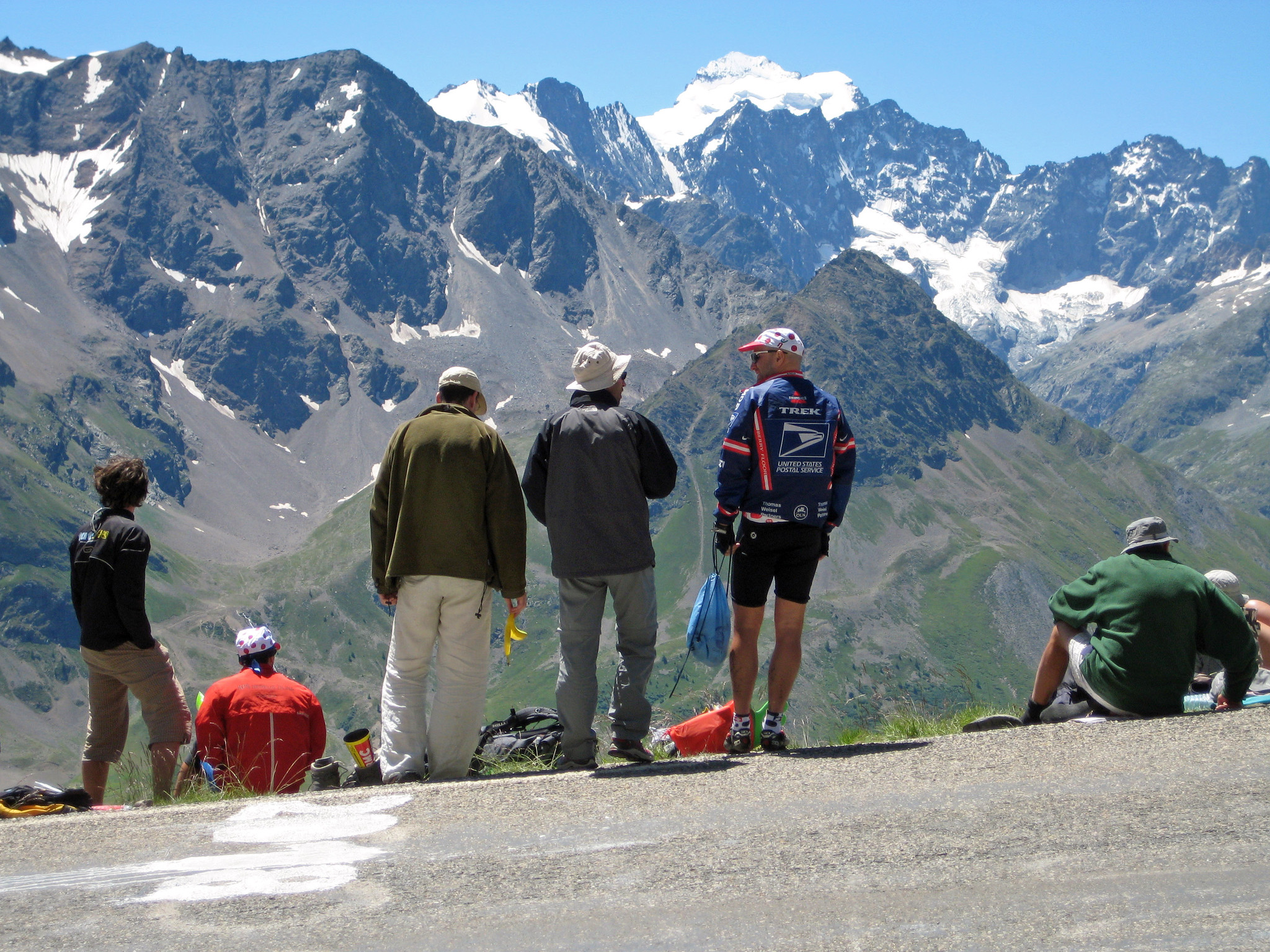
Tip : The little flat area at the summit will probably be closed to fans as it was in 2008. And the gendarmes won't appreciate "people" taking photos there. Sorry!

After summiting Galibier, the route descends the same north side that they climbed on the previous stage. A few kilometres down they will pass the Marco Pantini monument, commemorating the Italian cyclist for his epic stage victory in the 1998 Tour finishing up Les Deux Alpes (which included Galibier).

I can't imagine how fast the peloton will descend the 35 kms from the Galibier summit to the base of Télégraphe, but yikes. They will then glide through the Maurienne valley and begin the ascent of Col de la Croix de Fer.
This is a long, gigantic climb.
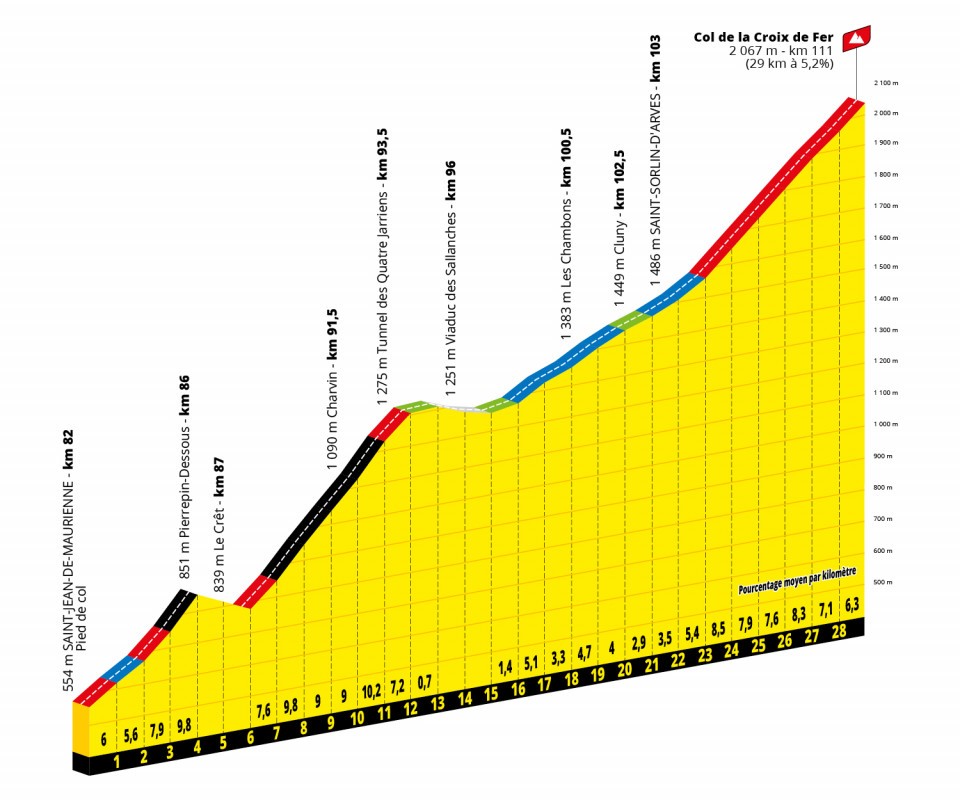
The final six kilometres of the climb are pure hairpin heaven. I can't wait to see the helicopter shots.
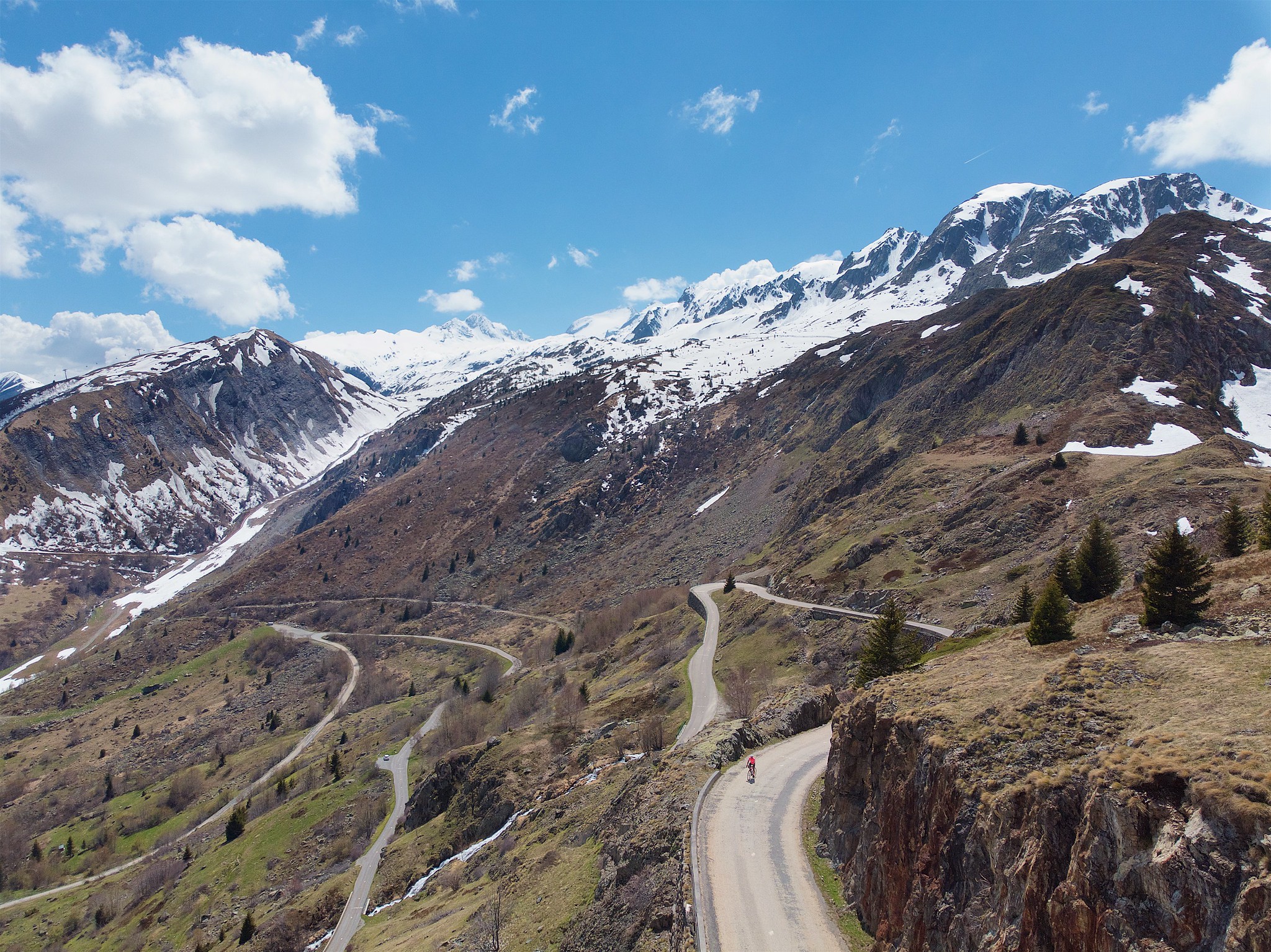
Tip: The French TV coverage will certainly point out the distinctive three peaks named Les Aiguilles d'Arve (below). Scream at your TV if your broadcasters don't know its name when the helicopters show them.
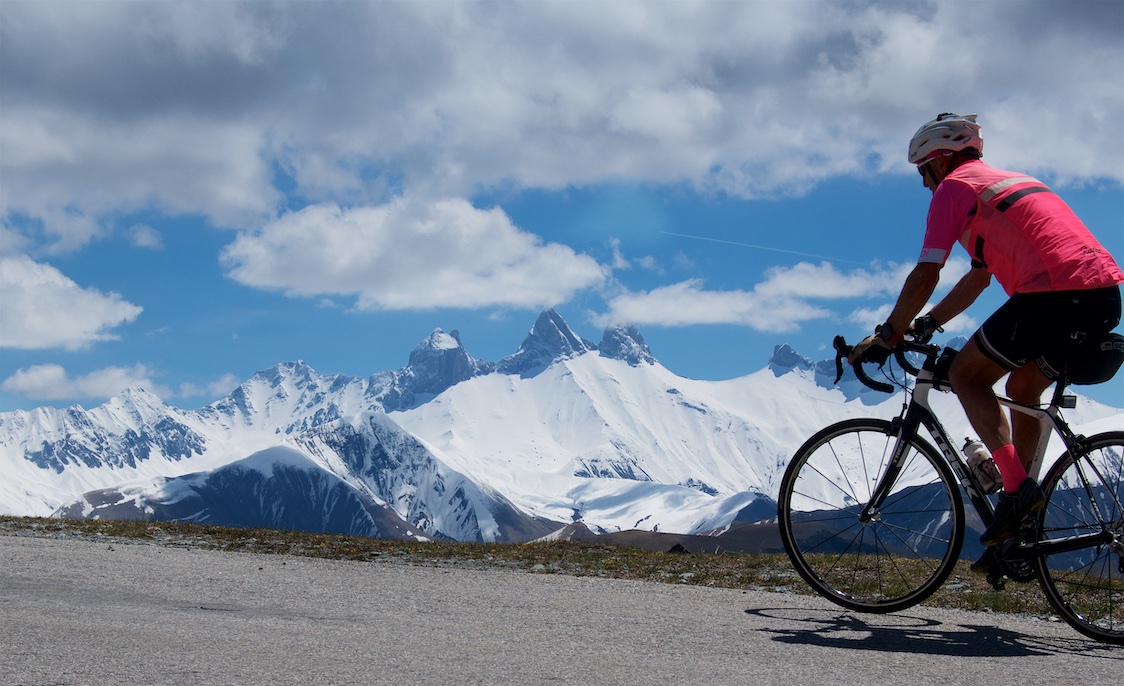
From the summit is another gigantic and generally not-technical 30 kilometre descent. At this point you can turn off the TV and go for a ride because the only thing remaining ......... is ALPE d'HUEZ and its 21 hairpins.

Tip : The hairpins count down as you climb. So the first hairpin is #21, Each hairpin has a sign with its number and the name of a stage winner (or two). The Italian legend Fausto Coppi won the first Tour stage here in 1952. And then some other fella. Also, remember, despite some bars/restaurants drawing lines on the road as you approach the village, the official finish line is through town.

Note, Podium Cafe was once many years ago painted on these hallowed hairpins. But someone defaced it!

I'll let you guys discuss in the comments who you think will win atop this legendary climb. As you know, I know nothing about pro cycling.
1. Did you know the old road up the south side of Col du Galibier still exists? First built in the 1880’s, this was the only way up the south side until 1938. As best I can tell it was abandoned/closed in 1947. This means that between 1911 and 1938 the Tour de France would have climbed or descended this road over twenty times. It is far to the east of the modern road and except near the beginning the two routes don’t intersect until the top near the Desgranges monument at the entrance of the tunnel (2556 metres). Here is a blog post where I cycled from Briançon to Galibier using this old road.

2. Exactly at the Col de la Croix de Fer summit, behind the col sign begins a little gravel road that goes far higher to a couple of alpine lakes and the Glacier de St. Sorlin. Truly spectacular. Details in this link.

3. I'll keep my Alpe d'Huez tip simple. After a victory photo at the top. Keep going. One can follow the paved road higher for 4 kilometres past Col de Poutran and reach Lac de Besson and Lac de Noir. Simple, quiet, and beautiful.

Stage 17: The Pyrénées

The very pretty Col d'Aspin has been in the Tour somewhere around 70 times, often used as a link between Tourmalet and Peyresourde. Hourquette d'Ancizan only made its Tour debut in 2012 as a sort of Aspin alternative. But now they are combined.
In between Aspin and Ancizan is the road that leads to St. Marie-de-Campan and Tourmalet. I am betting 10 beers that some announcer will still find a way to tell the Eugène Christophe forge story even without Tourmalet appearing in this year's Tour. Drink!
This is a scenic, medium difficulty stage.
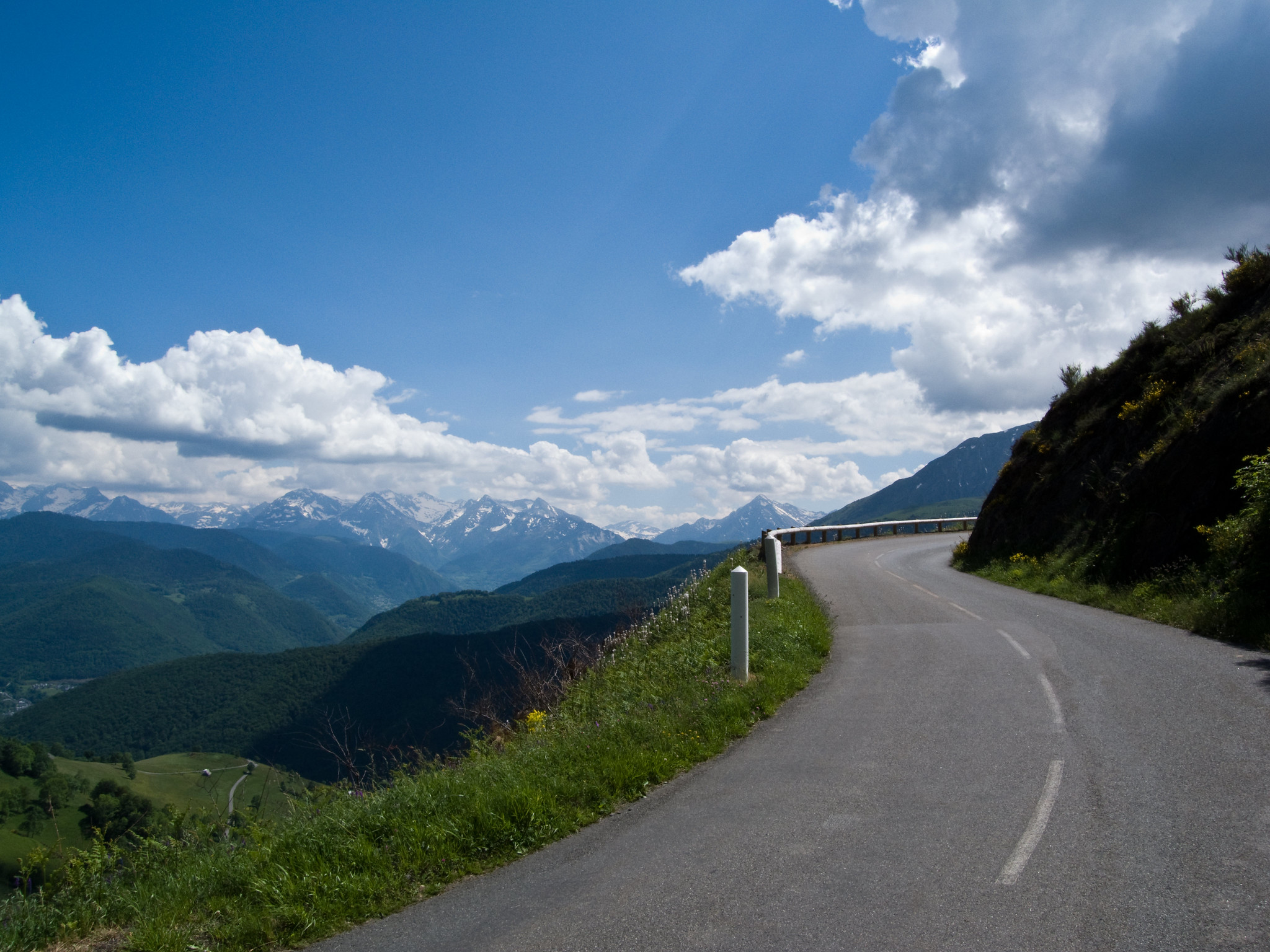
Hmm, do I have anything interesting or original to add. OK, I promise that people will confirm this as absolutely true:
Col d'Aspin is a cow col.

Hourquette d'Ancizan is a donkey col. I promise, but sorry I don't have a donkey photo. But it's a scenic, peaceful road.
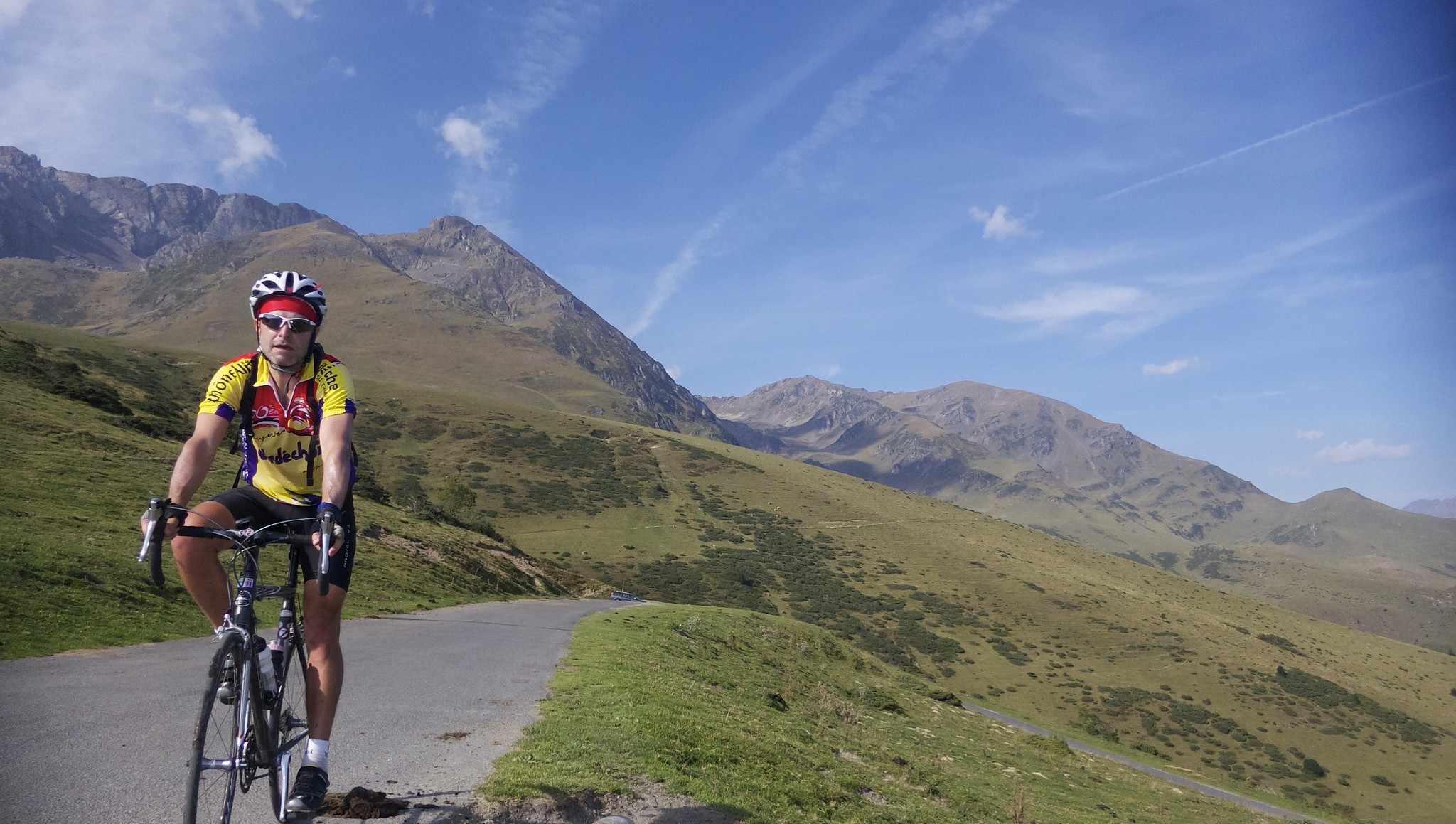
Col de Val Louron-Azet is formerly Col d'Azet but it was renamed because of the nearby Val Louron ski station. It is a cow col.

I've never ridden to the final climb at Peyragudes ski station, so please post a comment of you know its animal. Marmotte? :-)
Stage 19: The Pyrénées
This final mountain stage could decide the entire 2022 Tour de France with a challenging final climb up to Hautacam ski station. It's also a beautiful stage.

After an easy start the stage will attack the legendary Col d'Aubisque from the west side. The top of the descent is the famous cliff stretch of the Cirque du Litor.

Aubisque is a cow col. I once saw a dead cow a couple of kms from summit that had just fallen from above. I will NOT post the photo. So sad. But here's the toll collector for the Cirque du Litor.

The descent will pass Col du Soulor .... a sheep col.

The route will descend the less often used north side of Soulor. The views of this descent from Cirque du Litor are great. This will be another very good "helicopter" stage.
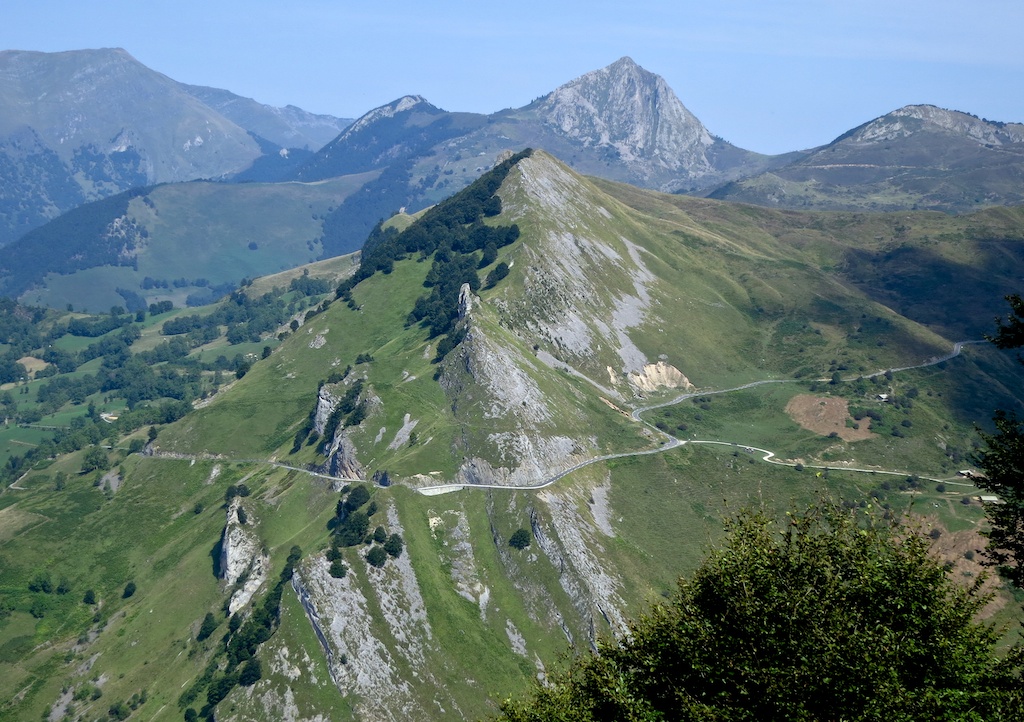
Amazingly, 2022 will be the Tour de France debut for Col de Spandelles. Wow. I will wager it has nice new tarmac as a reward. It's a fun, quiet climb, mostly forested on the descent side but very scenic on the side the Tour will climb.

Tip : Avoid the start town Lourdes. Although the Sanctuary of Our Lady of Lourdes is interesting. The town is unbelievably touristy tacky. It receives several million tourists every year and has more hotels per square kilometre than anywhere in France except Paris. The good cycling is further into the mountains.
Finally, the stage will climb Hautacam. Occasionally very steep, this will be a tough finish to the final mountain stage of the Tour.
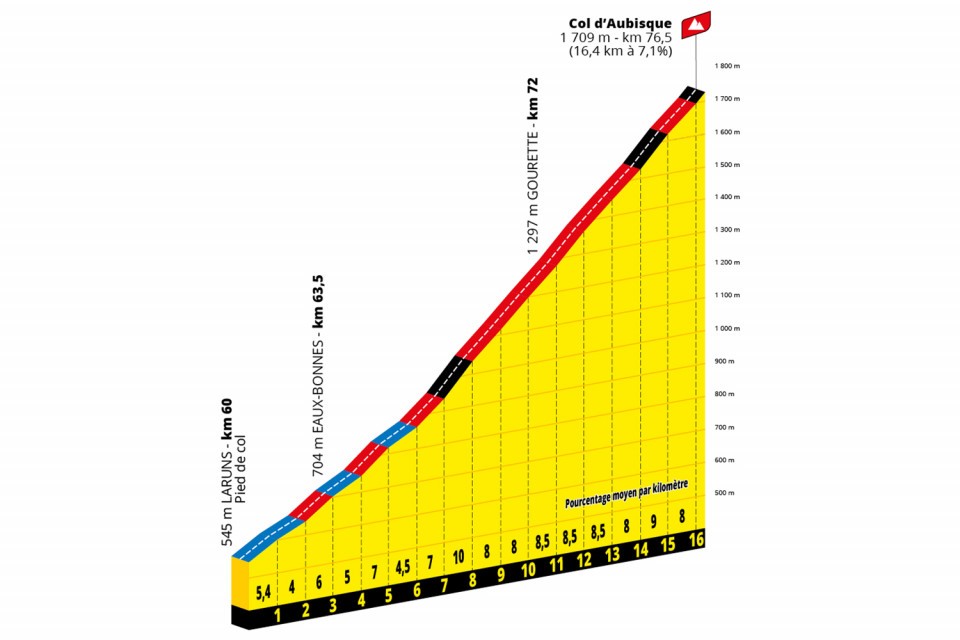
This will be the 6th Tour appearance for Hautacam. the first was in 1994 (Luc Leblanc). It is always a mountain-top finish as not a through road - although (cyclo-tourists please note) the paved road does continue 1.2 kilometres higher to Col de Tramassel. Hautacam is a horse climb:

When I visited Hautacam a house near the start of the climb has some wonderful artwork. Virenque gained weight after retiring?

Hautacam starts in a long valley that is at the base of so many brilliant cycling climbs: Tourmalet, Hautacam, Aubisque/Soulor, Spandelles, etc. And less well known, well down to the south are two truly stunning and very high paved climbs both over 2000 metres that cyclo-tourists seem to ignore.
Col des Tentes (2207m) is a hundred metres higher than Tourmalet and Cirque de Troumouse is just a touch lower. Highly, highly recommended.
Col des Tentes:
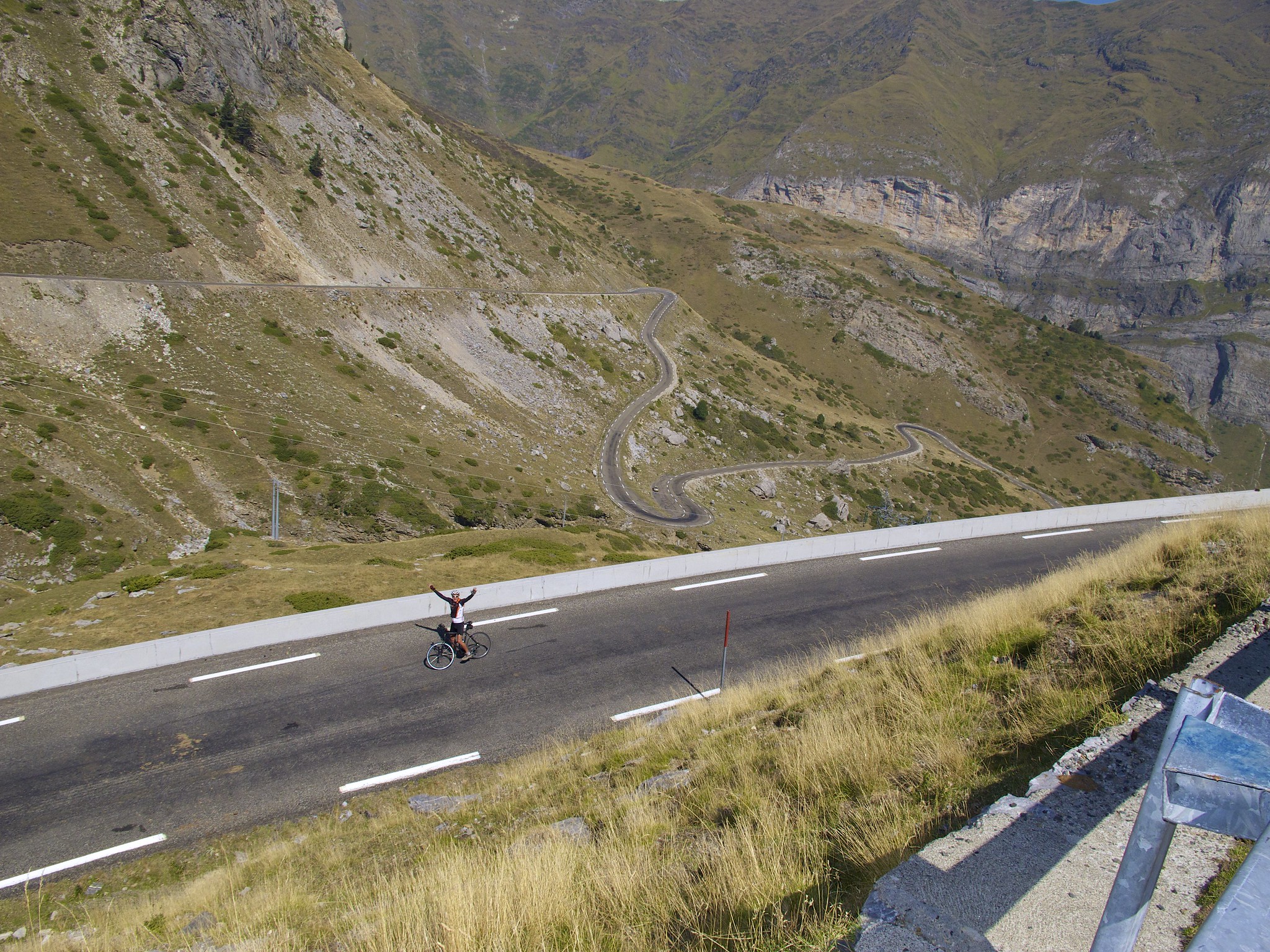
Cirque de Troumouse:
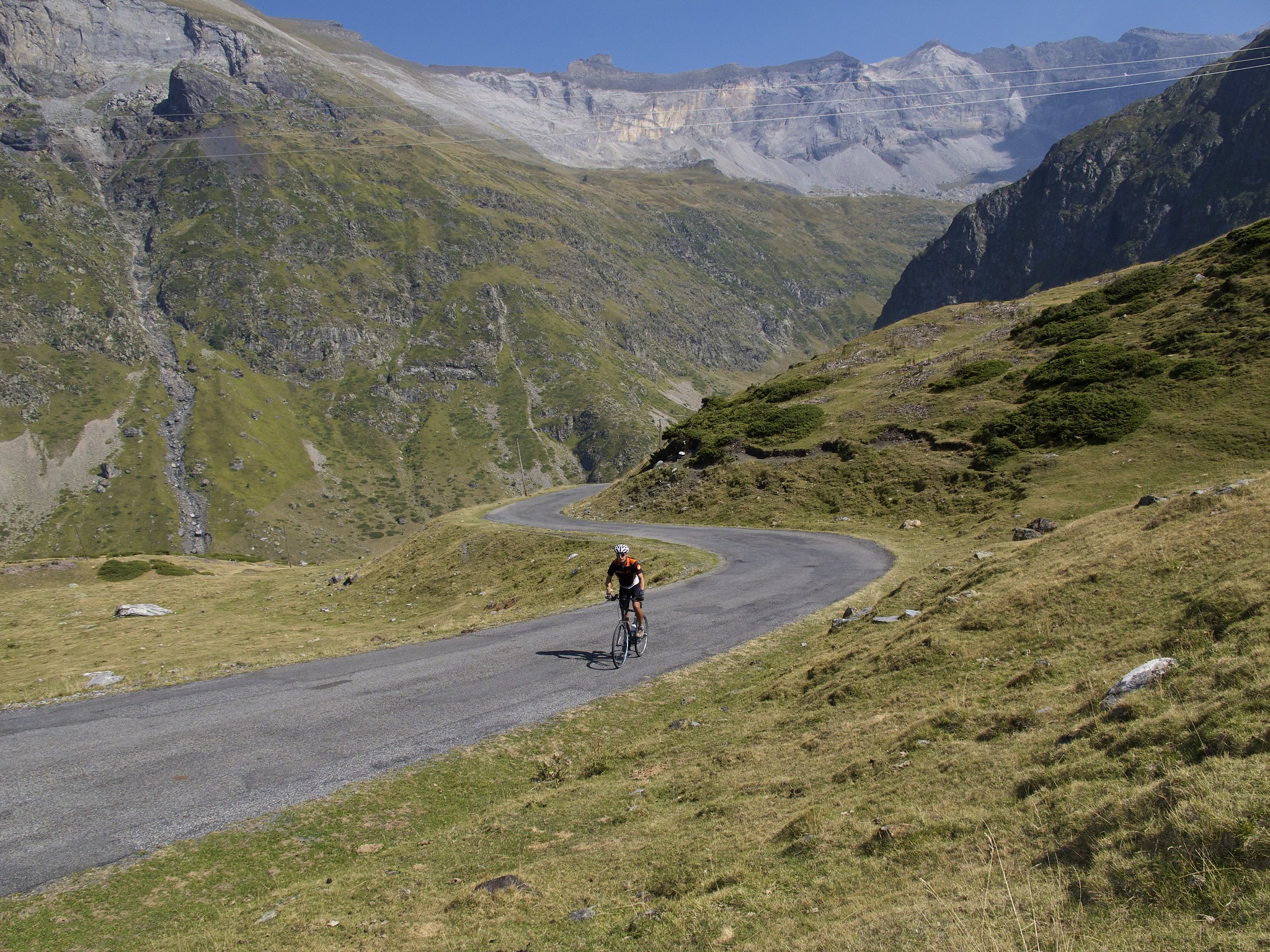
Cirque de Troumouse is a cow climb:

Final Thoughts
Hopefully, I have given a useful overview of the 6 mountain stages. I apologise for offering no insight as to which riders will enjoy these stages. I have no idea. But I have faith in you that you can use the comments to discuss,
Hmm, apparently I can no longer add polls. So please also use the comments to vote on which stage is the queen stage. I think there are only three possibilities. Either of the Galibier stages or the final Hautacam stage.
I hope you aren't angry with me but instead now proud experts of which animal belongs to the various Pyrénées climbs. So as a final note: not only is Col des Tentes a cow climb, the cow second from left is giving birth.
Thanks for reading,

More from Podium Cafe
- Will Sagan Be Dancing In France?
- At the Edge, by Danny MacAskill
- Richie Porte - Tour de France Favourite?
- Help Patrick Lefevre Spend His Money!
- Underreacting to the Critérium du Dauphiné
- Tour de Suisse Preview
- Knowing the Score, by David Papineau
Recent FanPosts
- On Being A Paris-Brest -Paris Ancien
- I want to go to Nevada City
- I Apolgize to Everyone
- Race Categories 68,3,4
- Unbound at Last!
- Velocio Says...
- PG - Giro d'Italia 2024 - Stage 21
- Boucles de la Mayenne LIVE
- PG - Giro d'Italia 2024 - Stage 20
- PG - Giro d'Italia 2024 - Stage 19
Loading comments...
Trending discussions.
- Tour de Suisse LIVE
- Dwars door Het Hageland LIVE
- Tour of Britain LIVE
- Critérium du Dauphiné LIVE
- The Epic 2024 Season Restart
5 Iconic Climbs in the Tour de France
Share this:.
- Click to share on Facebook (Opens in new window)
- Click to email a link to a friend (Opens in new window)

Every year, the Tour de France riders navigate 2,000 miles or more as they race across 21 stages of some of the most challenging terrain in the world.
The tour includes various landscapes that assault riders in different ways. Sprints create exciting finishes where athletes often win by microscopic margins. Time trials force riders to give all-out performances that leave fans marveling at their sheer power. Hilly stages are sometimes wild cards where racers can take risks and push themselves in different ways.
But nothing blows the pack of the Tour de France apart like mountainous stages. The Tour de France sends riders on some of the most challenging climbs in cycling .
By the race’s end, riders usually climbed somewhere in the neighborhood of more than 150,000 feet. The most demanding climbing stages significantly affect who walks away in the yellow jersey.
The Tour de France route changes every year. The total number of climbs can vary, and tour organizers can specify different and unfamiliar climbs. Some, however, have become so iconic that they are synonymous with the tour.
Here are five of the most infamous climbs the Tour de France has ever seen.
Alpe d’Huez: A Queen Stage of the Tour de France

The Alpe d’Huez is among the most famous climbs in the Tour de France. The climb is composed of 21 tight switchback turns and runs for just more than 8 miles with an average grade of about 8%.
Riders see a total elevation gain of more than 3,500 feet during the climb. Each of the 21 corners takes its name from a previous stage winner, so it is steeped in the tour’s history.
This route also is a favorite vantage point for fans to come out and watch the race. As they fight to the top, huge crowds line the roadway to cheer on their favorite cyclists.
Alpe d’Huez landed on Stage 12 in 2022. It once again became a venue for race leaders to jockey for position for the yellow jersey. British rider Tom Pidcock became the youngest rider to ever win the stage after putting on a descending clinic earlier on the route. Jonas Vingagaard and Tadej Pogačar hung together in a tough battle to finish neck and neck, though Vingagaard held his lead and the yellow jersey.
Col du Galibier
The Col du Galibier also appeared in Stage 12 of the 2022 Tour de France as the first climb of the day ahead of the Col de la Croix de Fer and the aforementioned Alpe D’Huez. The climb marked the highest point in the Tour de France this year.
The Col du Galibier runs for about 20 miles at an average grade of about 5%. It includes around 4,000 feet of elevation gain. The first 7 or so miles of the 2022 stage featured a steady, shallow climb to an early intermediate sprint. After that, the route pitched dramatically upward to the Col du Lautaret, and then onward to the summit of Galibier.
Anthony Perez of team Cofidis powered up the climb this year to reach the summit first.
Mont Ventoux: One of the Most Popular Climbs of the Tour de France

Mont Ventoux is iconic for its beauty, difficulty, and tragic history. The climb ascends about 13.3 miles with an average grade of 7.6% for a total elevation gain of more than 5,000 feet.
The top of the climb features an exposed, rocky landscape allowing sweeping views of the countryside beneath. But it also allows riders to see the long, upward pathway fade into the distance, which presents a daunting mental battle as they struggle up the mountain.
The exposed nature of the route often leads to high winds that make the ascent even more difficult and uncertain.
British cyclist Tom Simpson collapsed near the summit of Mont Ventoux during the 1967 Tour de France. Emergency crews flew him to a local hospital for care but were unable to save his life. A memorial to Simpson still sits near the summit of the stage.
Mont Ventoux is not included in the 2022 Tour de France.
Col du Tourmalet: The Tall Boy
The Col du Tourmalet is the highest mountain pass in the French Pyrenees, so you know it gets spicy.
It covers around 10 miles with a total elevation gain of about 4,300 feet at a grade of 7.1%. However, portions of the climb reach up to 9.7%. The climb is consistent and lung-busting, offering no reprieve for riders to catch their breath before the summit.
The Col du Tourmalet has been included in the Tour de France more than any other climb. Its last appearance came in the 2021 race. It is not included in this year’s Tour de France.
Col d’Aubisque
The Col d’Aubisque has earned its place in history as one of the significant climbs of the race.

First used in 1910, the climb runs for around 10 miles at an average grade of 7.2%.
The Col d’Aubisque presents one of the final mountain challenges for the 2022 race. It is the first “super category” climb of Stage 18, which runs for 88 miles from Lourdes to Hautcam.
With only two flat stages and an individual time trial remaining, the Aubisque pass could become a make-or-break section and the last chance for a rider to attack and pull back time in the mountains.
Even completing one of these climbs is a feat for most cyclists. They could take an average rider a couple of hours to grind out, and they’ll hurt.
It’s pretty astounding that Tour de France riders often hit them back to back over more than 100 miles of racing. But aside from punishing riders, these climbs showcase the stunning landscapes of the French Alps and Pyrenees and make the Tour de France such a celebrated event.

Wout van Aert Borrows a Pump From a Fan and Gives Him the Tour de France Green Jersey
When a fan helped him out with a predicament after Stage 11 of the Tour de France, Wout van Aert returned the favor with the literal shirt off his back. Read more…

Don't Let the Yellow Jersey Fool You — The Tour de France Is Won by a Team
Riders who claim the yellow, green, polka dot, and white jerseys in the Tour de France may get all the glory, but the race is a team sport. Read more…

Mark Wilson is a freelance journalist for GearJunkie and BikeRumor. Mark has been writing about cycling, climbing, outdoor events and gear for more than a year. Before that, he spent more than a decade as a journalist at major daily newspapers in Texas covering crime, public safety and local government. Mark spent every free moment during that time carving up singletrack and gravel, or climbing with friends and family in Texas, Colorado and Mexico. Based in Texas, Mark is always looking for new trails, crags and gear to help navigate the outdoors. As a new dad, he is particularly interested in learning how to share his love of the outdoors with his son.
Follow Us On
Subscribe Now
Get adventure news and gear reviews in your inbox!
Join Our GearJunkie Newsletter
Gear Top Stories Deals

Top 5 Must-Do Rides Across the Pyrenees Mountains Tour de France Route
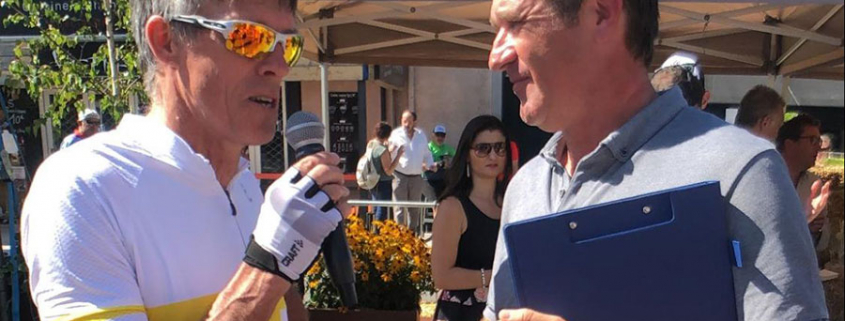
The Pyrenees mountain range located in southwestern Europe, specifically in south-south-west France, stretches from the Atlantic Ocean, reaching the Mediterranean Sea. The snow-capped chain of mountains is believed to have been formed 100 to 150 million years ago, which means they are older than the French Alps. Today, they act as a natural border separating France and Spain. The mountainous region is remote, with relatively unspoilt spots that are perfect for exploring, hiking, and of course, cycling. The area is raw and underdeveloped, with an exciting landscape and history that will captivate any cycling enthusiast.
It’s why Ride International’s good friend and partner Phil Anderson loves to cycle here and has hosted a number of tours in the French Pyrenees. Phil is well known for his Tour de France performance back in 1981, which is still an essential part of the event’s history up to this day.
Phil Anderson was a young rider who was one of the Tour de France’s participants and a member of the French Peugeot team. During the final Pyrenean stage held to the beautiful ski resort Pla d’Adet, Phil became the first non-European to win the honour to wear the coveted yellow leader’s jersey.
The beauty of the Pyrenees is not just about the breathtaking scenery; it’s also because the routes are for everyone, including relatively inexperienced riders or seasoned roulers on the bike. This blog showcases our top five Pyrenees rides (in no particular order), which are suitable for all neophytes and pros and cyclists of all fitness levels.
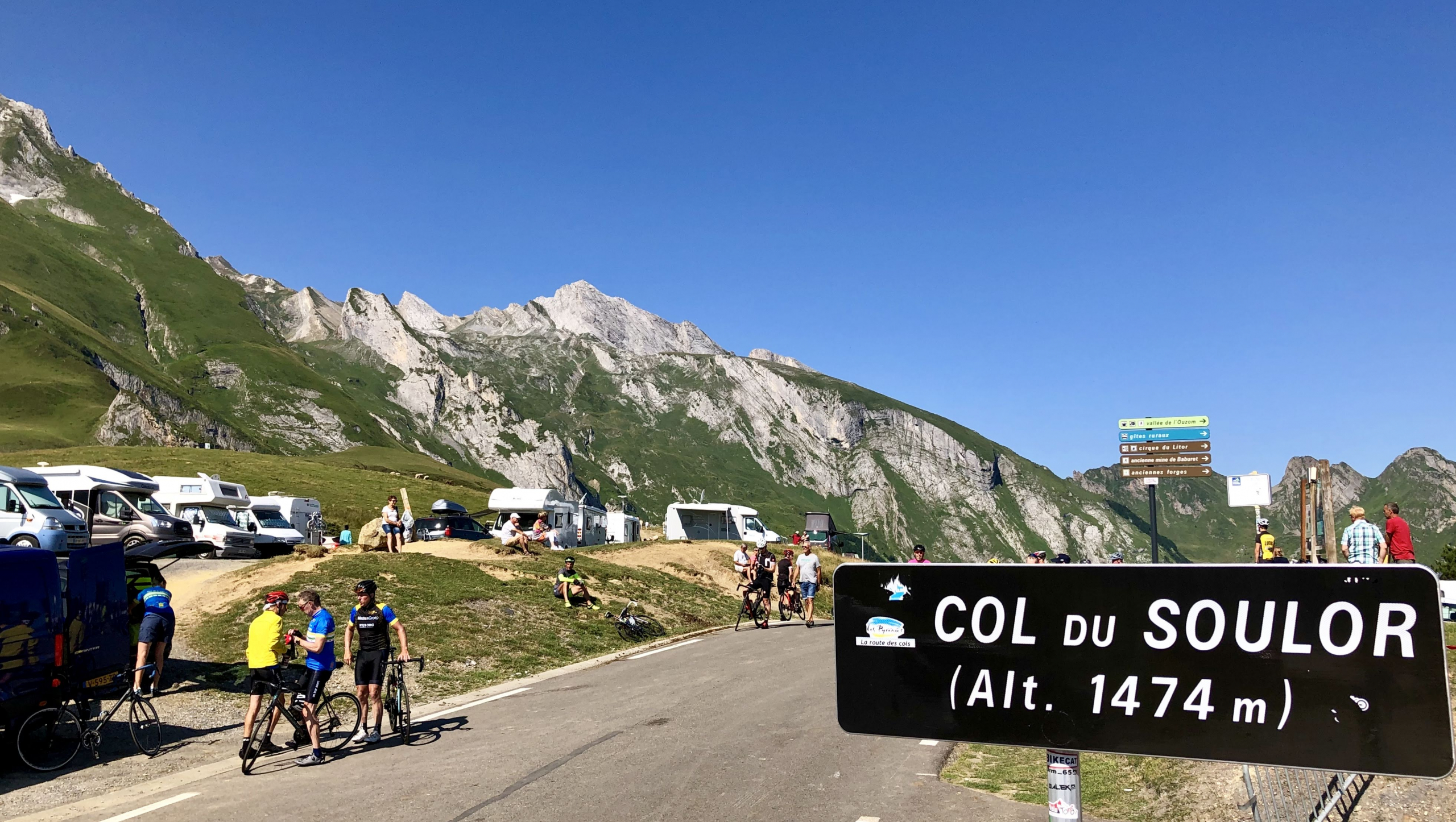
Col d’Aubisque via Col du Soulor
- Overall Ride Distance (out and back): 60km
- Overall Ride Vertical climbing: 1850m
- Climb Rating: Hors Category (HC)
- Climb Overall (Col d’Aubisque via Col du Soulor): 30km – 1550m
- Undulating Climbing: 4.1% average
- Col du Soulor: 19km – 1050m climbing
- Col d’Aubisque: 11km – 500m climbing
Did you know that Alberto Elli from Italy won Stage 16 of the 1999 Tour de France over the Col de Peyresourde? Alberto’s a fantastic guy, he’s relaxed yet still super strong on the bike, he’s also one of our great Super Domestic tour hosts.
Introduced into the Tour de France in 1910, the Col d’Aubisque route is a Pyrenean must-try ride, it’ll also help you to understand why numerous cyclists prefer the Pyrenees over the French Alps. It’s a challenging route with no flat terrain. Still, the entire route is amazing as it captures the essence of the Pyrenees Mountains.
The first 15km requires some climbing through the hills and meadows, an authentic green French paradise. You will then move past the gushing streams and glades, climbing through the isolated Pyrenean valley and towns of the Gave d’Ossau. Kilometres 4 to 38 make up the final portion of the 2018 Tour de France Stage 19.
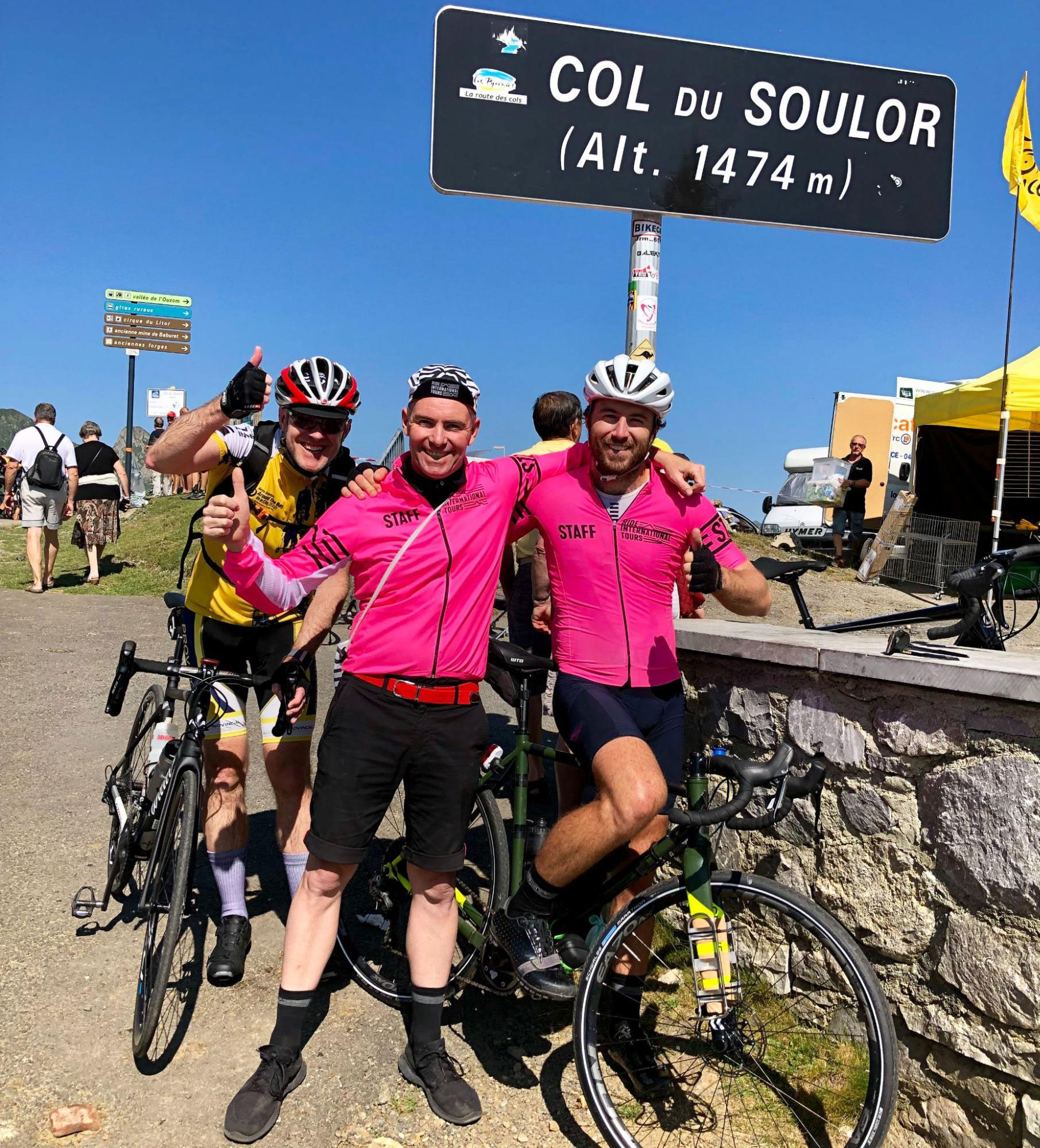
The climb is undisputed, and it’s hard to do it justice with just some photos. But be sure you don’t miss the opportunity to take a selfie in front of the Col du Soulor signboard, as well as with the massive steel bike sculptures at the top of the Col d’Aubisque.
While on the topic of things you mustn’t miss, here are some suggestions that are sure to satisfy your caloric requirements:
- Sip on morning tea or enjoy a coffee and a snack at the top of Col du Soulor
- For lunch, try the Col du Peyresourde Chalet menu, specifically the Confit du Canard with roast potatoes. The locals stand by the deliciousness of the homemade tarte, so we recommend trying it as well.
- Delight in afternoon tea, coffee, or ice cream in the Hautes-Pyrenees commune of Argelès-Gazost.
And if you think you’ve seen it all, the glorious route traversing across Col d’Aubisque on the Cirque du Litor is perhaps the most stunning and one of the best roads we’ve ever seen. But don’t take our word for it. Ride it to believe.
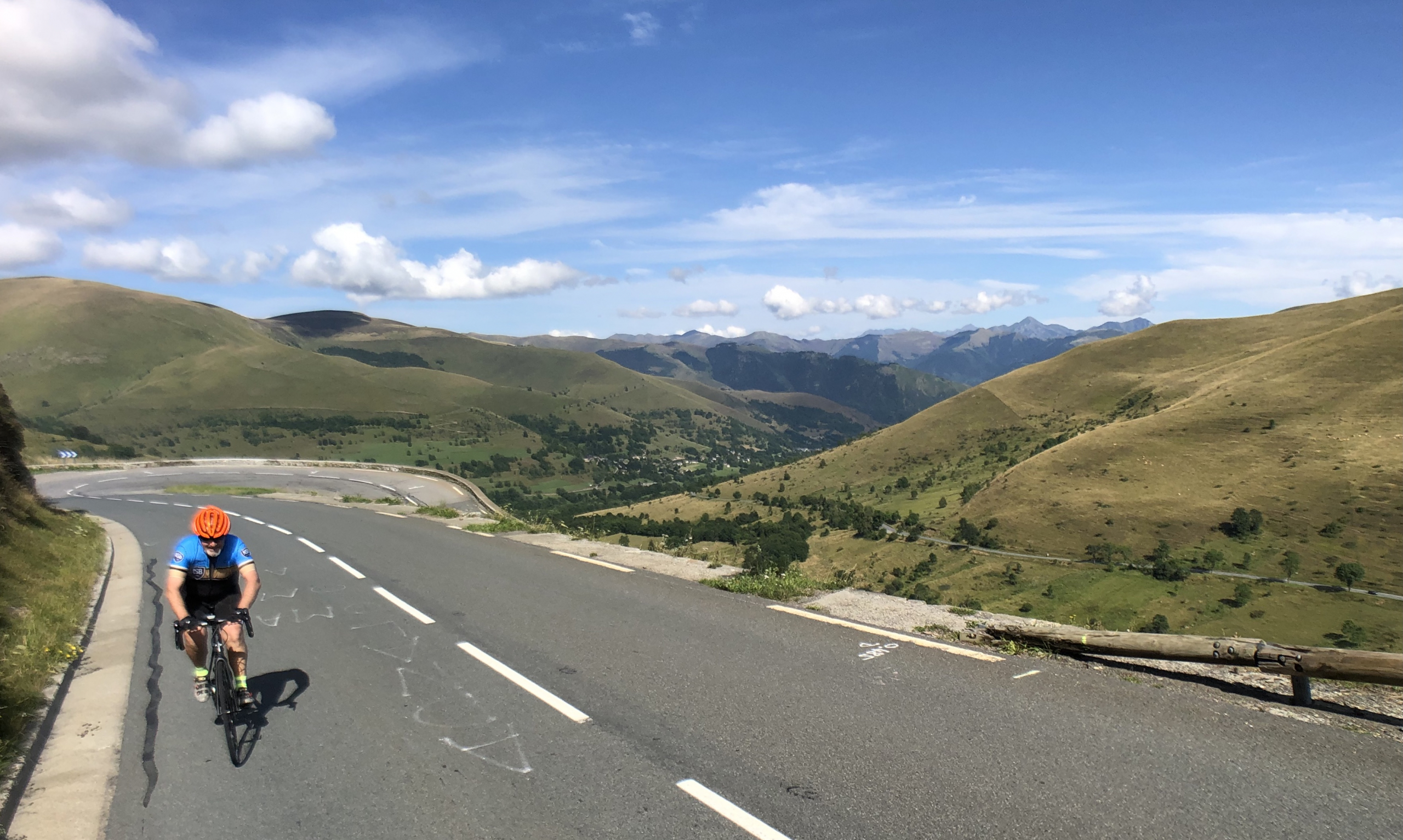
Port de Balès to Col de Peyresourde – Pla d’Adet
- Distance: 95km
- Vertical climbing: 3850m
This course is similar to the final portion of Stage 17 of Tour de France 2021, running deep into the border region of the French Pyrenees. Don’t miss Port de Bales. You’ll most likely spot some Pyrenean eagles once you get to the top of the climb. Le Pla d’Adet, as we have mentioned, was where Phil Anderson’s historic day took place. The ski resort area of Le Pla d’Adet and Saint-Lary, has hosted Tour de France stage finishes on 10 occasions.
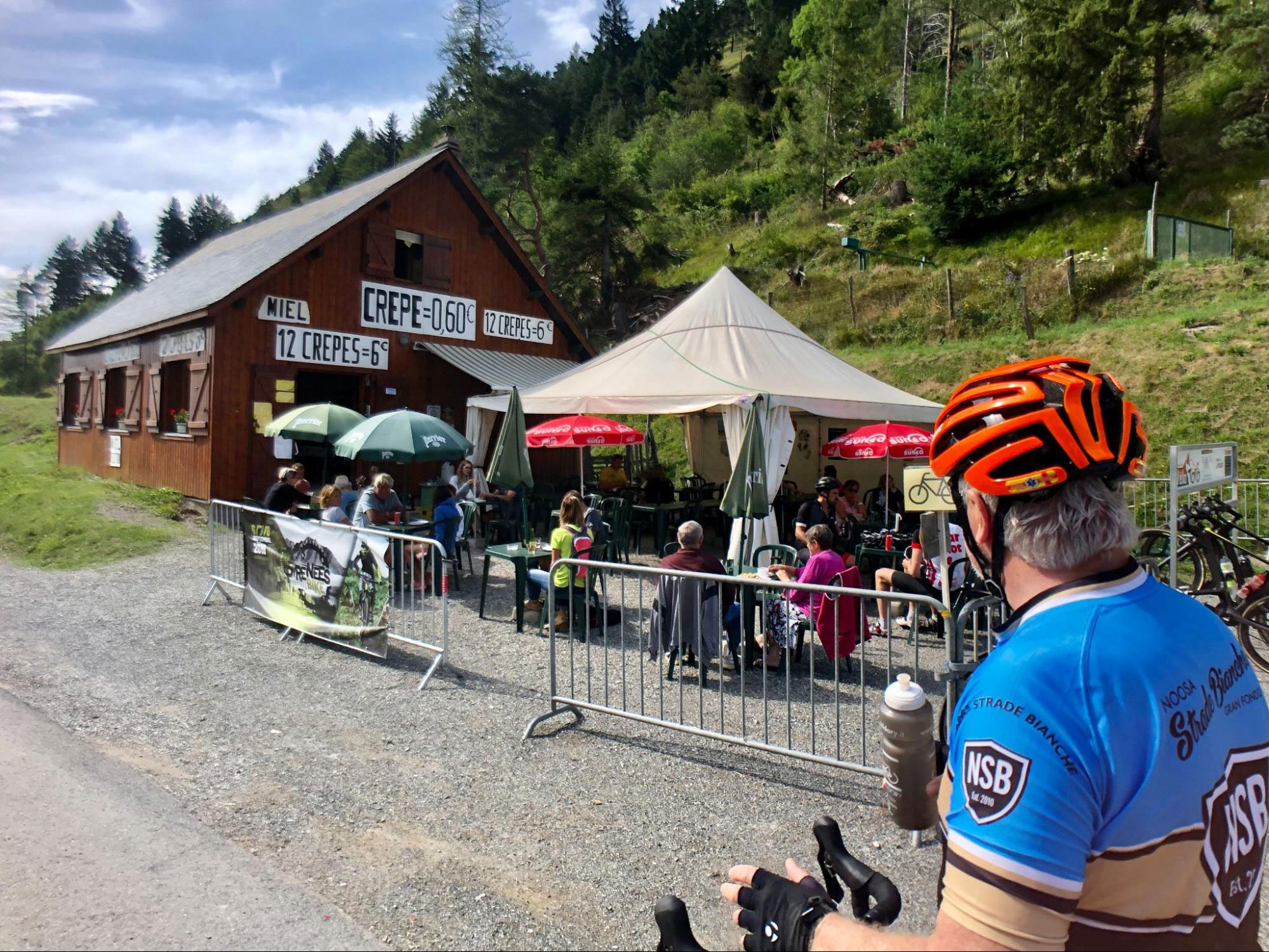
Crepes are a French must-try, enjoy one at the Chalet’s cafe while at the top of Col de Peyresourde. They’re not only delicious, but you’ll get the fuel you need to keep you going.
Let’s also not forget that the ski station and mountain altiport served as the filming locations for the hit 1997 Pierce Brosnan – James Bond movie, Tomorrow Never Dies . And 20 years later, it was also the Tour de France 2017’s Stage 12 finish.
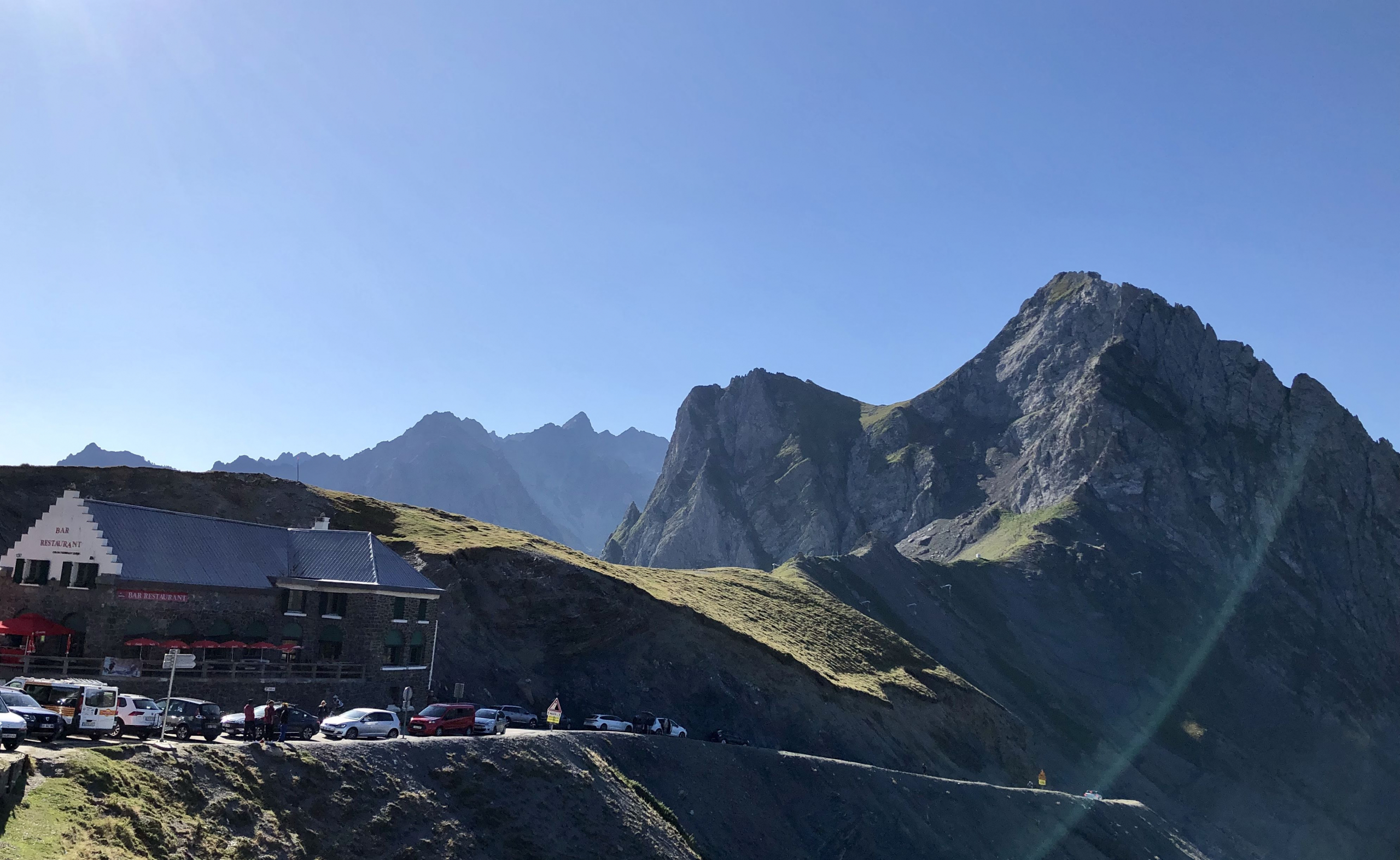
Col du Tourmalet Loop
- Ride Distance: 105km
- Vertical climbing: 2200m
- Col du Tourmalet: 17.5km
- Elevation Gain: 1275m
- Elevation or Altitude at Top: 2115m
- Average Climbing Gradient 7.5%
- Max Climbing Gradient 10%
When speaking about the Pyrenees and Tour de France, Col du Tourmalet will always be a classic route. So, if you’re an avid cyclist, you should definitely have this on your bucket list. A significant portion of the 2021 Tour de France Stage 18, in particular the last 70km of the stage follows much of this big mountain route.
At 2,115m, Col du Tourmalet is one of the highest road passes in the Pyrenees mountain range. We’re highlighting the loop ride, which is remarkable and unforgettable for any cyclist. It begins with an easy 11km, serving as your warm-up and will pass the rolling countryside for the next 70km. And when it’s sunny or clear sky’s, you might spot the Pyrenean bearded vulture or lammergeier (Scientific name: Gypaetus barbatus). It’s easy to spot with its huge wingspan that can reach 2.9 metres or 9.3 feet.
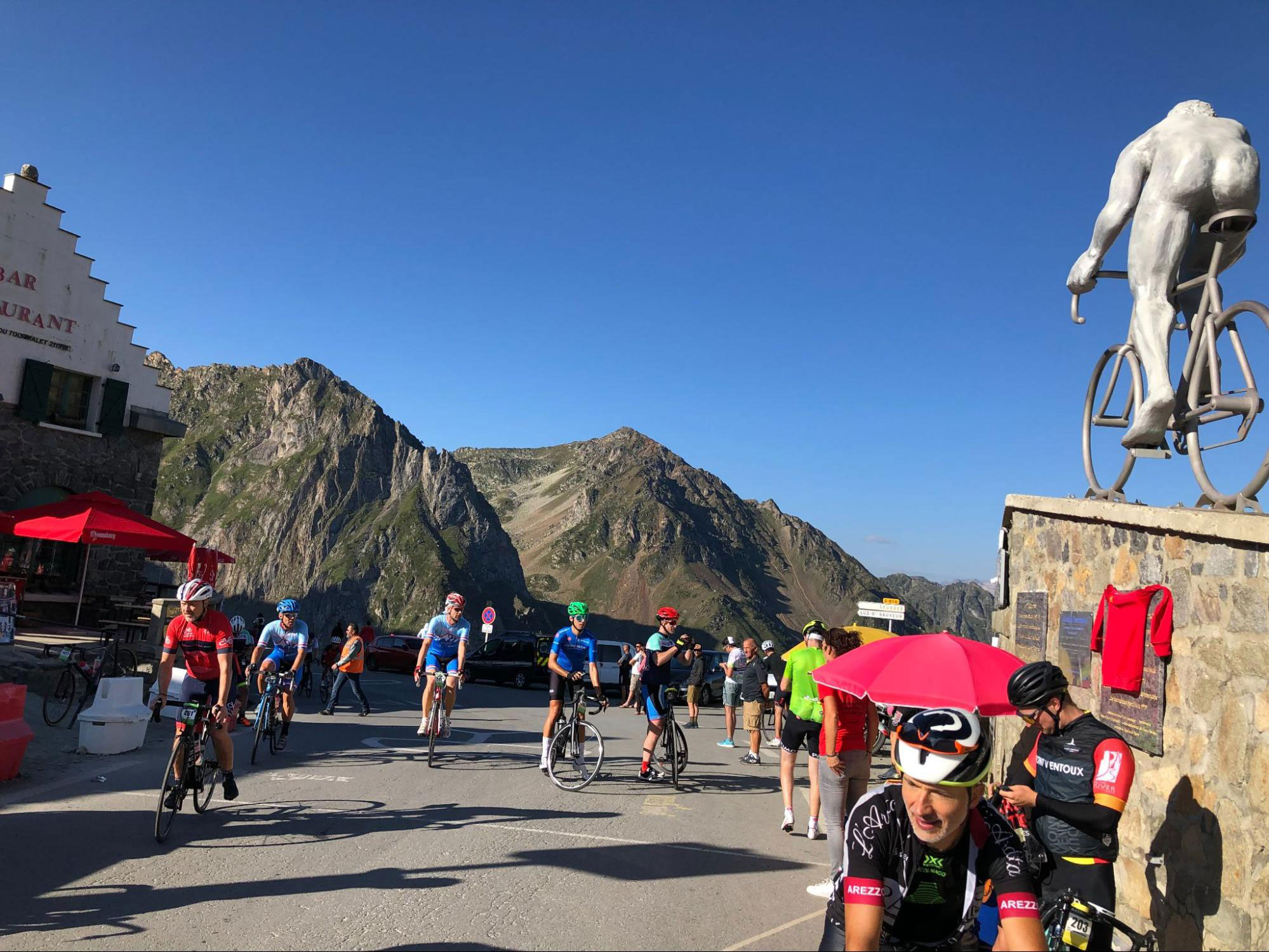
The village of Sainte Marie de Campan enroute to the Col du Tourmalet featured an old metal forge, which has become a historical monument for the Tour de France. In 1913, Le Vieux Gaulois (the Old Gaul) Eugène Christophe, a renowned cyclist, repaired his broken bicycle in this area after descending the Tourmalet. Because part of the rules of the race was not to get assistance, he had to do it all by himself, causing him to walk 15km for the repairs. Although the incident cost him his victory, this moment did not go unnoticed. The plaque or monument commemorates his efforts to bring his bike back to life.
Now, if you’re looking to re-energise yourself, enjoy a cup of coffee or a hot chocolate at the mountaintop chalet at the Col du Tourmalet.
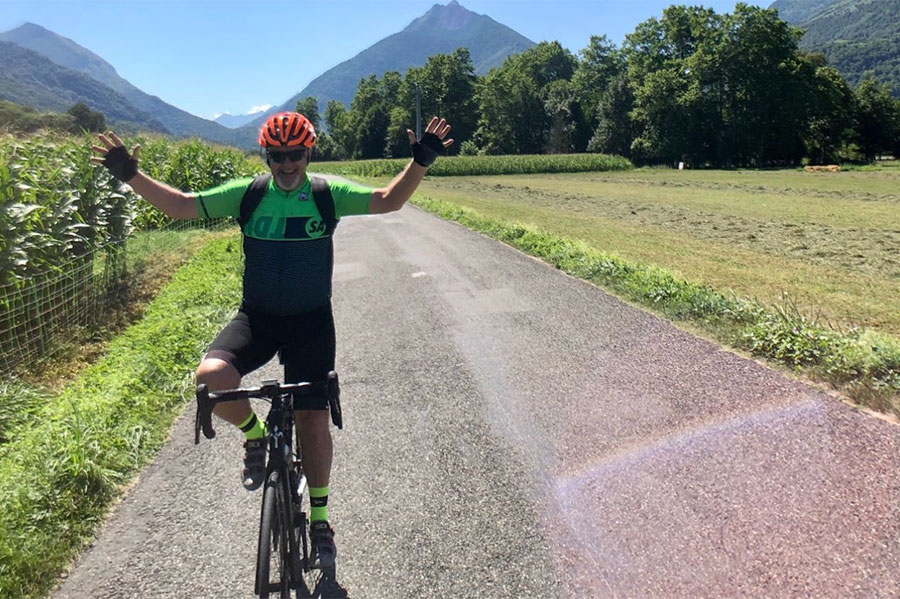
Hautacam & Luz Ardiden
- Ride Distance: 95km
- Vertical Climbing: 2800m
Luz Ardiden Climb
- Height: 1720m
- Length: 14.7km
- 1,010m climbing
- Average Gradient: 6.9%
- Maximum Gradient: 10%.
Hautacam Climb
- Height: 1,635m
- Length:17.3km
- 1,170m climbing
- Average Gradient: 6.8%
Are you looking to achieve two climbs with just one ride? Here’s the answer. Luz Ardiden and Hautacam are classic Tour de France climbs in the summer and ski resorts in the winter. Luz Ardiden may be where the Tour de France winner of 2021 will be declared. The location is set to be the final climb for the Pyrenean Mountain stages this year.
It won’t be the first time Luz Ardiden is a part of the Tour de France. It has been a part of the event since 1985, while Hautacam has been used five times starting in 1995. Hautacam has always been deemed the harder of the two, especially when getting into a rhythm, despite what statistics say. Nevertheless, both climbs will reward you with gorgeous sights of the Pyrenees Mountains from the beginning of the route until you reach the mountain tops.
Don’t miss Napoleon Bridge at Luz Saint Sauveur, which Napoleon III inaugurated in 1863. The area is right at the foot of Luz Ardiden. When you get to Luz Saint Sauveur, take the chance to try the local artisan beers at Brasserie du Pays Toy. It’s a popular microbrewery that features four craft beers, including Cuvée du Col du Tourmalet (Amber Beer).

Lourdes, The Locals Loop
- Ride Distance: 65km
- Vertical Climbing: 1000m
Did you know that the town of Lourdes has the greatest number of hotel beds in the country of France outside of Paris? After all, it receives well over six million people from around the world annually. Some points of interest are Lake Lourdes and Grottes (Caves) de Bétharram.
See the town of Lourdes like a local through this “local training route.” It follows a small road with a number of bodies of water and valleys before you climb up the hills to reach the views back down over Lourdes. Upon getting there, we highly recommend that you don’t miss the beautiful views over the town and up to the Pyrenees. Once you’re ready to return, take the “secret” local route, along Lake Lourdes.
Enjoy a cup of coffee or sit down for lunch while sipping on a cool drink – all while admiring the serene views that the lake offers. For some lunch options by Lac de Lourdes, sample the plat du jour dishes (Plate of the Day) at the restaurant café. And you know you can never go wrong with grilled salmon paired with fresh salad.
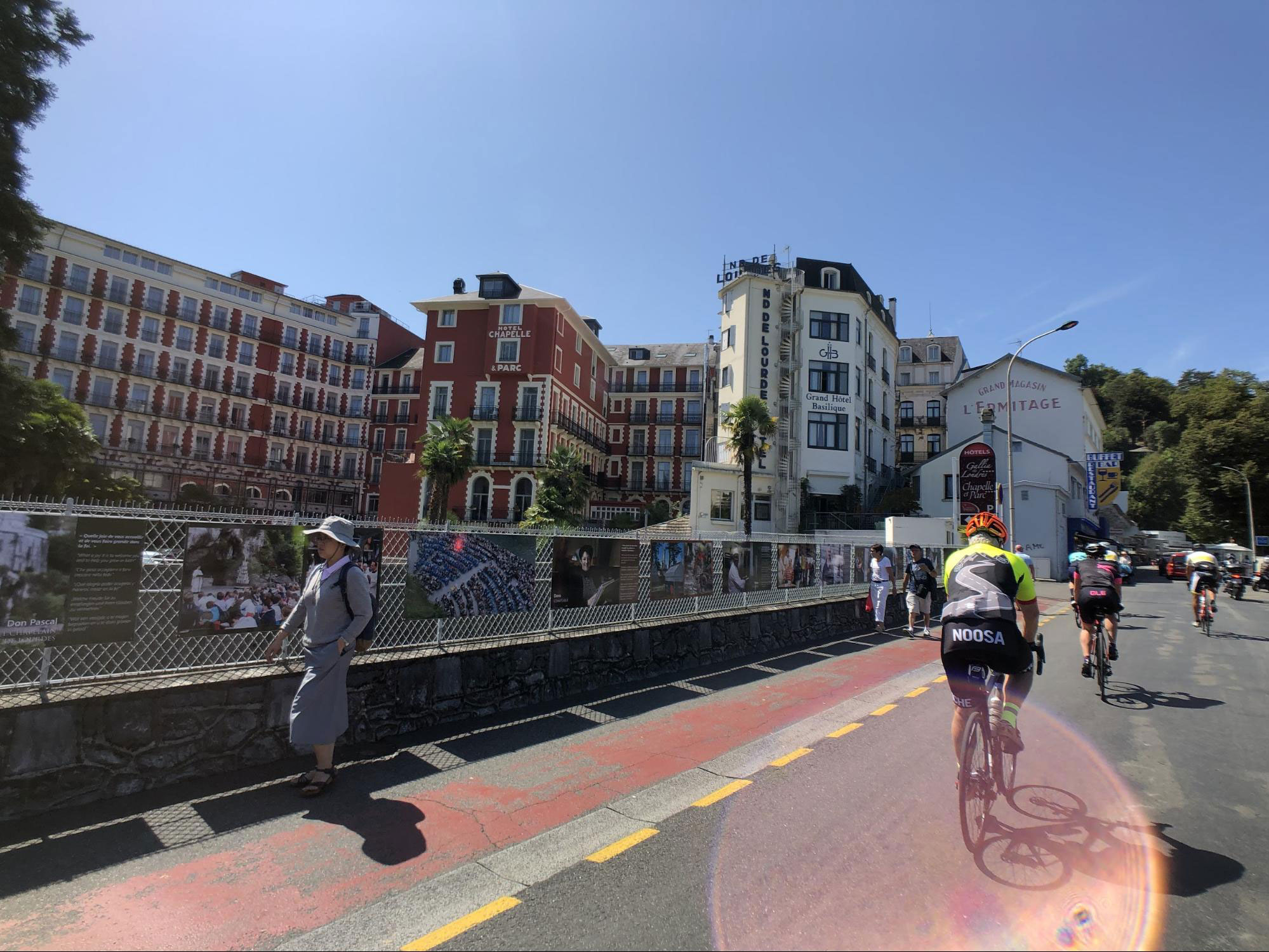
Once you’re recharged, it’s time to head to the Grottes (Caves) de Bétharram. These underground caves have welcomed visitors for more than a century now.
And that’s it! We’ve covered five of the most spectacular and iconic climbs shaping the Pyrenees Mountains – Tour de France experience.
Ready to Explore France?
Are you excited to explore France or the Tour de France more? You could be cycling through France in summer enjoying the amazing culture, food and wine experiences, seeing the Tour de France and challenging yourself on the beautiful rides on this list!
We’re taking bookings for our 2022 Ultimate Tour de France , 2023 Ultimate Tour de France and Pyrenees Signature tours . For more information, contact us below.
Feeling Hungry?
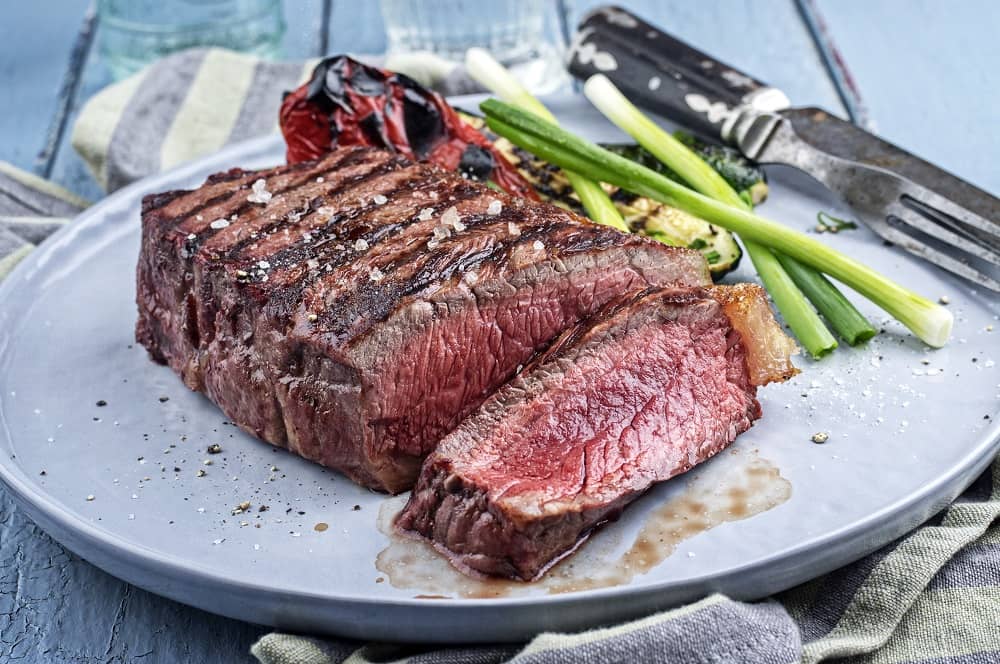
Take a look at our 7 Favourite French Foods here
Follow Us On Instagram

join the FeedStation newsletter
We won’t over feed your email inbox. But we will keep it hydrated.
Newsletter Subscription

We are a passionate family business that prides itself on hosting exceptional cycling vacations since 2007.
Whether it’s your first time cycling abroad, or you’re an experienced rouleur, our team takes care of all the details on and off the bike to create wonderful travel experiences.
- FeedStation
- Term & Conditions
- Tour Down Under
- Giro d’Italia
- Tour de France
- Tour of Spain
- Spring Classics
- French Pyrenees Tour
P: 1300 140 311

Official games

2023 Edition
- Stage winners
- All the videos
Tour Culture
- Commitments
- key figures
- Sporting Stakes
"Maillot Jaune" Collection
- The jerseys

Plan your visit to the Tour de France
Vote now for best krys white jersey victory.

JUNE ON WHEELS FOR SCHOOLS

Discover all the details of the Tour de France 2024

2023 rankings

Stage 1 | 06/29 Florence > Rimini
Stage 2 | 06/30 cesenatico > bologne, stage 3 | 07/01 plaisance > turin, stage 4 | 07/02 pinerolo > valloire, stage 5 | 07/03 saint-jean-de-maurienne > saint-vulbas, stage 6 | 07/04 mâcon > dijon, stage 7 | 07/05 nuits-saint-georges > gevrey-chambertin, stage 8 | 07/06 semur-en-auxois > colombey-les-deux-églises, stage 9 | 07/07 troyes > troyes, rest | 07/08 orléans, stage 10 | 07/09 orléans > saint-amand-montrond, stage 11 | 07/10 évaux-les-bains > le lioran, stage 12 | 07/11 aurillac > villeneuve-sur-lot, stage 13 | 07/12 agen > pau, stage 14 | 07/13 pau > saint-lary-soulan pla d'adet, stage 15 | 07/14 loudenvielle > plateau de beille, rest | 07/15 gruissan, stage 16 | 07/16 gruissan > nîmes, stage 17 | 07/17 saint-paul-trois-châteaux > superdévoluy, stage 18 | 07/18 gap > barcelonnette, stage 19 | 07/19 embrun > isola 2000, stage 20 | 07/20 nice > col de la couillole, stage 21 | 07/21 monaco > nice, tour culture, grand départ florence émilie-romagne 2024, grand départ lille-nord de france 2025, 2024 tour de france finale in nice, riding into the future, all the news, official tour operators, history of tour de france, accessories.
Receive exclusive news about the Tour
General Ranking
> Withdrawals

Accreditations
Privacy policy, your gdpr rights.
Tour de Suisse stage 1 Live - An early test against the clock
As it happened: roglič takes the title despite major crisis as rodríguez wins stage, tour de france 2024 - stage 18 preview.
July 18, 2024: Gap - Barcelonnette, 179.6km
Stage 18 Sprints
Stage 18 mountains.
Stage 18 from Gap to Barcelonnette will be one for the breakaway and should offer a slight reprieve from the high mountains. The up-and-down route with 3,100 metres of elevation gain includes the Col du Festre (3.9km at 6.3%), the Côte de Corps (2.1km at 7.2%) and the Col de Manse (5.1km at 3.6%).
A strong puncheur might be able to go clear on the Côte de Saint-Apollinaire (7km at 5.5%) with 58 kilometres to go and will have even more opportunity to do so on the Côte des Demoiselles Coiffées (3.6km at 5.4%) with 40 kilometres to go.
- Intermediate sprint, km 84.3
- Col du Festre (3.9km at 6.3%), cat. 3, km 32.2
- Côte de Corps (2.1km at 7.2%), cat. 3, km 57.5
- Col de Manse (5.1km at 3.6%), cat. 3, km 97.3
- Côte de Saint-Apollinaire (7km at 5.5%), cat. 3, km 121
- Côte des Demoiselles Coiffées (3.6km at 5.4%), cat. 3, km 139.1

Thank you for reading 5 articles in the past 30 days*
Join now for unlimited access
Enjoy your first month for just £1 / $1 / €1
*Read any 5 articles for free in each 30-day period, this automatically resets
After your trial you will be billed £4.99 $7.99 €5.99 per month, cancel anytime. Or sign up for one year for just £49 $79 €59
Try your first month for just £1 / $1 / €1
Get The Leadout Newsletter
The latest race content, interviews, features, reviews and expert buying guides, direct to your inbox!
Kirsten Frattini is the Deputy Editor of Cyclingnews , overseeing the global racing content plan.
Kirsten has a background in Kinesiology and Health Science. She has been involved in cycling from the community and grassroots level to professional cycling's biggest races, reporting on the WorldTour, Spring Classics, Tours de France, World Championships and Olympic Games.
She began her sports journalism career with Cyclingnews as a North American Correspondent in 2006. In 2018, Kirsten became Women's Editor – overseeing the content strategy, race coverage and growth of women's professional cycling – before becoming Deputy Editor in 2023.
2024 Tour de Suisse – Analysing the contenders
Tour of Britain Women 2024 - Analysing the Contenders
ZLM Tour: Herregodts wins overall after leading race from start to finish
Most popular, latest on cyclingnews.
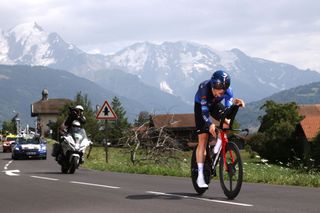
Lotte Kopecky wins Tour of Britain Women as Roseman-Gannon takes final stage

Tom Pidcock to Tackle Crans-Montana World Cup Just Six Days Before Tour de France
A mountain bike race isn’t a typical prep for a 21-day stage race, but the British rider is confident in his plan leading up to the Tour and Paris Olympics.

And his calendar doesn’t end there. He will follow the Tour with an attempt to defend his gold medal at the Paris Olympic Games.
Despite his recent focus on mountain biking, Pidcock says training for World Cup racing and WorldTour racing overlap. According to GCN , he said, “I don't train on my mountain bike as much as I should, but [road and mountain bikes] are quite interchangeable. Of course, now, this time of year, I’m doing longer efforts in preparation for the Tour, more volume. But they all complement each other.”

If Pidcock is anything, it’s versatile. He won the Shimano Supercup Massi in La Nucía, Spain, in February, and then in April, took the top step at Amstel Gold. There, he narrowly beat Marc Hirschi (UAE Team Emirates) and Tiesj Benoot (Visma-Lease a Bike) with an exciting sprint finish.
At the Tour de France, Pidcock will be a team leader for INEOS Grenadiers alongside Carlos Rodríguez. This will be a familiar dynamic from last year when Rodríguez won a stage and finished fifth overall. Pidcock was 13th overall after faltering a bit in the second week.
According to GCN , Pidcock’s coach has challenged him to finish inside the top five in the GC at the Tour and to take a stage win. These are lofty goals for anyone this year, with Tadej Pogačar (UAE Team Emirates), Primož Roglič (Bora-Hansgrohe), and Remco Evenepoel (Soudal Quick-Step) all confirmed to race, not to mention the still undecided Jonas Vingegaard (Visma-Lease a Bike).
Micah Ling is a freelance writer who lives in the mountains of Colorado. She splits her free time between mountain biking and trail running.

.css-1t6om3g:before{width:1.75rem;height:1.75rem;margin:0 0.625rem -0.125rem 0;content:'';display:inline-block;-webkit-background-size:1.25rem;background-size:1.25rem;background-color:#F8D811;color:#000;background-repeat:no-repeat;-webkit-background-position:center;background-position:center;}.loaded .css-1t6om3g:before{background-image:url(/_assets/design-tokens/bicycling/static/images/chevron-design-element.c42d609.svg);} Tour de France

Van der Poel Opts Out of Olympic Mountain Biking

Vingegaard Still May Not Be Tour de France Ready
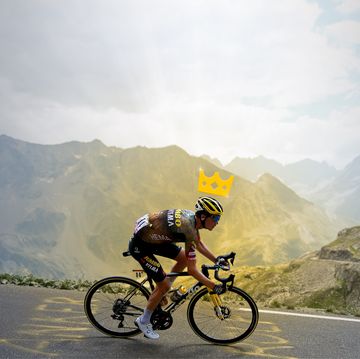
The Kings and Queens of Cycling’s Iconic Climbs
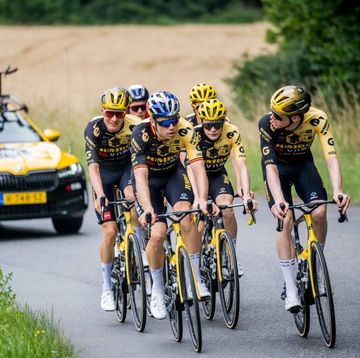
How Pros Tackle Recovery During Tour de France
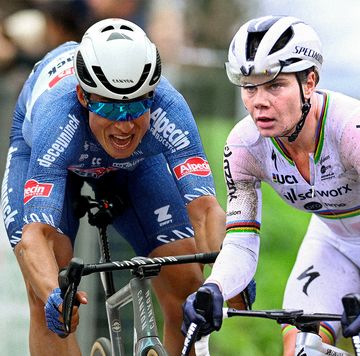
The Fastest Men and Women of the Grand Tours
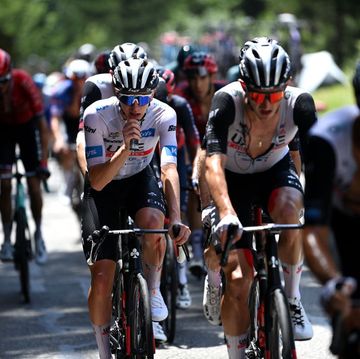
What Do Riders Eat During the Tour de France?

How Fast Do the Pros Ride in the Tour de France?

Challengers of the 2024 Giro d'Italia and TdF
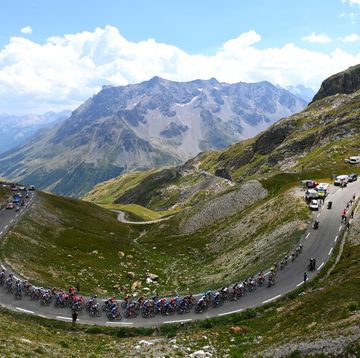
2024 Tour de France May Start Using Drones
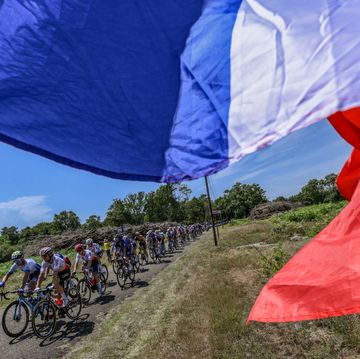
The 2024 Tour de France Can’t Miss Stages

Riders Weigh In on the Tour de France Routes

COMMENTS
The 2014 Tour de France includes 25 climbs ranked Category 2 or higher of which six are Hors catégorie climbs, eleven Category 1 and eight are Second Category. There are seven "mountain top" finishes: at La Mauselaine (Category 3) and La Planche des Belles Filles in the Vosges, Chamrousse and Risoul in the Alps, and Saint-Lary Pla d'Adet and ...
The Col du Mollard is a mountain pass in the French Alps. It is located in the Savoie department, between the villages of Saint-Jean-de-Maurienne and Mont-de-Lans. The col du Mollard is one of the most famous mountain passes of Le Tour de France because it has been used many times in the race, most recently in 2013.
The mountains classification is a secondary competition in the Tour de France, that started in 1933.It is given to the rider that gains the most points for reaching mountain summits first. The leader of the classification is named the King of the Mountains, and since 1975 wears the polka dot jersey (French: maillot à pois rouges), a white jersey with red polka dots.
The Tour de France included Mont Ventoux in 16 stages between 1951 and 2016, and it has been the finish on 10 of those, most recently in 2016 (as of 2020). "Mont Ventoux has become legendary as the scene of one of the most grueling climbs in the Tour de France bicycle race, which has ascended the mountain fifteen times since 1951.
Col du Platzerwasel - Stage 20. The 2023 Tour de France saves its final mountainous punch for Stage 20, a short, explosive stage through the Vosges mountains with a total of 3,600m of elevation ...
Le Portet d'Aspin (1,489 metres) Like Tourmalet, le Col d'Aspin is a real classic for the Tour de France, which has climbed it 71 times. Thomas Voeckler was the last to conquer it in the lead, during the 16th stage of the 2012 Tour de France (Pau / Bagnères-de-Luchon), a race he went on to win after leading the day's four challenges (Aubisque, Tourmalet, Aspin and Peyresourde).
What is the highest mountain of Tour de France 2023? There are eight mountain stages lined up for 2023 as the Tour visits all five of France's mountain massifs — the Pyrenees, the Massif Central ...
Reading time: 7 min Published on 4 December 2023, updated on 1 June 2024. The most famous cycle race in the world, the Tour de France will be taking to the skies once again this year, as the 3,404km and 21 stages will take in all 5 of France's mountain ranges! The Pyrenees, the Auvergne volcanoes, the Jura mountains, the Alps and the Vosges ...
The mountains classification is always a great attraction of the Tour de France, especially when the fight for the general classification is not entertaining or exciting deep into the race. In this article, we will take a closer look at 2022 edition's scoring system, the tactics for winning it and who the favourites.
Puy-de-Dôme. The best known of the Auvergne mountains, located in the Monts Dômes, is the Puy-de-Dôme, first used by the Tour in 1952, but not included on the route since 1988 because of the unsuitability of the road that winds its way to the top. At just four miles long and a bit too narrow for comfort, the road is considered unsafe to ...
The Tour goes above 2000m on the Galibier on stage 4 and the Tourmalet on stage 14, but stage 19 is 'the altitude stage' of the 2024 Tour. The Col de Vars takes us to 2109m with an 18.8km climb at an average gradient of 5.7% that's heavily mitigated by a 3km plateau in the middle.
The mountains classification is the second-oldest jersey awarding classification in the Tour de France. The mountains classification was added to the Tour de France in the 1933 edition and was first won by Vicente Trueba. Prizes for the classification were first awarded in 1934. During stages of the race containing climbs, points are awarded to ...
The race in 2023 visits 5 of France's mountain ranges, the Pyrenees, Massif Central, the Jura, the Alps, and the Vosges. There are only 2 climbs over 2,000m in the 2023 Tour de France with the highest being Col de la Loze at 2,304m, followed by Col du Tourmalet at 2,115m. Col de la Loze is also the longest climb of the 2023 Tour de France at ...
Symbol of the mountains, of a rider pushing beyond their limits and of courage, the red polka dot jersey, which is sponsored by E.Leclerc, is awarded to the Tour de France's leader of the best climber classification.Although this classification was introduced in 1933, its symbol, the polka dot jersey, appeared in 1975, which was also the year the Tour first finished on the Champs-Élysées ...
Mont Ventoux always has a decisive role in the Tour's outcome, and that knowledge is intoxicating. There's never going to be an easy winner on its summit, and Ventoux always acts as the great stage on which the race's best cyclists are going to do battle. Great pictures are going to come from any ascent of this monster.
Its first appearance in 1986 was the highest mountain-top finish in Tour de France history (2413m), now only surpassed by the 2011 mountain-top finish on Galibier (2642m). Col du Granon.
4. Apennines (Italy), the Italian and French Alps, Massif Central and Pyrenees will be the mountain ranges on the 2024 Tour route.. 4. The number of countries visited in 2024: Italy, San Marino, Monaco and France. Within France, the race will pass through 7 Regions and 30 departments.
Mont Ventoux is iconic for its beauty, difficulty, and tragic history. The climb ascends about 13.3 miles with an average grade of 7.6% for a total elevation gain of more than 5,000 feet. The top ...
Stage 17 to Courchevel climbs the 2,304m-high Col de la Loze and then descends to finish on the altiport runway. Stage 20 is a final brutal multi-mountain stage in the Vosges between Belfort and ...
The Tour de France has been sparing in its visits to Mont Ventoux over the past 70 years, which has undoubtedly helped to preserve the mystique of the bald mountain. In that light, the double ...
Luz Ardiden and Hautacam are classic Tour de France climbs in the summer and ski resorts in the winter. Luz Ardiden may be where the Tour de France winner of 2021 will be declared. The location is set to be the final climb for the Pyrenean Mountain stages this year. It won't be the first time Luz Ardiden is a part of the Tour de France.
Tour de France 2024 - Official site of the famed race from the Tour de France. Includes route, riders, teams, and coverage of past Tours. Club 2024 route 2024 Teams 2023 Edition Rankings Stage winners All the videos. Grands départs Tour Culture news ...
Tour de France Memorial of Tom Simpson, who died near the summit during the 1967 Tour de France, aged 29. Mont Ventoux is the scene of one of the most grueling climbs in the Tour de France bicycle race, which has ascended the mountain eighteen times since 1951. The followed trail mostly passes through Bédoin. Its fame as a scene of great Tour ...
Tour de France 2024 - Stage 18 preview. Stage 18 from Gap to Barcelonnette will be one for the breakaway and should offer a slight reprieve from the high mountains. The up-and-down route with ...
The challenging mountain top finish up to Samoëns 1600 on stage 7 revealed all. ... The 24-year-old Belgian is confident that with three weeks still to go until the start of the Tour de France in ...
A mountain bike race isn't a typical prep for a 21-day stage race, but the British rider is confident in his plan leading up to the Tour and Paris Olympics. ... At the Tour de France, Pidcock ...
Cycling · Cavendish delays retirement to target Tour record · GB's Richards wins at Mountain Bike World Cup · GB's Georgi fourth in European women's road race.